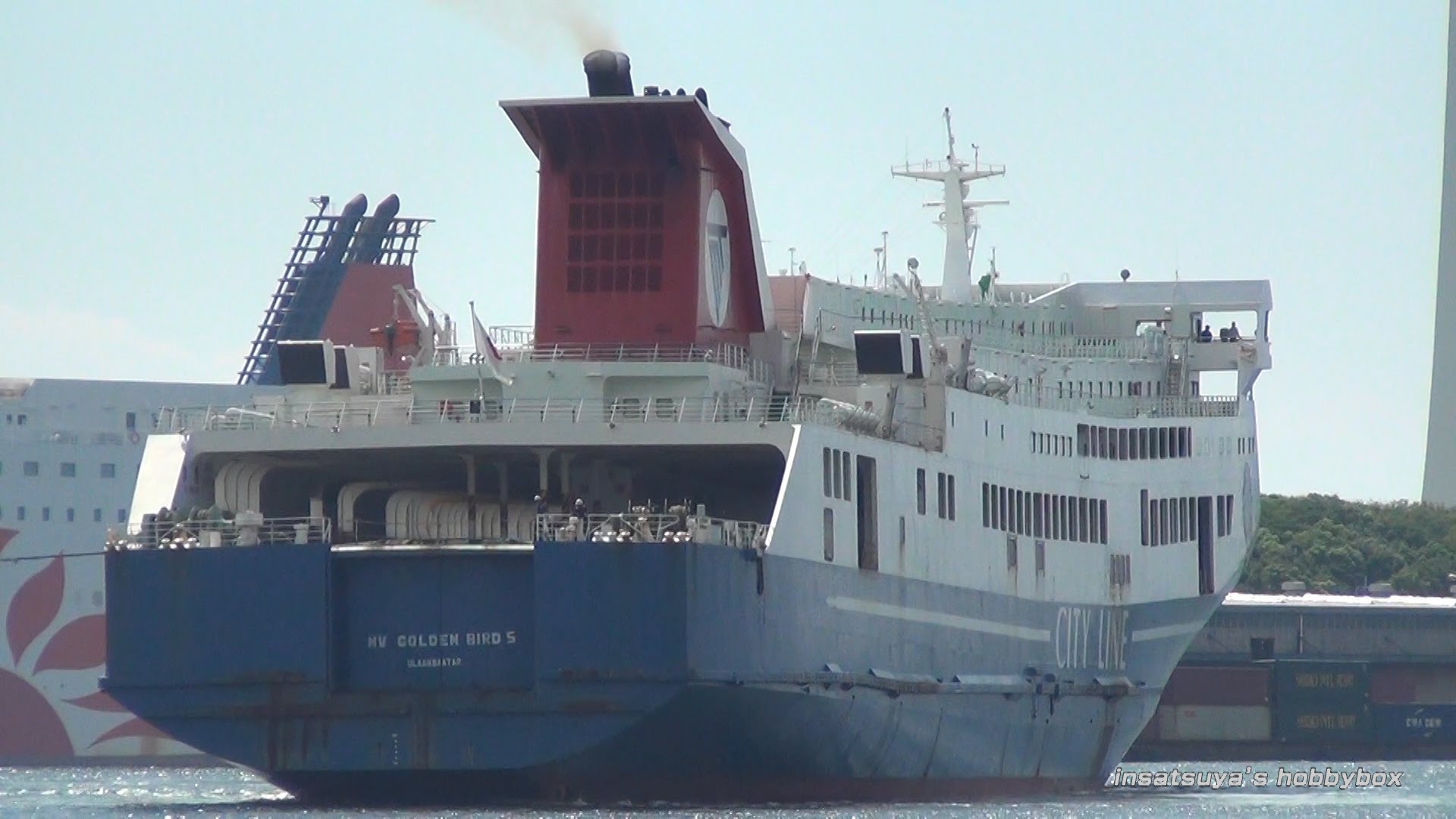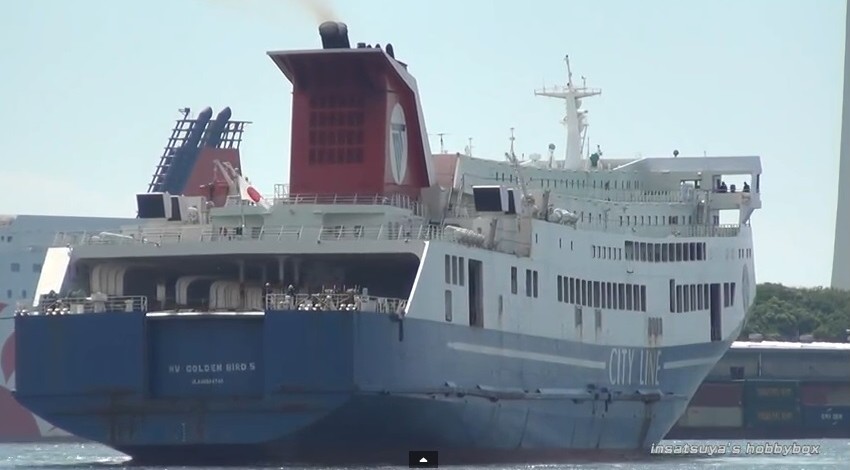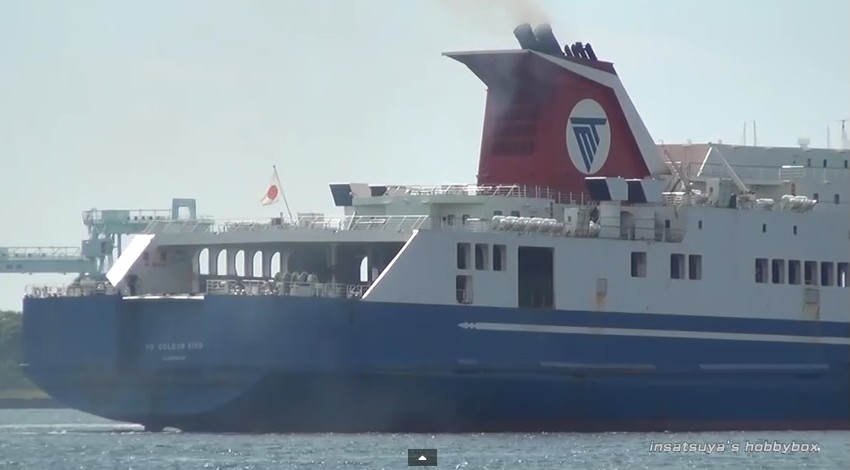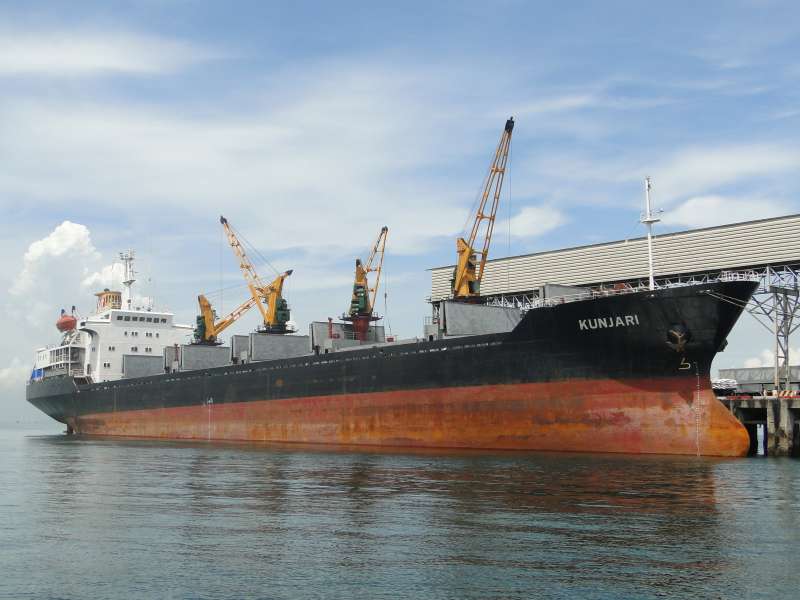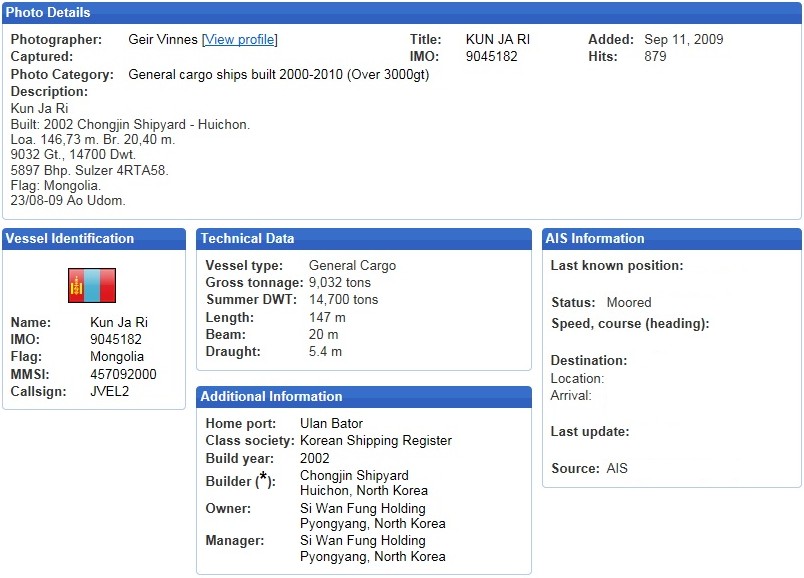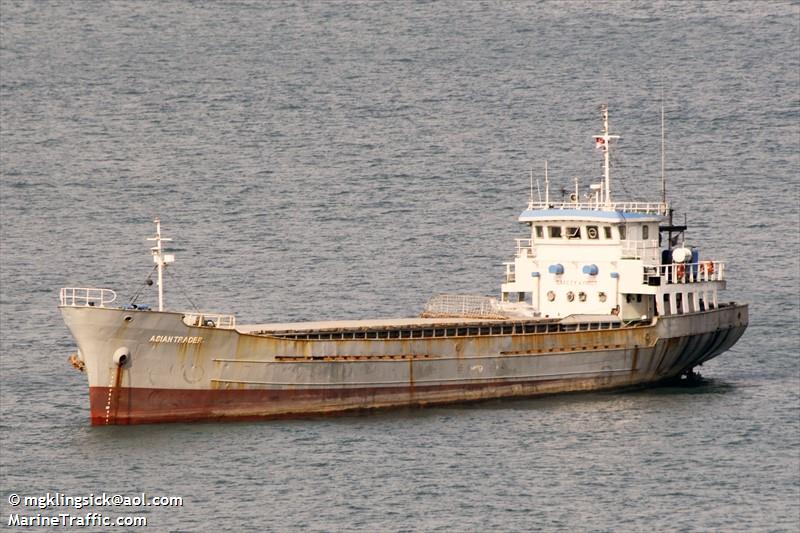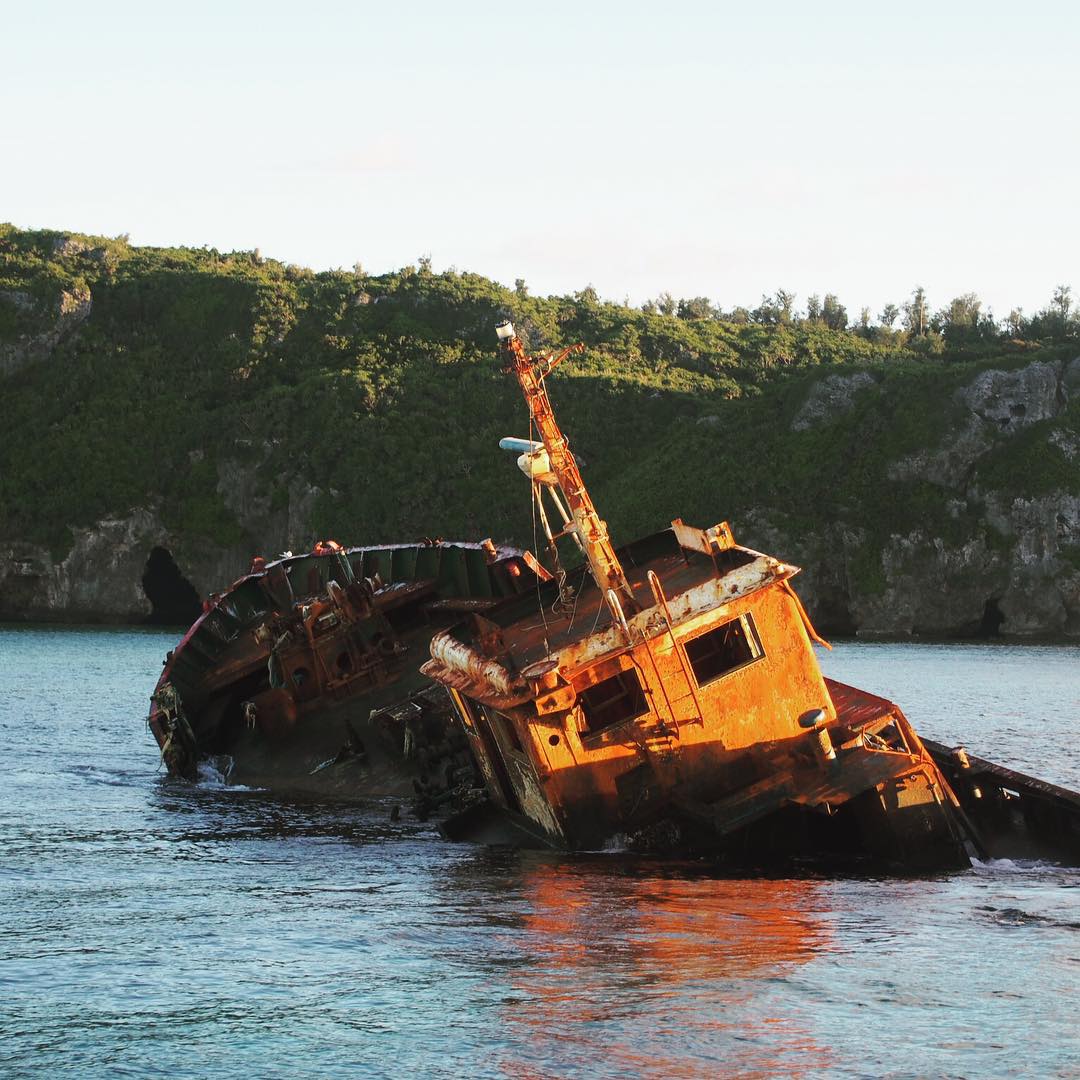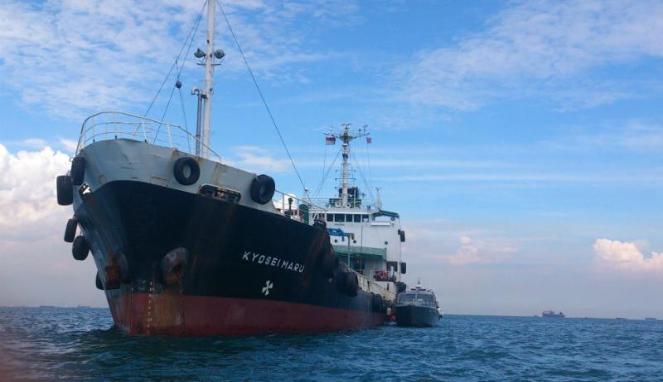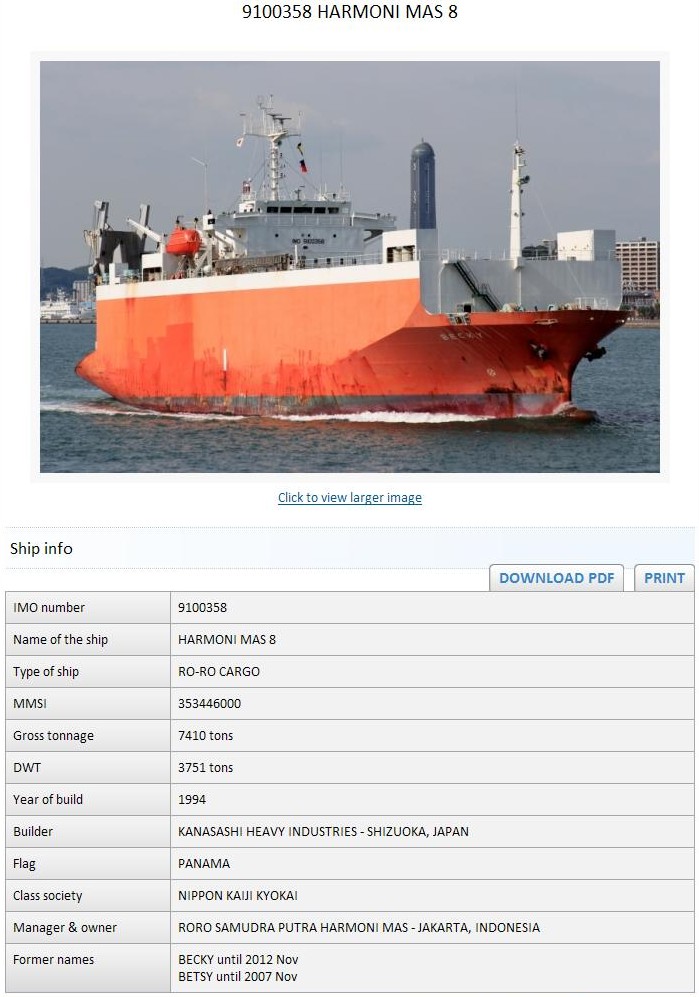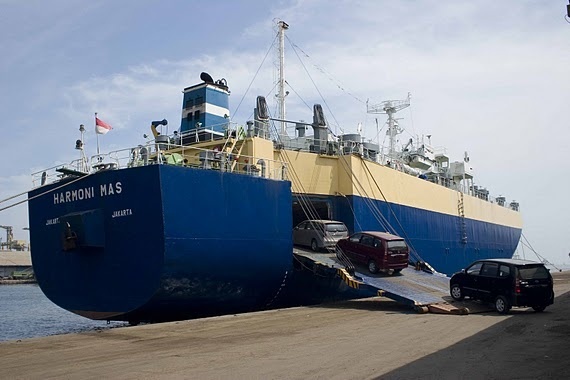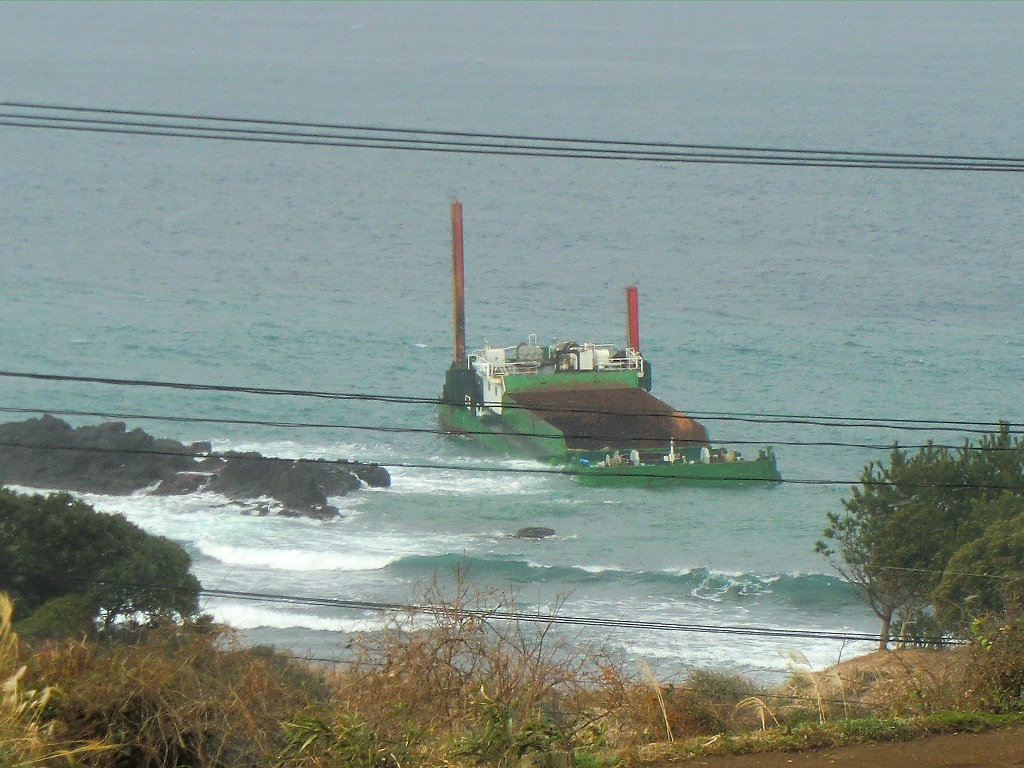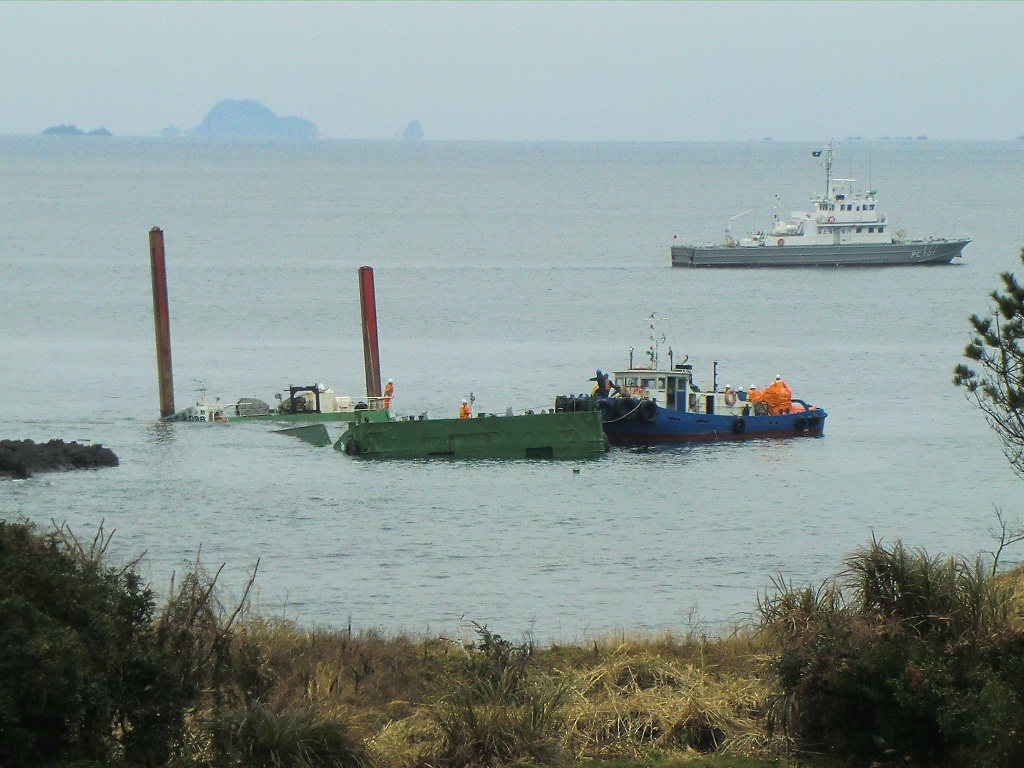モンゴル船籍 (Mongolia Flag)
UNDER-PERFORMING SHIPS (1年間に3回以上出港停止を受けた船舶) TOKYO MOUのHPより
Flag of convenience (便宜置籍船)(Wikipedia)
★中国から違法船続々! ★問題船は週末や夜に入港する ★無国籍船&幽霊船情報 ★元日本籍内航船サブスタンダード船
 フィリピンでの船舶による油流出事故
フィリピンでの船舶による油流出事故
 ソーラー1(Solar 1)フィリピンで沈没!
ソーラー1(Solar 1)フィリピンで沈没!
 パナマ船籍の「マリナ アイリス」が沈没!
パナマ船籍の「マリナ アイリス」が沈没!
★船員免状の偽造及び問題
 韓国客船 Sewol沈没
◆海難情報!
◆海難2
◆海難3
◆海難4
◆海難5
◆海難6
◆海難7
◆海難8
★船舶保険
韓国客船 Sewol沈没
◆海難情報!
◆海難2
◆海難3
◆海難4
◆海難5
◆海難6
◆海難7
◆海難8
★船舶保険
 カンボジア籍船
カンボジア籍船
 トーゴ籍船
トーゴ籍船
 モンゴル籍船
モンゴル籍船
 シエラレオネ籍船
シエラレオネ籍船
 ツバル船籍船
ツバル船籍船
 フィジ籍船
フィジ籍船
 ベリーズ籍船
ベリーズ籍船
 ミクロネシア籍船
ミクロネシア籍船
 パナマ船籍
パナマ船籍
 カンボジア籍船の海難
カンボジア籍船の海難
 カンボジア船籍船 AN FENG 8 IMO:9365726
カンボジア船籍船 AN FENG 8 IMO:9365726
 フィリピンでの船舶による油流出事故
フィリピンでの船舶による油流出事故
 ソーラー1(Solar 1)フィリピンで沈没!
ソーラー1(Solar 1)フィリピンで沈没!
 不適切な検査:パナマ ビューロー
★悪質な造船所
★神○造船の虚偽報告
★常石造船からの報告?
★欠陥船根絶で監査制度試行
不適切な検査:パナマ ビューロー
★悪質な造船所
★神○造船の虚偽報告
★常石造船からの報告?
★欠陥船根絶で監査制度試行
★七管内における放置外国船 ★企業の社会的責任 ★欠陥船根絶で監査制度試行 ★ 日本は甘ちゃん!違法天国!
第2回パリMOU・東京MOU合同閣僚級会議の結果について (国土交通省のHP) (サブスタンダード船の排除に向けた我が国の決意を表明)
海上災害の予防対策(総務省のHPより) PSCの検査について批判的な事実を書いている。
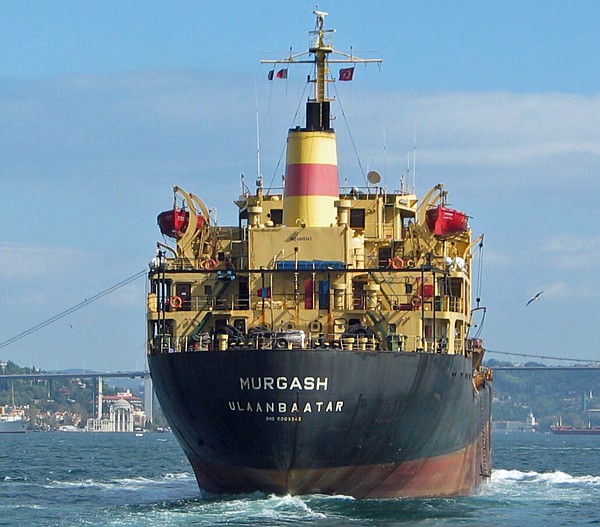
新しい旗国:モンゴル フラッグは、ブラックリストに載るのか。 最近、モンゴル籍船舶が出港停止命令を頻繁に受けている。カンボジア 籍船舶の登録を行っていた会社が、モンゴル籍への登録を行っている ようである。これは、特定の組織が サブ・スタンダード船 に関わっていることを示すものではないだろうか。
PSC(外国船舶監督官) は1~2年ほど検査に従事していれば、どこの国の船はどのような 問題があるのかわかってくると思う。また、検査会社の問題にも気がつくはずだ。
PSC(外国船舶監督官) は検査をする時は、徹底的にするべきだ。特定の個所だけをチェックするので他の問題点は見ないようではだめ。 言い訳としては成り立つのかもしれないが、問題の先送り。こんなことを しているから、◆サブスタンダード船がなくならない。
海保や外国船舶監督官(国土交通省)がモンゴルについて情報を持っているのか知らないが、 知っている範囲で説明します。モンゴル船を登録する会社の本部はシンガポールにあります。 以前はカンボジア船の登録を行っていました。カンボジア船の検査はでたらめ、 登録に関する要求も簡単なため、規制や法を逃れたい会社や人達が利用し、問題となりました。
国土交通省のHPで公表されている2006年3月に出港停止命令を受けた船 の中でもダントツです。問題解決のため、 カンボジア政府(Ministry of Public Works and Transportation)は 他の会社に船舶登録業務を任せることにしました。 現在は韓国の会社が登録業務を引き継いでいますが、この会社も問題があるようです。 間違っていなければ、この会社も以前、 サブスタンダード船問題 に関与していたからです。 結局、同じ会社や人間が会社名を変え、パートナーを変えながら、同じ事をしているのです。 日本はこの事実を知っているのか、知らないのか、問題解決に真剣に取り組んでいるとは思えません。
上記のような問題をおこした会社がモンゴル船登録業務をおこなってよくなるはずはありません。 ツバル船登録業務も同じ会社がおこなっています。 彼らも日本のやり方を馬鹿にしつつも、感謝していると思います。なぜなら、アジアで カンボジア、 モンゴル、及び ツバル籍船 が他の地域に比べ増えているからです。 韓国漁船、海保の2人乗せ逃走 の事件のように、笑われているでしょう。 結果は、各国の外国船舶監督官や各国のコーストガードが知ってる通り。でたらめなのです。 でたらめな検査をおこなっても処分されません。 耐震偽装問題発覚前の日本と同じです。 ヨーロッパでは、問題船は船名を変えても、国籍を変えても、入港を拒否します。日本は 何も出来ない。非難しか出来ない。行動できない無能国なのかもしれません。
日本について言えば、モンゴルだけでなく、 カンボジア船 についても未だに厳しく取締まれていないのが現状。いくら出港停止命令を出しても、すぐに出港させる。 だから問題船がすぐに再入港してくる。問題を発見できない場合もある。(政治的な意図とは関係ないが、 北朝鮮船が拉致問題以前は取締まられなかったように。)違法を容認している国の 評判が悪くなろうが関係ない。悪評がさらに悪い顧客を呼ぶ。彼らは結果を受け入れている。 名よりもお金である。船を登録した証明の国籍証書やその他の書類が紙切れが何万円、何十万円 となるのである。貨幣の偽造よりも簡単で罪も問われない。海保、外国船舶監督官、 税関、警察、及び検察は問題を理解しようとしない。対応もしない税金泥棒である。 問題を解決する前に、 ツバル船 も新たに加わり、 無秩序状態。
偶然に下記の記事を見つけた。モンゴル籍に船の登録を行うシンガポールの会社が 紹介された時の記事と下記の記事を読めば、理想と現実は違うことに気付く人が多いでしょう。
下記の記事を読むと、「モンゴル政府はモンゴル籍船舶の質の向上について考えて始めた」 と書かれている。しかし、 ずさんな検査を行う検査会社の承認や 問題がある検査会社の放置について触れられていません。 確かに船舶を登録する側と検査を行う側の両方が適切に対応していれば、 サブスタンダード船(問題船) が登録されることはありません。 しかし、登録する側が技術的な問題があるかの確認を怠って登録を行い、 検査する側も故意に検査を通せば、 サブスタンダード船(問題船) の誕生。
モンゴル国(外務省のHPより) は問題について真剣に取組んでいるのだろうか。たぶん、記事でかかれているほど 考えていないのであろう。
PSC(外国船舶監督官) が不備の指摘又は出港停止命令を出さない限り、世界中のどこにでも 行けるのです。 PSC(外国船舶監督官) や 海上保安庁 はこの事実を理解して対応すべき。

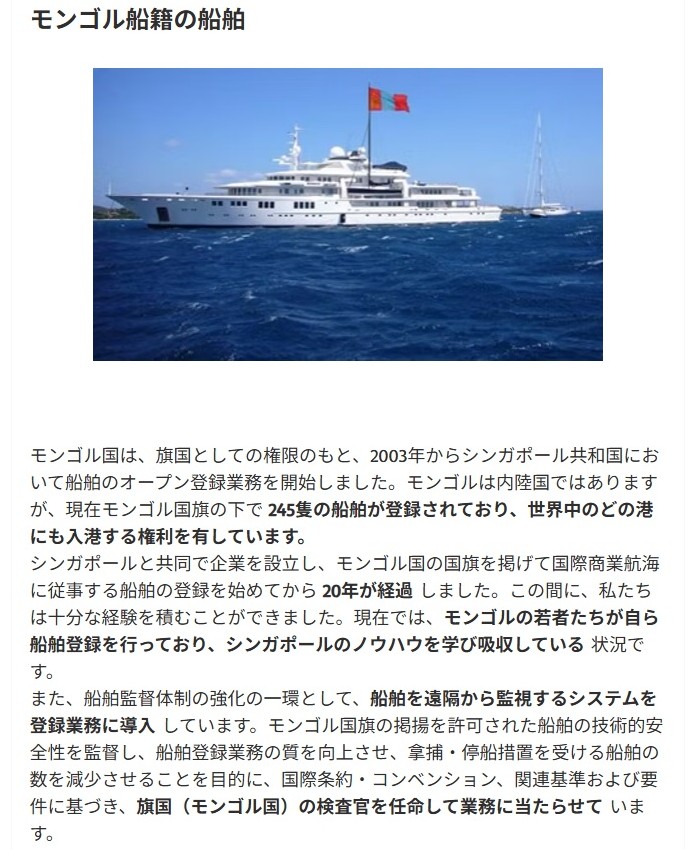
モンゴル船籍の船舶 (一般社団法人 モンゴルウォーカービジネス機構 Mongolia Walker)
モンゴル国は、旗国としての権限のもと、2003年からシンガポール共和国において船舶のオープン登録業務を開始しました。モンゴルは内陸国ではありますが、現在モンゴル国旗の下で 245隻の船舶が登録されており、世界中のどの港にも入港する権利を有しています。 シンガポールと共同で企業を設立し、モンゴル国の国旗を掲げて国際商業航海に従事する船舶の登録を始めてから 20年が経過 しました。この間に、私たちは十分な経験を積むことができました。現在では、モンゴルの若者たちが自ら船舶登録を行っており、シンガポールのノウハウを学び吸収している状況です。 また、船舶監督体制の強化の一環として、船舶を遠隔から監視するシステムを登録業務に導入 しています。モンゴル国旗の掲揚を許可された船舶の技術的安全性を監督し、船舶登録業務の質を向上させ、拿捕・停船措置を受ける船舶の数を減少させることを目的に、国際条約・コンベンション、関連基準および要件に基づき、旗国(モンゴル国)の検査官を任命して業務に当たらせて います。
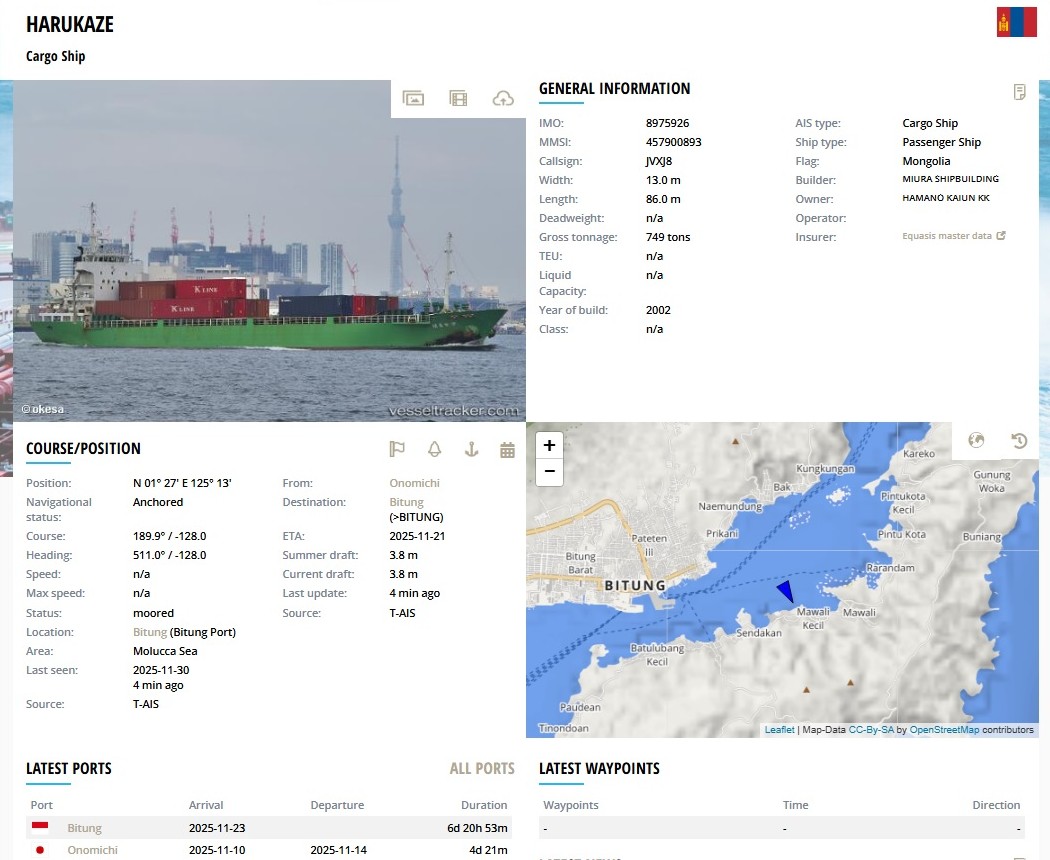
HARUKAZE (IMO8975926), Mongolia Flag, EX: 船名(Ship name)はるかぜ,船籍(Registry)香川土庄
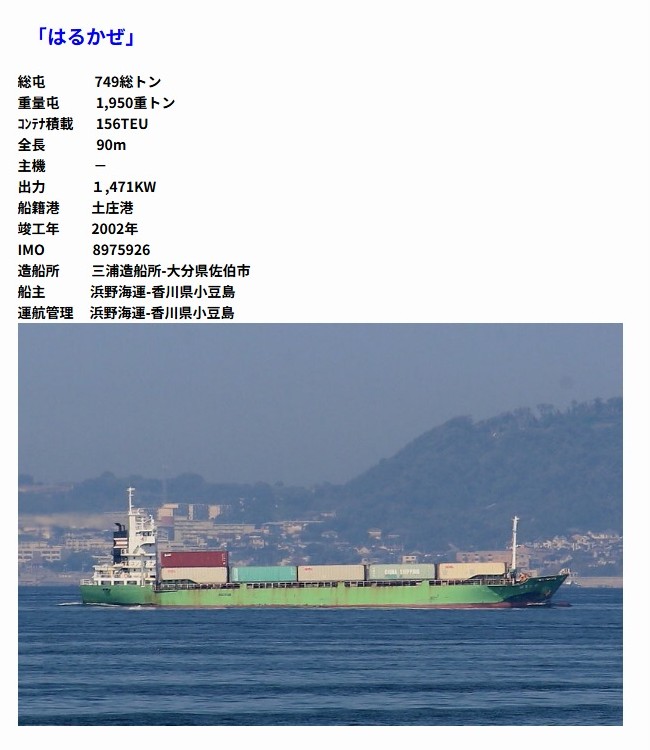
東京湾の風景 近海郵船のフィーダーコンテナ船 「はるかぜ」 09/24/2025 (kazuhi49の船の写真館)
重量屯 1,950重トン
コンテナ積載 156TEU
全長 90m
主機 -
出力 1,471KW
船籍港 土庄港
竣工年 2002年
IMO 8975926
造船所 三浦造船所-大分県佐伯市
船主 浜野海運-香川県小豆島
運航管理 浜野海運-香川県小豆島
「船舶監督体制の強化の一環として、船舶を遠隔から監視するシステムを登録業務に導入 しています。モンゴル国旗の掲揚を許可された船舶の技術的安全性を監督し、船舶登録業務の質を向上させ、拿捕・停船措置を受ける船舶の数を減少させることを目的に、国際条約・コンベンション、関連基準および要件に基づき、旗国(モンゴル国)の検査官を任命して業務に当たらせて います。」と書いているのなら、上記の船が尾道港から出港している事は把握しているのだろう。適当な事を書くのは良くないと思う。本当に国際条約・コンベンション、関連基準および要件を満足した状態で検査を通すのなら、検査官の任命や資格に関して厳しくするべきだと思う。
この船舶:M/V"HARUKAZE(IMO8975926)は国際条約・コンベンション、関連基準および要件を満足して出港したのだろうか?誰(旗国(モンゴル国)の検査官)が検査したの? P111 救命設備計画指針の改訂 (日本船舶海洋工学会)に含まれている安全設備に関して問題はなかった?言葉で綺麗ごと書いても、お金儲けが優先だと思えるのだが、現実や現状を知った上で書いているのか疑問に思う。PSC(日本のポート・ステート・コントロール:国交省職員)の検査が甘いから、検査を甘くしてお金儲けをするのはどうかと思うよ。過去に多くの旗国が同じようにしてお金を儲けてきた。今は、
 モンゴル籍船がいろいろな問題を黙認しているから、ポピュラーになっているだけ。過去にお金優先で無茶苦茶した旗国は悪評が広まったり、海難を起こして信頼を失ったり、制裁を受けたりして消えて行った。運次第で、海難が起こらず、長くお金儲けをする事は可能かもしれない。ただ、「国際条約・コンベンション、関連基準および要件に基づき、旗国(モンゴル国)の検査官を任命して業務に当たらせて います」なんて適当な事を言うのはやめるべき。
モンゴル籍船がいろいろな問題を黙認しているから、ポピュラーになっているだけ。過去にお金優先で無茶苦茶した旗国は悪評が広まったり、海難を起こして信頼を失ったり、制裁を受けたりして消えて行った。運次第で、海難が起こらず、長くお金儲けをする事は可能かもしれない。ただ、「国際条約・コンベンション、関連基準および要件に基づき、旗国(モンゴル国)の検査官を任命して業務に当たらせて います」なんて適当な事を言うのはやめるべき。
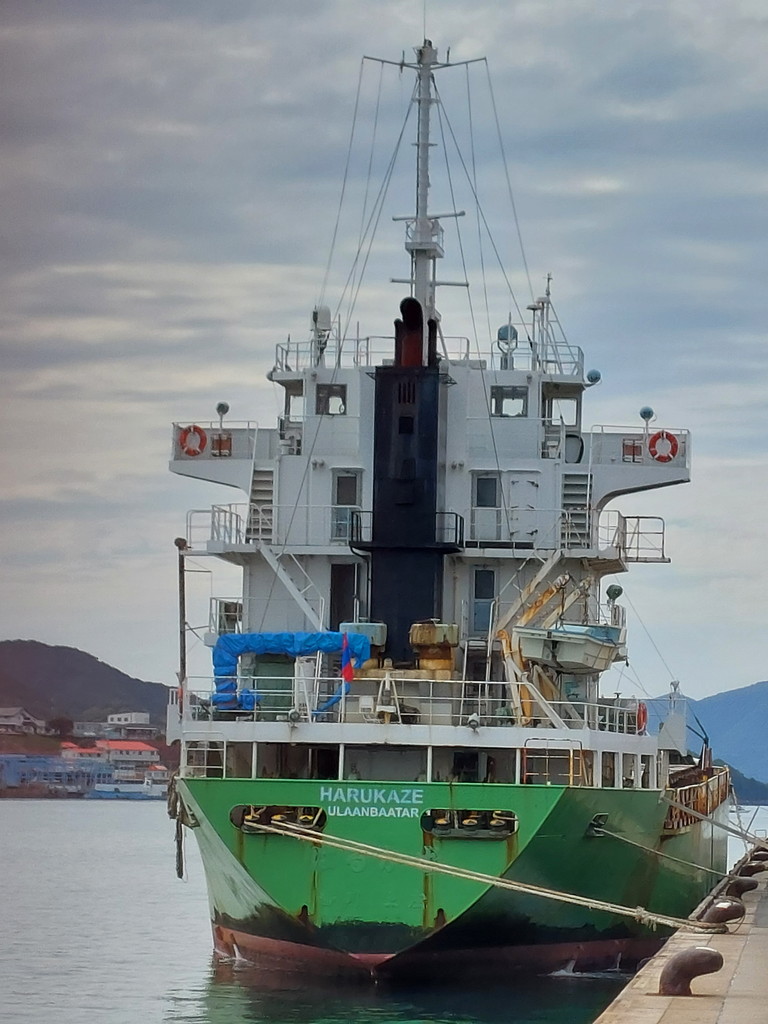
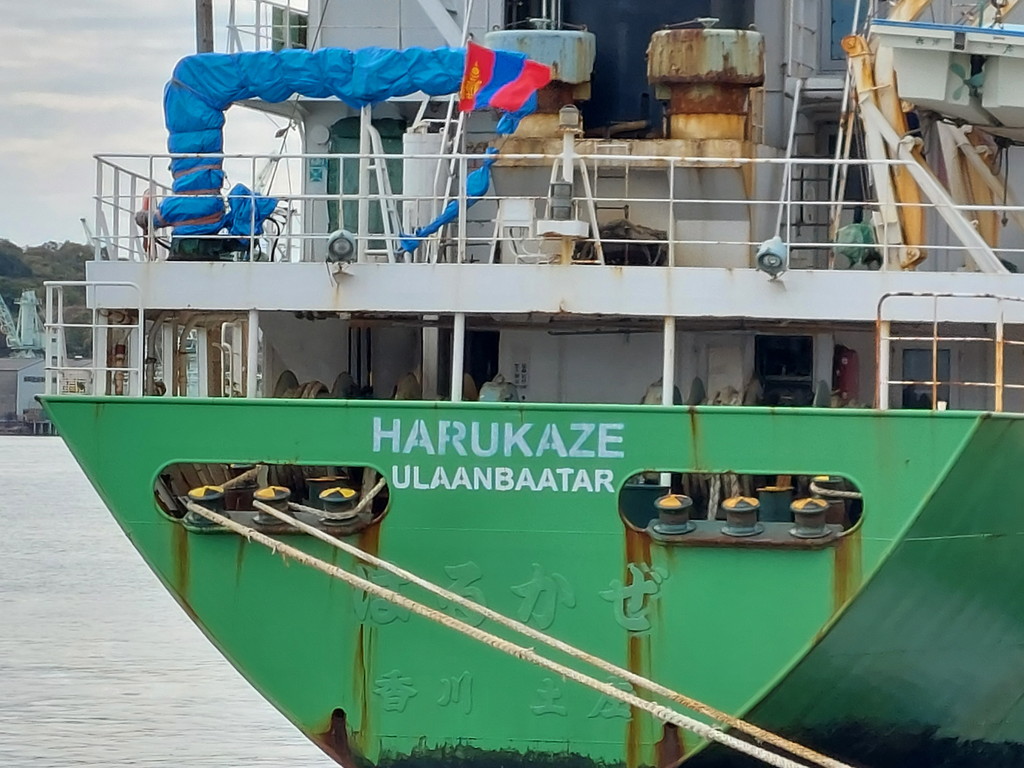
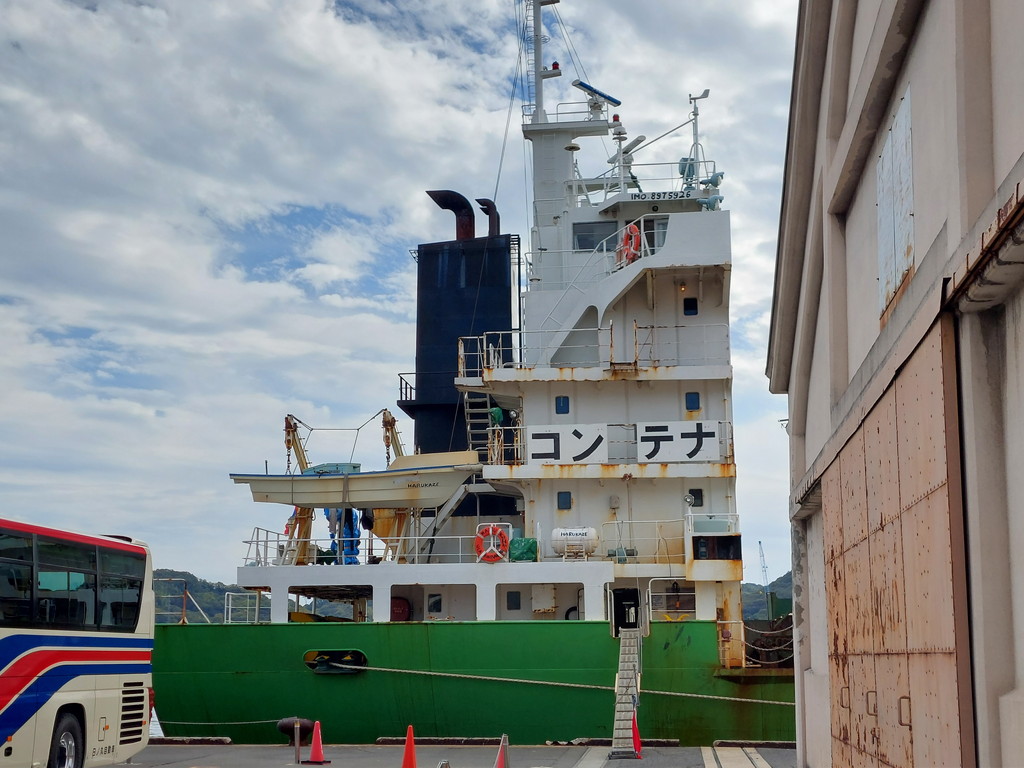
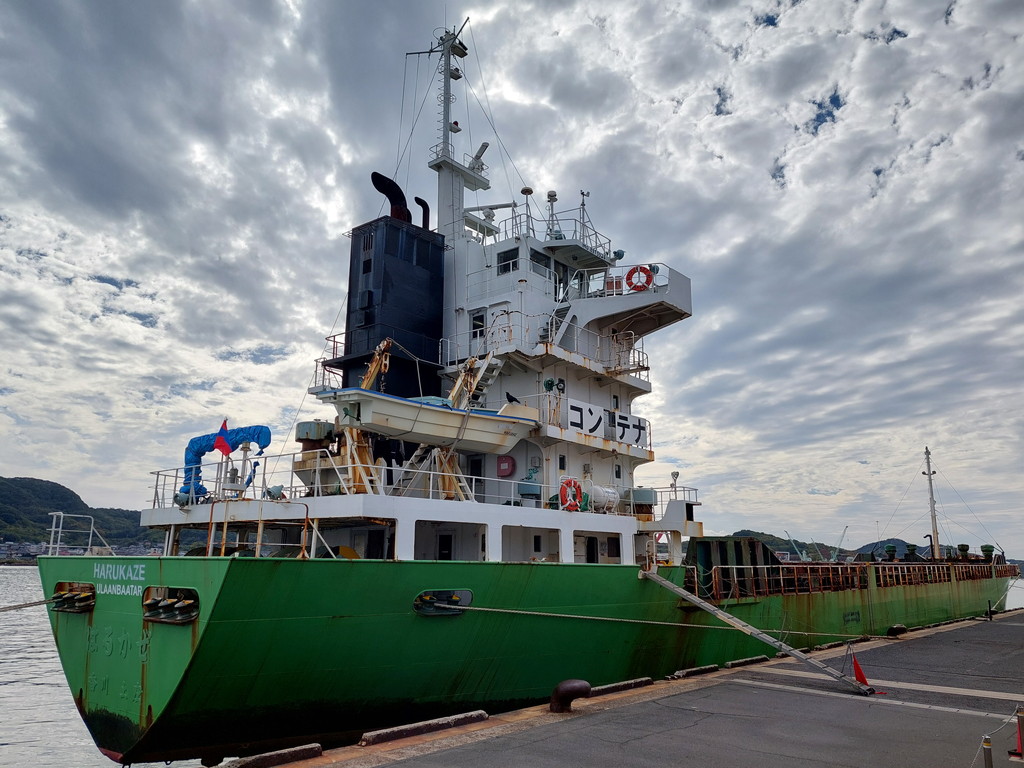
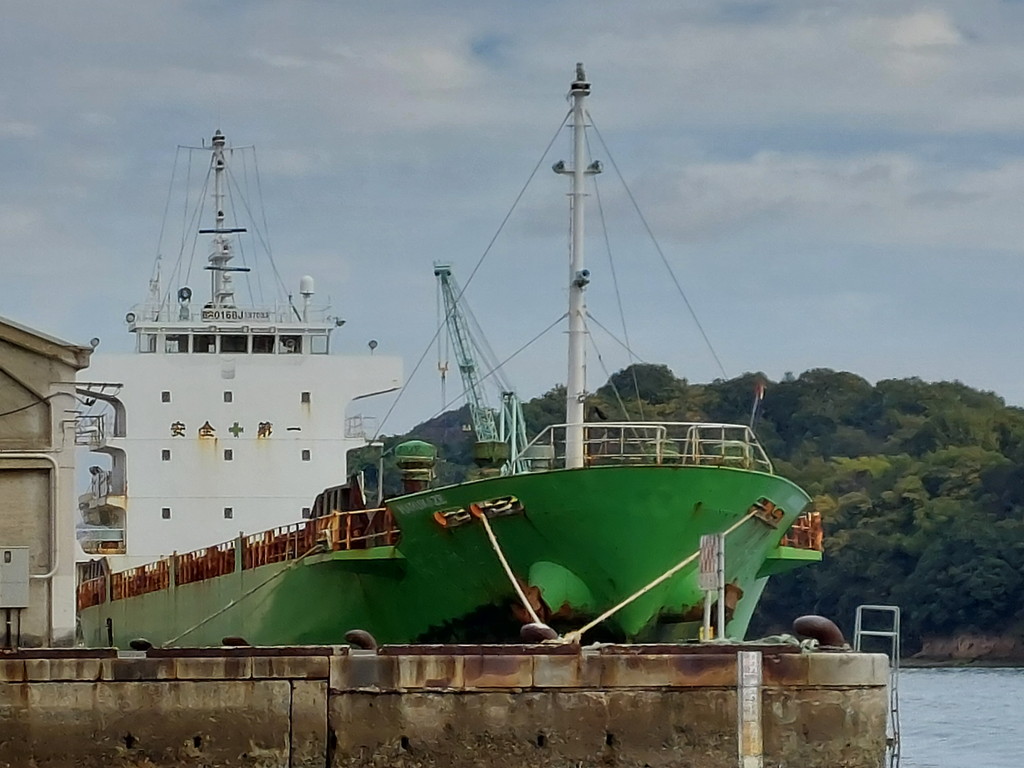
HARUKAZE (IMO8975926) 尾道港
台湾のコレスポンデンツTaiwan Maritime Services Ltd.から、台湾への入港時における中国本土(以下「中国」)、香港、マカオとつながりのある特定の船舶に対する新たな要件についての情報を入手しましたのでご案内します。
2025年3月31日以降、中国、香港、またはマカオに関連する船舶は、台湾への直接運航許可(direct voyage permits)または事業登録を申請する際に国家安全保障の審査対象になっています。
審査対象
中国、香港、マカオに関連する船舶のうち、以下の船舶が審査対象となります。
サブスタンダード船:国際条約の基準を満たさない船舶(船籍がカメルーン、タンザニア、モンゴル、トーゴ、シエラレオネなどでみられる)
特定の種類の船舶:Ro-Ro船、半潜水艇、プラットフォーム船、重量物運搬船、クレーン船、石油タンカー、プロダクトタンカー、LPG船など
※ 中国、香港、またはマカオに関連する船舶とは、中国籍、香港籍の船舶だけでなく、所有者または運送人がこれらの法域に登録されている外国船籍も含まれます。また、当局が評価した結果、これらの地域で建造された船舶、またはこれらの地域への資本・所有権のつながりを持つ船舶も審査対象となります。
審査プロセスなどの詳細については、添付のTaiwan Maritime Services Ltd.のサーキュラーをご参照ください。
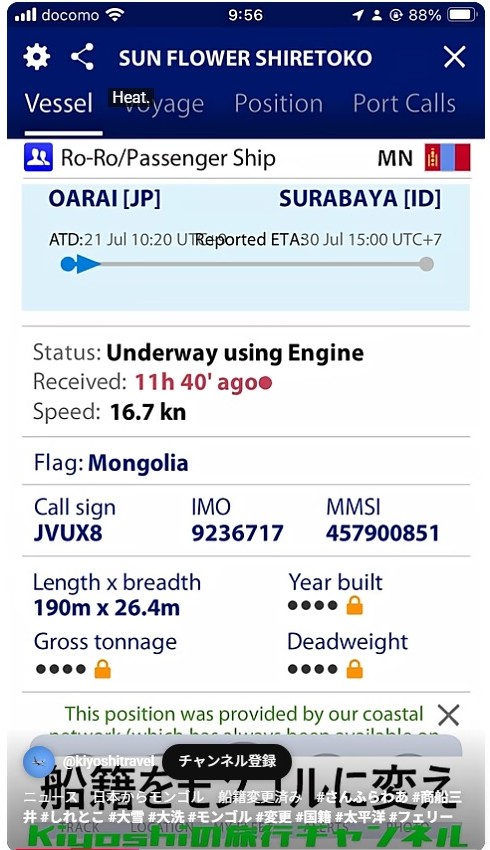
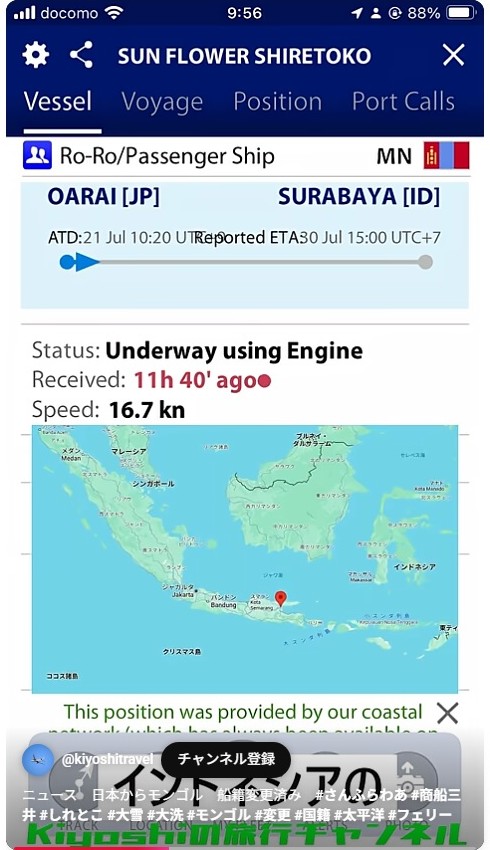
ニュース 日本からモンゴル 船籍変更済み #さんふらわあ #商船三井 #しれとこ #大雪 #大洗 #モンゴル #変更 #国籍 #太平洋 #フェリー (YouTube)
sunflower_shiretoko_imo9236717-01.jpg
Fiji Times is reporting today that, "the Captain Inoke - an 80 meter ferry imported at a cost of $7M and unveiled with fanfare at the start of the year - remains anchored and idle nearly 10 months later."
Fiji Times reports further that the ship has become the center, "of maritime showdown with the Transport Minister refusing to sign off on its registration."
The Minister’s caution must be understood within the context of maintaining the highest maritime safety standards. Fiji’s waters are unpredictable and unforgiving, and every vessel that carries our people across them must be certified beyond any doubt.
The Captain Inoke must meet every technical, structural, and operational requirement under international maritime conventions before it can be allowed to operate.
A $7M price tag does not exempt any vessel from scrutiny — safety is not negotiable.
Equally vital is the protection of our marine environment. Every vessel must be assessed for compliance with pollution control measures, fuel handling, waste management, and emission standards.
A single oversight can result in oil spills, marine contamination, and irreversible damage to our fragile coastal ecosystems.
The Minister’s insistence on full clearance is not bureaucracy — it is stewardship of our natural heritage.
Above all, the safety of passengers must remain paramount. The lives of men, women, and children who depend daily on maritime transport cannot be gambled away in the rush to meet political or commercial expectations.
If the Captain Inoke fails even one critical safety test — from fire suppression to life-saving equipment — it is better it remains at anchor than risk lives at sea because the public deserve assurance that every vessel they board is seaworthy, safe, and compliant with the highest international standard
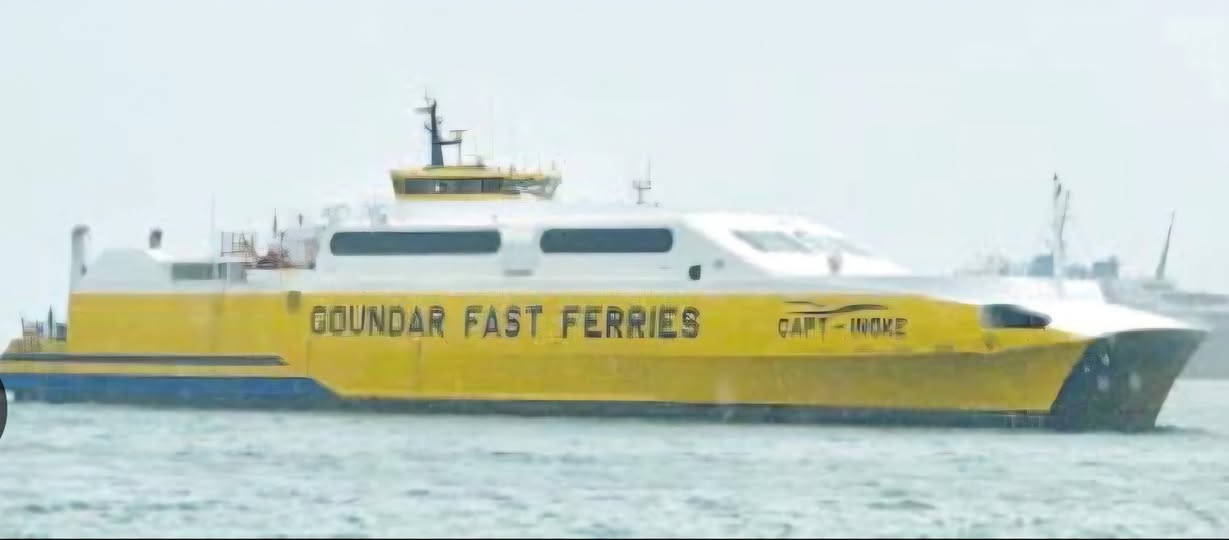
The vessel, Captain Inoke, a 27-year-old aluminum high-speed craft. Photos: Leon Lord
“We also found issues with the thickness of the hull. Its 27 years old. We have to be mindful of safety.” 06/05/25 (FIJI SUN)
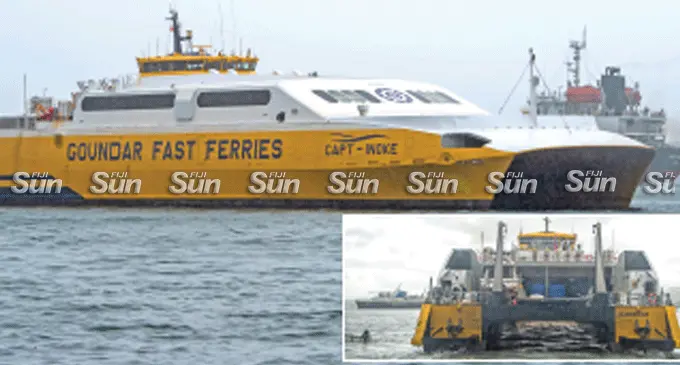
The vessel, Captain Inoke, a 27-year-old aluminum high-speed craft. Photos: Leon Lord
A high-speed passenger vessel meant to serve Fiji’s remote maritime communities has run into trouble with the Maritime Safety Authority of Fiji (MSAF).
MSAF has raised serious concerns about the ship’s seaworthiness, legal compliance, and whether the crew is fully prepared.
The vessel’s future operations now hang in the balance as authorities look deeper into the issues.
The vessel, Captain Inoke, a 27-year-old aluminum high-speed craft recently imported from South Korea under the Mongolian flag, is currently under scrutiny by the MSAF.
According to MSAF chief executive officer Joweli Cawaki, inspectors found over 20 cracks in the hull—a structural red flag that could threaten the safety of up to 500 passengers and vehicles the vessel is meant to carry.
“I’ve been told there were more than 20 cracks,” Mr Cawaki said.
“We also found issues with the thickness of the hull. Its 27 years old. We have to be mindful of safety.”
MV Captain Inoke arrived in Fiji with a Mongolian flag on January 3, and was expected to berth at the Suva Port at 1pm. Mr Cawaki said the vessel was still a foreign vessel at this stage.
“At the moment the vessel is registered as a foreign vessel by the Board of control, and it hasn’t been registered by us yet,” Mr Cawaki said.
Mr Cawaki said they have been in touch with the managing director of Goundar Shipping Limited, George Goundar, and that an application was expected from them by next week.
The vessel was meant to arrive under a temporary Fijian flag but instead came in under a Mongolian “flag of convenience,” which has weak safety oversight. This surprised MSAF.
“He went to Korea to see the boats, and we were supposed to come to Korea,” Mr Cawaki explained.
“Before we came in, the boat left Korea... not with the Fiji flag, which is supposed to be the case.”
Standoff
The impasse is a lack of appropriate legislation governing high-speed craft in Fiji. The Captain Inoke, an aluminum vessel designed for rapid transport, falls outside traditional survey schedules.
However, Mr Cawaki confirmed that Cabinet has approved a legal review to domesticate the International Code of Safety for High-Speed Craft (HSC Code), which would allow MSAF to enforce specialised safety standards for such vessels.
“Once the code is domesticated, then we’ll have to train our people,” he said, noting the current shortage of local expertise for surveying high-speed craft.
“Those are the areas he needs to see before buying a boat of this type,” Mr Cawaki said.
“He needs to first train his people.”
Mr Goundar has pushed back on the delays, warning of potential disruption to inter-island public service. But Mr Cawaki is standing firm.
“To me, it’s not a threat,” he said.
“We are the authority. We are the Government... You can bark very hard, but you don’t have the teeth we have the teeth.”
動画と画像から元々は日本籍の内航船のようだ。
LAN BAO JIAN NI (IMO:8904795, EX-TAIYO MARU NO.6 (2006),MIURA SHIPBUILDING - SAIKI, JAPAN)(BALTICSHIPPING.COM)の可能性が高いと思う。
◆AIS:船舶自動識別装置の情報を確認していて、IMO番号がないモンゴル船籍が韓国にいる。韓国のPSCは何をやっているのだろうか?泳がせて確実な証拠を押さえた上で動くのだろうか?
釜山港に停泊していたモンゴル船籍の貨物船を操縦し、韓国政府の許可を得ずに北朝鮮に行って戻ってきたインドネシア国籍の船長が、逮捕・送検された。
【写真】釜山港を出航して元山港に停泊中のモンゴル船籍の貨物船
釜山海洋警察署は8日、南北交流協力に関する法律違反容疑などでインドネシア国籍の船長(57)を逮捕・送検したと発表した。
海洋警察によると、この船長は2月9日に釜山港で牛・豚・鶏などの食肉副産物(ホルモンなど)約450トンを積載した貨物船S号(1517トン)で出港し、韓国政府の承認を得ずに北朝鮮の元山港まで行って釜山港に戻ってきた疑いが持たれている。船長は2月11日に元山港に到着してしばらく滞在し、3月5日に元山を出港して四日後に給油目的で釜山港の南外ふ頭に入港した。
海洋警察は「現行法によると、外国の船舶であっても韓国と北朝鮮の間で船舶などの輸送機器を運行する場合、韓国統一部(省に相当)の承認を受けなければならない」と説明した。この貨物船は台湾の法人が所有しており、逮捕された船長を含め8人のインドネシア人船員が乗っている。
海洋警察は韓国関税庁や国家情報院など関係機関との共助を通じ、この法人と船長を立件した。船長らは海洋警察の取り調べに対し「食肉副産物450トンを売るために北朝鮮の元山港に向かったが、結局取引は成立せず、そのまま釜山港に戻ってきた」と供述している。
海洋警察は、船長らが北朝鮮まで行って戻ってきたという事実を確認し、虚偽の入出港申告をした経緯や元山港を訪れた理由・目的などを調べた。海洋警察などは、船長らによるスパイ活動などの容疑についても調査を進めている。この貨物船は当局の調査が実施されている間は出港が禁止され、釜山港の南外ふ頭に停泊しなければならない。
海洋警察の関係者は「承認を受けずに北朝鮮に寄港したり、虚偽の出入港届を出したりする行為は国家の安全保障に深刻な影響を及ぼす」として「今後も外交部や国家情報院など関係機関と強固に協力し、海上での安保侵害行為に対して強力に対応していく」と述べた。
パク・チュヨン記者

A satellite image of a cargo vessel that allegedly illegally carried 450 tons of meat to the port of Wonsan, North Korea on March 5 [KOREA COAST GUARD]
South Korean authorities have arrested the captain of a foreign cargo vessel on charges of illegally attempting to deliver hundreds of tons of meat to North Korea, in what officials described as a serious violation of inter-Korean trade laws.
According to the Coast Guard on Tuesday, a cargo vessel owned by a Taiwan-based company departed from Busan Port on Feb. 9 and entered North Korean territorial waters via the East Sea.
The ship remained docked at the port of Wonsan Port in North Korea until March 5. The vessel was reportedly carrying 450 tons of frozen meat products, including cattle and pig intestines and chicken feet.
The captain, an Indonesian national in his 50s, was taken into custody by the South Korean Coast Guard and referred to prosecutors. Authorities suspect he attempted to sell the meat to North Korean buyers during his time in Wonsan.
Although the meat was still on board at the time of the vessel's interception, the captain claimed he was merely following company orders to travel to Wonsan and was unaware of any specific transaction details.
Under South Korean law, any form of transport traveling between South and North Korea — regardless of foreign ownership — requires prior approval from the Unification Ministry. However, the cargo vessel allegedly misreported its destination when departing Busan, in an apparent attempt to conceal its true course.
The ship used a similar tactic when returning to Busan for refueling on March 8, again listing its previous port of departure as an unspecified offshore area.
The Coast Guard also found that the captain had switched off the ship's Automatic Identification System (AIS), a device used to track a vessel's position, while sailing through North Korean waters. The AIS was turned back on only upon reentering South Korean waters.
While the ship did not meet the criteria to be flagged as a “vessel of interest” — a designation for ships with prior violations or suspected of espionage — the Coast Guard confirmed its activity through satellite imagery showing the vessel docked in Wonsan.
Including the captain, eight Indonesian nationals, were on board at the time of arrest. The Taiwan-based shipping company that owns the vessel has also been booked on related charges.
Authorities said that no evidence of espionage was found.
However, a Coast Guard official said “even if a ship is foreign-registered, unauthorized travel to and from North Korea, and providing false declarations about port entries and exits, can pose serious national security risks.”
“We will strengthen monitoring and enforcement measures against maritime security violations,” the official added.
Translated from the JoongAng Ilbo using generative AI and edited by Korea JoongAng Daily staff.
Cargo ship was seized by Busan Coast Guard after falsely reporting its whereabouts and traveling to Wonsan Port 04/08/25 (Korea JoongAng Daily)
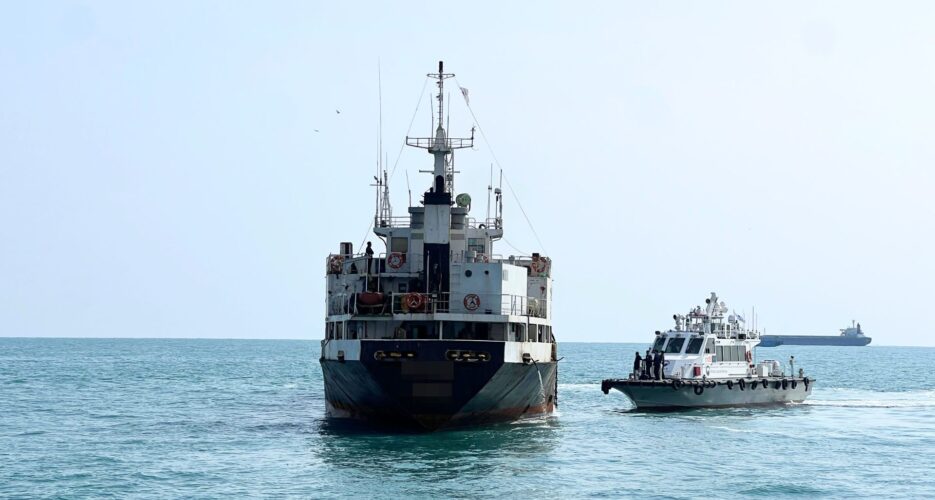
The Mongolian-flagged vessel seized by ROK authorities for unauthorized voyage to North Korea | Image: courtesy of Busan Coast Guard
South Korean authorities have booked the Indonesian captain of a Mongolian-flagged cargo ship in Busan for illegally entering North Korea after previously visiting the ROK port.
The vessel departed Busan on Feb. 9, falsely reporting its destination before arriving at Wonsan Port on North Korea’s east coast, according to a press release the Busan Coast Guard shared with NK News.
Although the meat was still on board at the time of the vessel's interception, the captain claimed he was merely following company orders to travel to Wonsan and was unaware of any specific transaction details.
Under South Korean law, any form of transport traveling between South and North Korea — regardless of foreign ownership — requires prior approval from the Unification Ministry. However, the cargo vessel allegedly misreported its destination when departing Busan, in an apparent attempt to conceal its true course.
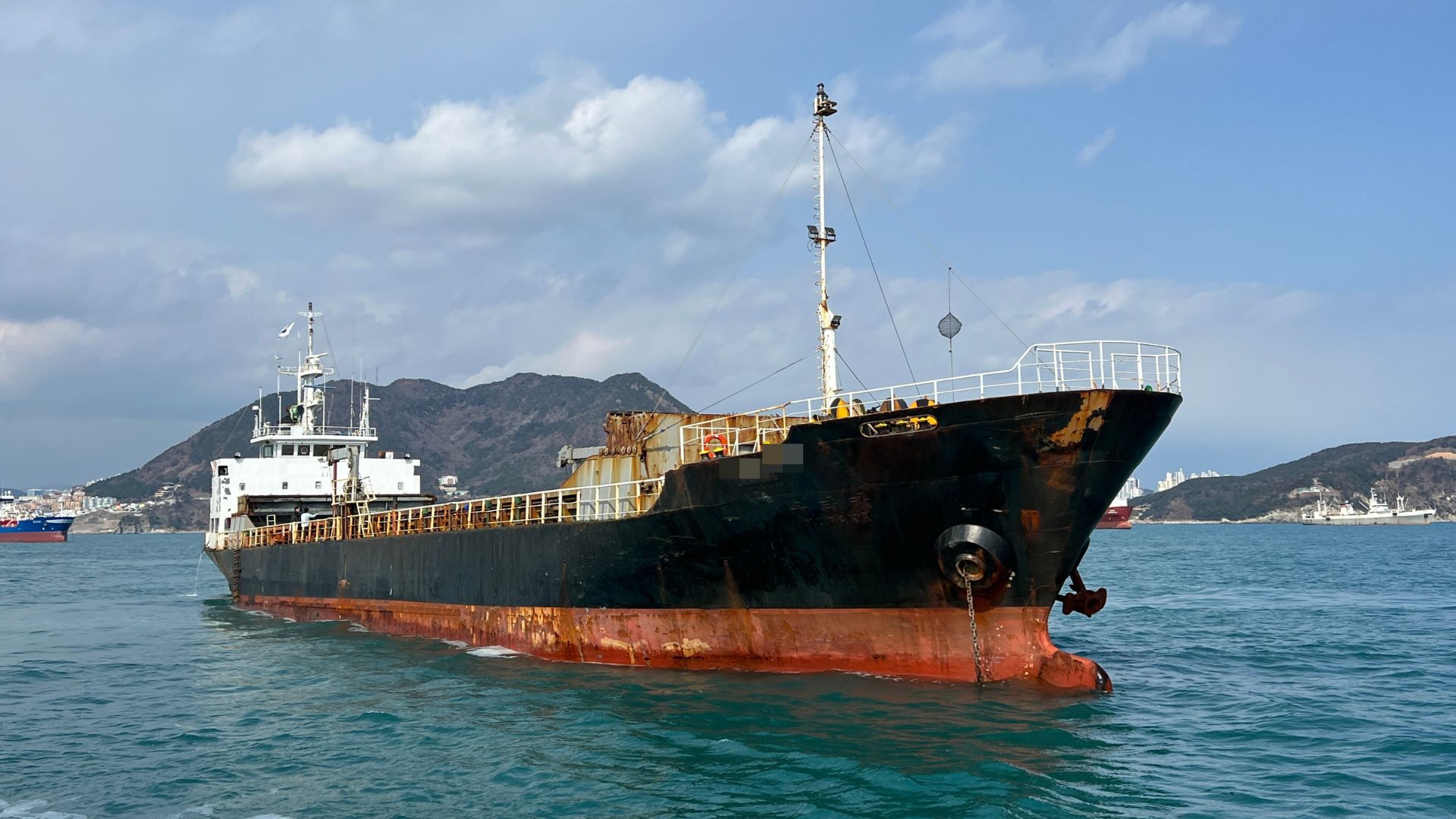
TThe Mongolian-flagged vessel seized by ROK authorities after its trip to North Korea | Image: Busan Coast Guard
The 1,517-ton freighter remained in Wonsan until March 5, then sailed back to Busan for refueling, once again falsely reporting its last port of call.
NK News analysis of maritime data and satellite imagery provided by the Coast Guard suggests that the ship is likely the Sun Sun (IMO 8904795, formerly known as Lan Bao Jian Ni), which left Busan’s harbor in early February sailing north.
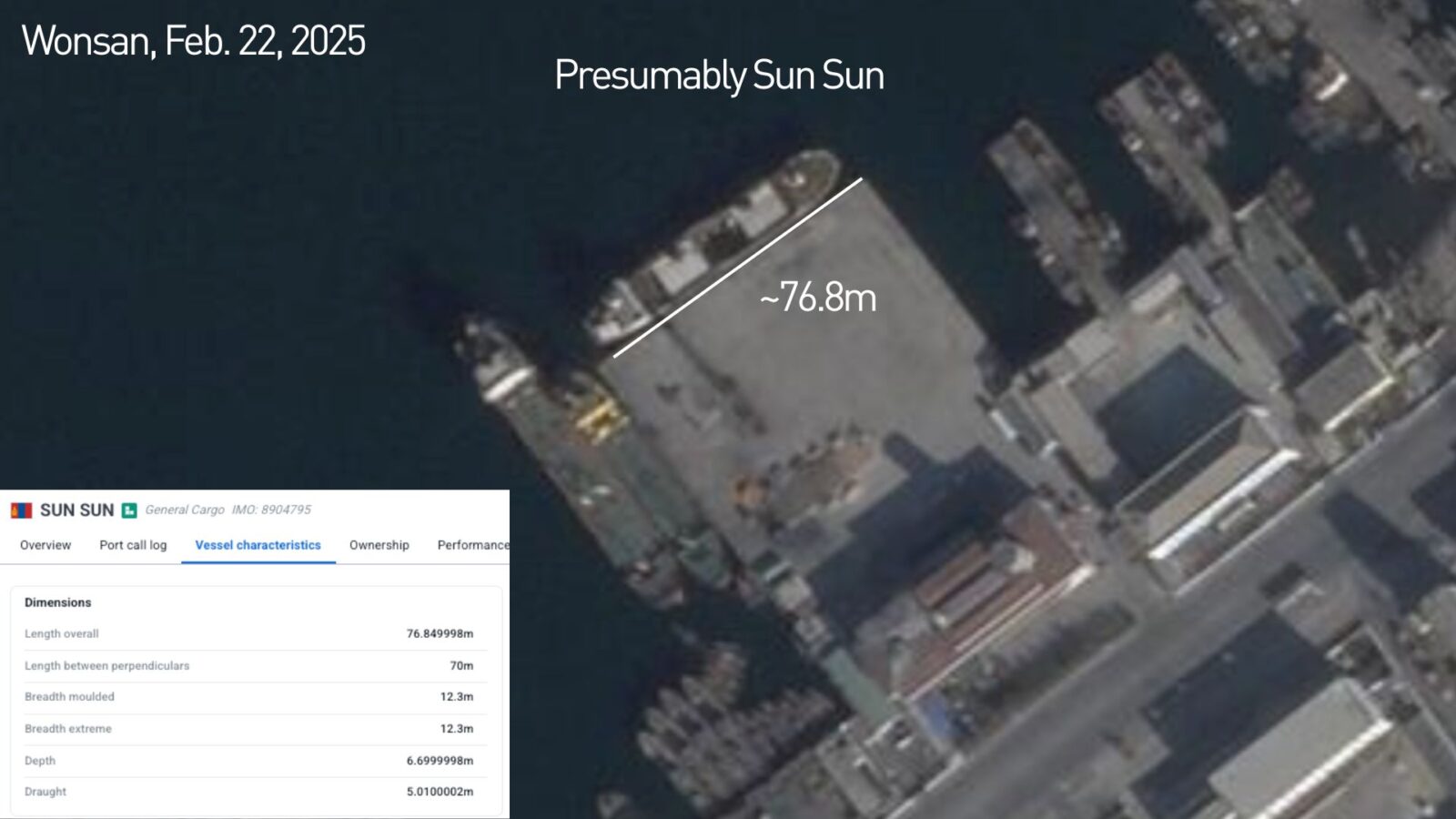
High-resolution satellite imagery confirming the location of the Mongolian-flagged freighter at Wonsan on Feb. 22, 2025. The vessel’s tonnage and hull parameters appear identical with another Mongolian-flagged vessel Sun Sun (IMO 8904795) that also sailed north of Busan on Feb. 2025 | Image: MAXAR, provided by Busan Coast Guard, edited by NK News
The vessel’s captain, identified by the Coast Guard only by the initial M, is an Indonesian national, while the ship is owned by a Taiwan-based company referred to by the initial B.
Following the seizure of the vessel, the Coast Guard apprehended the captain in coordination with the ROK Customs Service and the National Intelligence Service, before handing him over to prosecutors.
The captain has been charged with violating the Inter-Korean Exchange and Cooperation Act and the Act on the Arrival and Departure of Ships, a Busan Coast Guard spokesperson told NK News.
If convicted, he faces a maximum jail sentence of three years or a fine of $20,380 (30 million won) for the first charge and a maximum one year sentence or fine up to $6,800 (10 million won) for the second charge.
The Taiwan-based ship owner also faces charges of violating the Inter-Korean Exchange and Cooperation Act.
The law enforcers stressed that sailing to North Korea and then re-entering the ROK without authorization from relevant agencies, in addition to submitting false port-of-call information, constitutes a “serious act that can significantly impact national security,” according to the press release.
MarineTraffic records show the Sun Sun often traveled through the Taiwan Strait, a known hub for smuggling and ship-to-ship transfers, and the Yellow Sea, where it frequently stopped transmitting its location, likely turning off its transponder to hide North Korea-related activity.
Notably, the law enforcers discovered North Korean-made seals attached to the vessel’s radio equipment, further evidence of the ship’s dealings with the DPRK.
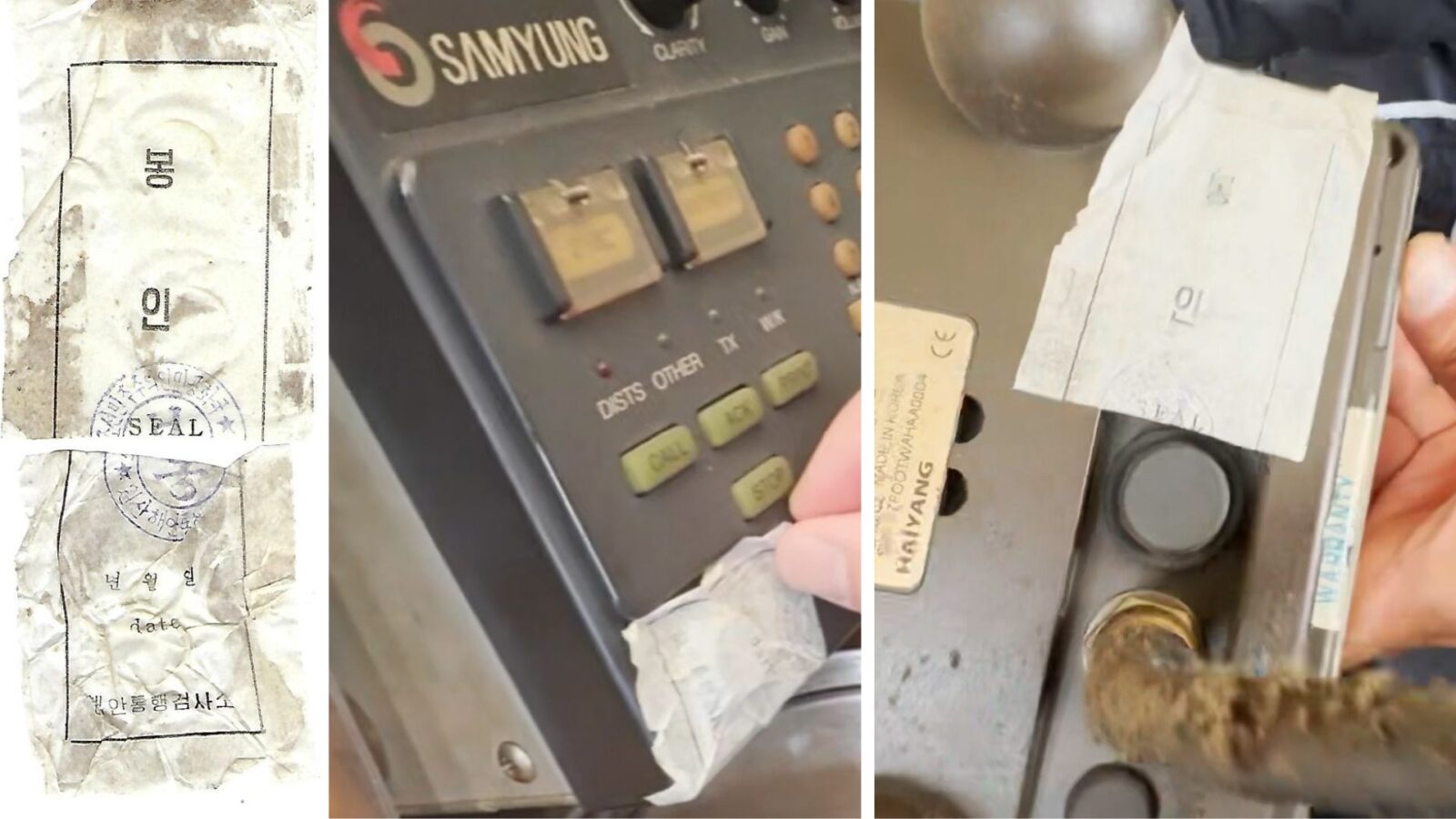
North Korean seals discovered by ROK officials on the vessel’s communication equipment | Image: Busan Coast Guard
Upon seizing the ship, the Busan Coast Guard discovered multiple containers filled with frozen pork and chicken, with ROK media reports suggesting the vessel initially carried up to 450 tons of such produce for sale in Wonsan.
The case comes nearly a year after ROK authorities seized the 3,000-ton De Yi (IMO 8360676) cargo vessel sailing under an unknown flag on suspicion of violating U.N. Security Council sanctions imposed on North Korea.
Edited by Alannah Hill
Shipping

Sam Chambers
Following reports of cable breakage and to strengthen the safety of Taiwan’s waters and key infrastructure, ships from Mainland China, Hong Kong and Macau are now required to go through longer port visit application processes to the island with the paperwork expected to take up to a month per vessel visit. Ships also flying the flags of Cameroon, Tanzania, Mongolia, Togo and Sierra Leone are also required to fill in the extra filings, many of which will be screened by Taiwanese security officials before being passed on to Taiwan’s Maritime and Port Administration.
Like in the Baltic, Taiwan has faced multiple attacks on its subsea infrastructure in recent months, largely from merchant ships dragging their anchors.
The island blacklisted 52 Chinese-owned ships in January while Taiwan’s National Security Bureau has said ships which have previously been found to misreport information will be put on a list of ships for priority inspection at ports.
Moreover, if these ships enter within 24 nautical miles of Taiwan’s coast and are close to where undersea cables are, the coast guard will be dispatched to board them and investigate.
A ship accused at the end of February of damaging cables off Taiwan had a simple way of changing identity.
The Togo-flagged Hongtai 68 was able to change its name many times as the crews simply replaced three steel plates (pictured) at its stern and on its bow whereby it has also recently traded as the Hongtai 58 and Shanmei 7.
The captain of the vessel – dubbed in local media as the ‘thousand faces ship’ – had on an earlier occasion been caught entering Taiwan with false documents.

AKIPRESS.COM - Officers from the Coast Guard Department of the Border Police of the Ministry of Internal Affairs of Georgia have detained the dry cargo ship HASKAL, sailing under the Mongolian flag, for violating navigation rules in the country's territorial waters, agenda.ge reports.
Following the detention, officers from the Main Investigative Department of the Border Police initiated legal proceedings against the ship's captain, an Azerbaijani citizen, who was fined ₾10,000 ($3,500).
After settling the penalty, authorities permitted the vessel to resume its voyage.
Even though Mongolia is landlocked, there are 233 boats registered under the Mongolian national flag that have the right to call at any port in the world.

The Employees of the Coast Guard Department of MIA Border Police, in the Georgian Territorial Waters, detained the cargo “HASKAL”, under the flag of Mongolia, for the violation of the rules of the Navigation.
Against the Captain of the vessel, who is the Citizen of the Republic of Azerbaijan, the employees of operative – investigation Main Division started proceeding for the fact of the violation of the rules of the Navigation in accordance to the Administrative Code of Georgia, article 1141, Part I, Subparagraph “D”.
The Captain of the Vessel was charged by 10 000 Lari. After the payment of the fine, the Vessel will be granted the right of free navigation.
Bojan Lepic
Taiwan has blacklisted 52 Chinese-owned ships that operate under flags of convenience.
The crackdown follows the severing of a subsea communications cable near Taiwan at the beginning of January. Taiwan’s National Coast Guard Administration identified a Cameroon-registered cargo ship, Shunxin 39 (pictured), as the suspect in the incident.
Taipei will now target vessels flagged under countries like Cameroon, Tanzania, Mongolia, Togo, and Sierra Leone, where it deems ship registration processes often lack stringent safety and regulatory standards.
Of the 52 vessels identified, 15 were deemed threats due to their extended presence in Taiwanese waters over the past year. Among these, one vessel was flagged as a “high threat,” with several others categorised as posing medium or lower levels of risk.
Earlier this month, the Shunxin 39 was ordered to return to waters near the Port of Keelung to be investigated. Due to rough weather, coast guard officers were not able to board the ship for investigation and could not detain it. The ship continued on its way to South Korea.
It was later revealed that the vessel belongs to Hong Kong-based Jie Yang Trading headed by a Chinese citizen.
Taiwan’s National Security Bureau said earlier this month ships which have previously been found to misreport information will be put on a list of ships for priority inspection at ports.
Moreover, if these ships enter within 24 nautical miles of Taiwan’s coast and are close to where undersea cables are, the coast guard will be dispatched to board them and investigate.
Other ships hanging around the Taiwanese coastline have sparked concern. For instance, the Belize-flagged Russian general cargo vessel, Vasily Shukshin, left Russia’s Vostochnyy port on December 8 and loitered off Taiwan’s coast on December 19, according to Ray Powell, director of Stanford University-affiliated maritime analyst group SeaLight.
Powell said the vessel was “aimlessly criss-crossing” the area near Taiwan’s Fangshan undersea cable landing station for three and a half weeks “for no apparent reason,” but that it had since started to return to Russia earlier this week.
According to data provider Windward, the frequency of underwater infrastructure sabotage has increased from just two incidents in 2000 to 75 incidents in 2024 with the seas around Taiwan as well as the Baltic becoming hotspots for ships deliberately dragging anchors to take out critical subsea infrastructure.
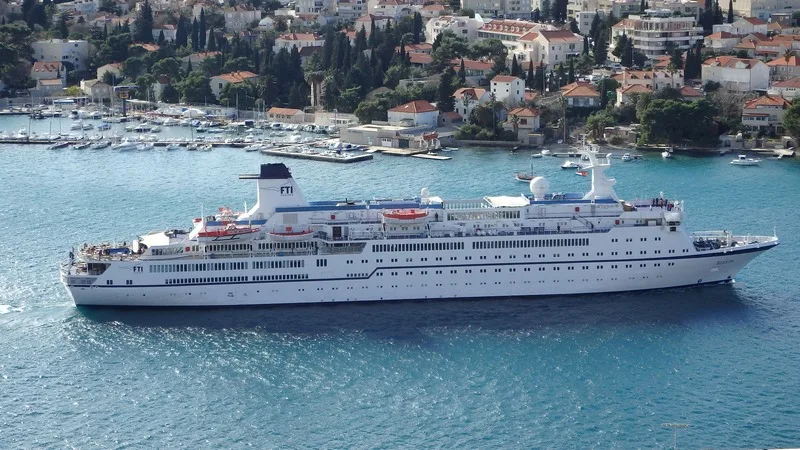
The former Berlin has recently arrived in Ningde, China, after spending over four years out of service in Greece.
Now carrying the name Dream Goddess, the 420-guest ship sailed from Perama in late October, arriving at the Chinese port via the Suez Canal on Dec. 27, 2024.
While the nature of the repositioning voyage is currently unclear, the Ningde region is known for its ship-breaking yards.
According to AIS data, the vessel was also reflagged before sailing to China and now flies the Mongolian flag.
Last operated by FTI Cruises, the Dream Goddess was built in 1980 for Germany-based Peter Deilmann Reederei as the Berlin.
With an eventful sailing career, the ship sailed for several operators over the years, completing charter contracts in Russia and Asia.
In 2005, the Berlin was sold to Saga Cruises, which renamed the ship Spirit of Adventure for fly-cruises in exotic destinations.
Six years later, the vessel was sold to the tour operator FTI Group, becoming the first ship of the newly launched FTI Cruises brand.
Serving the German market as the FTI Berlin, the 9,500-ton ship continued to sail for the brand through early 2020.
With the Covid-19 pandemic bringing the cruise industry to a complete stop, FTI Cruises shut down its operations. As a result, the Berlin ended up being sold in late 2020.
The new owners, who acquired the ship for just over one million euros, planned to convert it into a private yacht.
The plan, however, seems to have been dropped, as the ship, which was renamed Dream Goddess after the sale, remained docked in Greece for over four years.
驚く事ではないと思う。
ヤフーコメントに下記のようなコメントがあった。
モンゴル船籍って...海の無いモンゴルで船籍登録できるのか。知らなんだ。
それと、台湾人3人とミャンマー人7人でという話なら泰緬孤軍で台湾に移住したグループを想起してしまう。今、ミャンマーの内戦でシャン州コーカンの詐欺や麻薬問題が語られているけど、中共との繋がりだけでなく、台湾にも繋がる人たちが存在しているはず。闇社会の事情をある程度、掴んでいるので摘発できるのか。

Photo courtesy of Coast Guard Administration's Southern Branch July 28, 2024
Kaohsiung, July 28 (CNA) The Coast Guard Administration (CGA) said on Sunday that 59 people have been rescued from six of the eight cargo ships that ran aground in southern Taiwan due to Typhoon Gaemi, with 29 people on the other two freighters still waiting to be rescued.
A total of eight freighters ran aground along the coast of Tainan, Kaohsiung, and Pingtung County when Typhoon Gaemi hit Taiwan over the past few days, according to a statement issued by the CGA's Southern Branch.
As of 8:00 a.m. Sunday, the coast guards had rescued 59 people from six ships, while 29 individuals on the other two freighters, who have not yet been rescued, are safe and "waiting for further arrangements," the CGA said.
The latest rescue operation took place on Saturday evening when coast guards saved all eight crew members from the cargo ship "BASIA," which ran aground 0.5 nautical miles southwest of Donggang Township in Pingtung County, the CGA added.

Photo courtesy of Coast Guard Administration's Southern Branch July 28, 2024
As weather conditions improved, a drone was dispatched on Saturday and two more are set to be deployed on Sunday to monitor the waters and shores around the cargo ships stranded along the coasts of Tainan and Kaohsiung for any drifting containers or oil spills, according to the statement.
Regarding the Tanzania-registered freighter "FU SHUN," which is believed to have sunk 16 nautical miles off Kaohsiung, the captain has been confirmed dead, four crew members have been rescued, and four others remain missing, the statement read.
The CGA said that the Fifth Maritime Patrol Flotilla received a report on Saturdayevening about a body found near the Chung-yun Fishing Harbor in Kaohsiung's Linyuan District, but the retrieval operation of the body has been delayed due to a large amount of driftwood surrounding it, preventing personnel and vessels from approaching and confirming the deceased's identity.
(By Chang Yi-lien and Sunny Lai)
Enditem/cs

This map shows the locations of the eight cargo ships that ran aground in southern Taiwan, and the sunken Tanzania-registered freighter "FU SHUN" off Kaohsiung, due to Typhoon Gaemi. Graphic courtesy of Ocean Affairs Council July 26, 2024

Nine Myanmar nationals are missing after a ship capsized and sank off Taiwan’s southern coast, and three other vessels have run aground in sea and wind conditions affected by Typhoon Gaemi since yesterday, July 24.
According to Taiwan’s National Coast Guard Administration, the Tanzanian-flagged freighter Fu Shun capsized and sank around 19 nautical miles off the coast of Kaohsiung City at around 6:30 am this morning. The crew of nine Myanmar nationals are suspected to have fallen into the sea and are missing.
NCGA was notified that the Portuguese-registered cargo ship Sopfia had run aground 1.5 nautical miles southwest of Anping Port on the coast of Tainan City at around 1:30 pm yesterday. All crew aboard the 1,233 metric ton ship are reported to be safe.
At 11:42 pm it was reported that the 10,306 metric ton Indonesian cargo ship Iriana was aground around on the coast at Jialu Beach, Fangshan Township, Pingtung County. The 20 Indonesian crew members aboard were reported safe, the hull intact, and no oil leakage had occurred.

Indonesian cargo ship Iriana aground on coast of Pingtung County, Taiwan, July 25, 2024. Picture Credit: NCGA.
At 8:15 am this morning, the Mongolian-flagged cargo ship Basia ran aground on the shore of Dapeng Bay, Pingtung County. There were eight crew aboard, consisting of six Indonesians and two Myanmar nationals.

Cargo ship Basia aground on the shore of Pingtung County, Taiwan, July 25, 2024. Picture Credit: Mr Lee.

1. Iriana – aground. 2. Sopfia – aground. 3. Hedwig Oldendorff – made a distress call, but is now reported safe. 4. Fu Shun – capsized and sank, crew missing. Picture Credit: National Coast Guard Administration.
(高雄中央社)海洋委員会海巡署(海上保安庁に相当)偵防分署は29日、台湾海峡で漂流していたいかだなどから1381キロ、末端価格約35億台湾元(約160億円)の大麻を押収し、台湾への不正薬物の密輸に関与していたとみられるモンゴル船籍の小型タンカーの乗組員10人を摘発したと発表した。1度の押収量としては台湾では過去最多だとしている。
同署では密輸の情報を入手後、約3カ月かけて証拠を集め、9日に専門チームを立ち上げた。10日未明には南部・高雄の北西沖でいかだ1隻に立ち入り検査し、大麻221.7キロを押収。11日に同海域で漂流していた無人の救命ボート4隻などから大麻1159.3キロを見つけた。
その後、高雄興達港沖で小型タンカーに立ち入り検査を行ったところ、同船が救命ボートを使って大麻を台湾に密輸しようとしていたことが判明した。
台湾橋頭地方検察署(地検)は、摘発された小型タンカーの乗組員は台湾人3人とミャンマー人7人で、取り調べ後、毒品危害防制条例や不正薬物運搬の罪に違反している疑いが強いとして身柄を拘束したとしている。
(洪学広/編集:齊藤啓介)
Taipei, Dec. 29 (CNA) Ten seamen have been detained on suspicion of smuggling 1.3-metric tons of marijuana earlier this month, the largest drug haul of its kind in Taiwan, the Ciaotou District Prosecutors Office said in a statement issued Friday.
The marijuana seized had a street value of NT$3.5 billion (US$114.2 million), prosecutors said, adding that the illegal operation was interdicted from Dec. 9-12 in the northwest waters off Kaohsiung, where five unmanned rafts being used to shuttle drugs from a Mongolian oil tanker were seized.
According to prosecutors, they worked with the Coast Guard Administration and multiple police departments across Taiwan to intercept the first unmanned raft, registered in Tainan, on Dec. 10, which was carrying four bags of marijuana that totaled 221.7 kilograms.
The next day, the taskforce again seized four similar rafts drifting in the same area, carrying 1,159.3 kg of marijuana in 20 bags with the same packaging as the previous haul.
The evidences enabled the squad to track down the tanker, which is believed to have transported the marijuana, near Kaohsiung's Xingda Port, prosecutors said.
At the request of prosecutors, the Taiwan Ciaotou District Court ordered the detention of all 10 suspects -- the tanker's Taiwanese owner, surnamed Huang (黃), two Taiwanese seamen and seven Burmese fishermen -- for allegedly violating the Narcotics Hazard Prevention Act.
According to prosecutors, the marijuana seized in the operation-- which is listed as a Category 2 drug in Taiwan -- could be turned into 2.8 million cigarettes.
(By Hung Hsueh-kuang and Lee Hsin-Yin)
Enditem/AW
By Elisabeth Braw, a columnist at Foreign Policy and a fellow at the American Enterprise Institute.
Mongolia is the world’s second-largest landlocked country. On paper, though, it sails more than 3,000 ships. The North Asian country has established a shipping registry that, like other nations taking advantage of shipping’s sketchy rules, has become a preferred choice for a dubious clientele of shipowners.
The decades after the 1920s—when some U.S. companies began reflagging their ships to Panama to be able to serve passengers alcohol—saw decidedly modest maritime powers such as Panama, Liberia, and the Marshall Islands establish the concept of “flag of convenience,” as they allowed shipping companies from any country to register their vessels under their flags. The flag-of-convenience states made money, and the shipping companies could circumvent their own countries’ pesky rules and regulations. Today, Panama, Liberia, and the Marshall Islands are the world’s top three shipping countries measured by dead-weight tonnage.
Now Mongolia is gaining clients—especially shipping companies transporting sanctioned Russian goods. In the shipping industry, Mongolia is one of the world’s most notorious flag-of-convenience states, and now it seems to be flaunting its sorry record to undermine international sanctions. But not even Mongolia’s egregious behavior is likely to put an end to the shipping world’s favorite dodge. It’s more likely to cause lethal maritime accidents.
“The sign says ‘Maritime Administration’ over the door of the one room office which has a handful of computers, a fax machine, ship models for décor, and two civil servants that oversee the ‘Mongolia Ship Registry,’” the Maritime Executive reported in July 2004.
The Maritime Executive was baffled at Mongolia’s arrival in the flag-of-convenience community. Mongolia is the world’s largest landlocked country, a sparsely populated nation mostly known for having more horses than its 3.2 million people, and of course for a famous medieval ruler named Genghis Khan. “A Mongol without a horse is like a bird without wings,” a local saying goes.
The new Mongolian registry, the Maritime Executive found during its 2004 visit, was owned by a Singaporean company that had for years operated Cambodia’s shipping registry, which in turn had lent its flag to many North Korean ships. The year before, the North Korean freighter Sosun had been intercepted carrying 15 scud missiles, conventional warheads, and rocket propellant while sailing under Cambodian flag. When Cambodia reformed its ship registry and Japan introduced more stringent checks on North Korean-flagged ships around the same time, the number of Mongolia-flagged ships quintupled.
It was an unorthodox start for a country wishing to capitalize on fast-accelerating globalization and its most indispensable component, global shipping. “Mongolia is registering anything that floats and can pay the fee,” the Maritime Executive concluded.
And so it continued. Even as the traditionally pastoral country embarked on an economic transformation that has seen it become a major exporter of minerals, it kept wooing regulations-shy shipping companies with its decidedly laissez-faire ship registry. “The Mongolia Ship Registry is the extreme end,” Neil Roberts, head of marine and aviation at Lloyd’s Market Association, told Foreign Policy. “Underwriters are very cautious or averse to this one and similar third-division division flag-of-convenience countries.”
The registry—administered by a for-profit company—isn’t even located in Mongolia; it instead operates out of a Singapore address. So poor is the Mongolia Ship Registry’s standards that the International Chamber of Shipping gave it seven red flags in its 2022-23 Shipping Industry Flag State Performance Table. Panama, Liberia, and the Marshall Islands received no red flags. In its most recent annual report, the Tokyo MOU—a multilateral organization monitoring maritime safety—blacklisted Mongolia as well as Togo, Sierra Leone, and Dominica.
But insurance by fine Western underwriters seemingly matters little to the kinds of shipping companies attracted to the Mongolian registry. “As of today, Mongolia Ship Registry registered approximately 3000 vessels while around 500 vessels having [sic] regular registration. Although Mongolia is a landlocked country, the total tonnage and number of Mongolia registered vessels are more than that of some countries which have sea access,” the registry proudly explains on its website.
And in recent months, the registry has added a slew of new entrants. The Mumbai-based ship operator Gatik Ship Management saw St. Kitts and Nevis—a flag-of-convenience state—cancel the flag registrations of 36 of its ships after it emerged that Gatik was using them to transport sanctioned Russian oil. But no matter: Gatik quickly registered at least four of those ships, including two named Horai and Mercury, in Mongolia, Lloyd’s List Intelligence reports. (Other sanctions-busting Gatik ships have found refuge in Gabon’s registry, which is based in the United Arab Emirates.)
“In registering its vessels with Mongolia, Gatik is scraping the absolute bottom,” Michelle Bockmann, the Lloyd’s List Intelligence analyst who first reported on the transfers, told me. “And Gatik is also sending an incredibly provocative signal to the shipping world. They’re essentially saying, ‘You won’t insure us, you won’t flag us, but what are you going to do about it? We’re going to do as we like anyway.’”
Mongolia’s vessels—both the longtime members and the newly registered ones—are busy. When I checked their movements during the last days of May, the Horai was in the North Sea on a journey from the Russian port of Primorsk to Maceio, Brazil. Previously named Lisca Bianca M and sailing under Italian flag, the Horai was bought by Gatik earlier this year. The Mercury had traveled from Primorsk and was heading into the Suez Canal. Another tanker, the Irbis, which had traveled from Santos, Brazil, was off the British coast and heading in a northern direction.
The longer the sanctions against Russia continue, the busier Mongolia’s ship registry is likely to become. While more prestigious flag-of-convenience countries such as Panama and Liberia may not support the sanctions, their ship registries can’t afford to be involved in activities that are too risky for Western insurers and that may incur penalties from the U.S. Treasury’s Office of Foreign Assets Control, which administers U.S. sanctions.
A bottom-ranked flag-of-convenience state such as Mongolia, by contrast, doesn’t much care about building a reputation or relationships in the world of shipping—especially since it has no ocean shipping. Instead, its registry is merely a cash generator, and the vessels now entering it can, if all else fails, get the cargo insurance now offered by a Russian state agency. “If there’s a regulatory rabbit hole, many shipping companies will jump down it,” Bockmann said. “There are so many ways of evading international maritime rules.”
The existence of flag-of-convenience states has implications far beyond the implementation of sanctions. According to the United Nations Convention on the Law of the Sea, there must be a “genuine link” between the owner of a vessel and the vessel’s flag. An American ship owner, say, should fly its vessels under the U.S. flag. But since the world lacks a maritime police—the International Maritime Organization has no such enforcement powers—the flouting of U.N. convention has been allowed to proliferate. Today nearly three-quarters of the world’s merchant fleet is estimated to sail under flags of convenience. Flag-of-convenience countries are mostly emerging economies (and two EU member states: Cyprus and Malta), and many of them are known to abdicate responsibility during accidents and other crises.
The ammonium that caused a devastating explosion in Beirut three years ago had arrived on a Russian ship sailing under the flag of Moldova, another flag-of-convenience country. The ship’s owners had gotten into trouble and left the ship stranded in Beirut, and Moldova had failed to act; this prompted Lebanese authorities to remove the more than 3,000 tons of ammonium nitrate on board lest the cargo sink with the ship and cause a deadly disaster. Then the Lebanese authorities apparently forgot about the lethal substance they were now holding—and it exploded.
The rickety tankers transporting Russian oil and other dangerous substances under Mongolian flag are also floating hazards. “They’re accidents waiting to happen,” Bockmann said. “The only chance to secure compliance with maritime rules is for countries to conduct checks when these ships call on ports.”
But Russia has no incentive to check the ships, she said. Instead the vessels will enter the world’s oceans. If they break down or have an accident, as the Gabon-flagged sanctions-busting tanker Pablo did in April, the Mongolia Ship Registry (employee count: 11 to 50), is unlikely to fulfil its flag state duties. Good Samaritan countries will have to help. What would Genghis Khan make of his country’s current claim to international fame?
Mikhail Voytenko
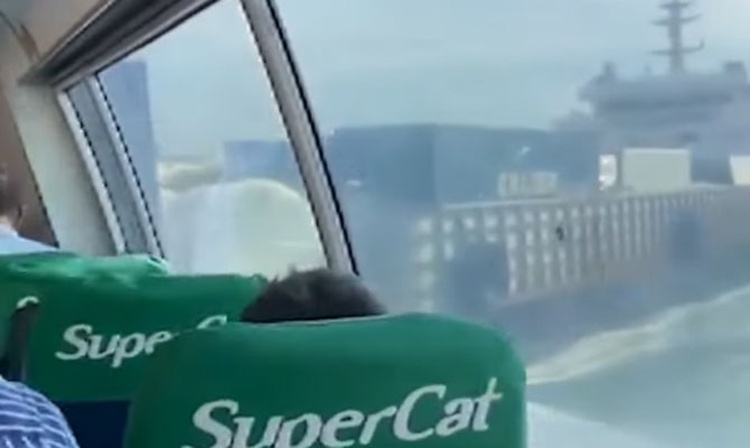
by Mikhail Voytenko
Ferry R10 capsized and rested starboard on pier and on bottom at Surat Thani port, Surat Thani Province, Thailand, Gulf of Siam, in the morning Apr 16. Ferry is linking Surat Thani with famous islands Samui and Pha Ngan, reportedly she lost stability and capsized during mooring, before boarding started. No injures reported. RAJA 10 is to be stabilized and refloated, already said ferry’s operator.
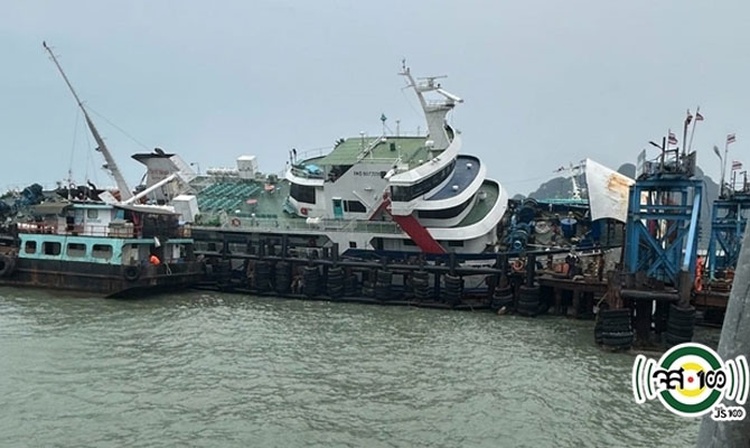 |
|---|
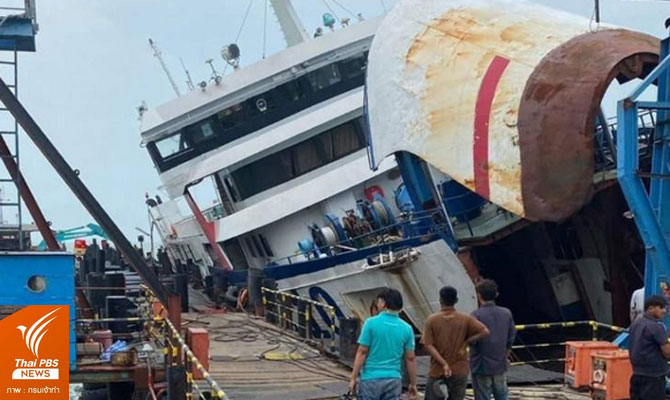 |
BY MARTIN SADONGDONG
On Friday, a Philippine landing craft struck a tugboat in the port of Cebu,
sinking the tug and claiming the life of one crewmember.
At about 1520 hours, the tug Nagasaka was towing the landing craft Jana Juliana
a few hundred yards off Colorado Shipyard, a repair yard located northeast of
downtown Cebu. The landing craft's port bow struck the tug, causing the tug to
sink, according to the Philippine Coast Guard.
The first crewmember to jump over the side was missing after the sinking, and
the PCG sent a dive team from Special Operations Group - Visayas to search the
wreck, without success.
First responders also deployed a boom around the wreck of the tug in order to
contain any potential spill, but only minimal sheening was observed.
On Saturday, fishermen from the city of Lapu-Lapu - on the other side of the
Mactan Channel - located the body of the missing crewmember, and the family has
confirmed his identity, according to the PCG.
Lt. j.g. Stephen Pagcaliwagan, a local spokesperson for the PCG, identified the
missing mariner as Joseph Villamor.
PCG rescues five Japanese fishermen in distress
In a separate incident over the weekend, the PCG rescued five Japanese crew
members from the Mongolian-flagged fishing vessel Catriona, which had taken on a
severe list off Navotas, Oriental Mindoro.
At about 0630 hours on Saturday, the PCG Command Center received word that the
Catriona was in distress, and watchstanders worked with PCG Station Oriental
Mindoro to launch a SAR operation. The crew of the patrol vessel BRP Habagat
located the distressed vessel and successfully rescued five Japanese crew
members, all in their 70s and 80s. These individuals were identified as Itsuo
Tamura, 86; Hiromu Nishida, 83; Hamagato Tsukasa, 80, Osamu Kawakami, 74; and
Hata Isamu, 74.
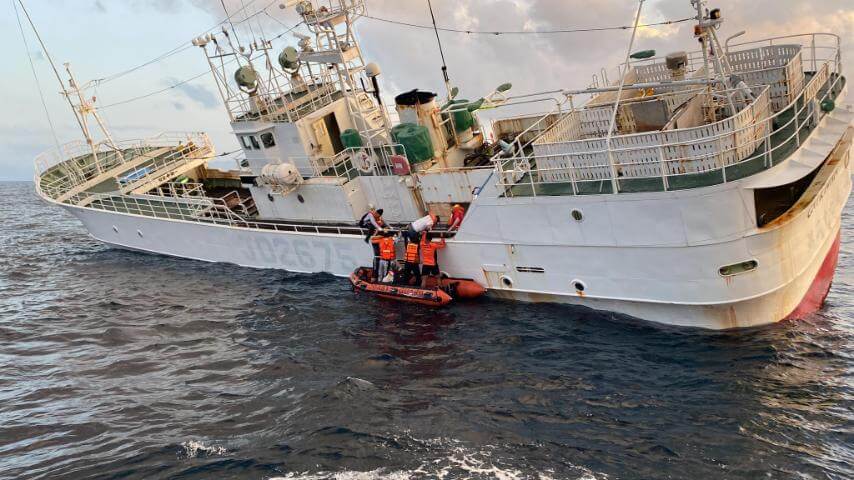 |
|---|
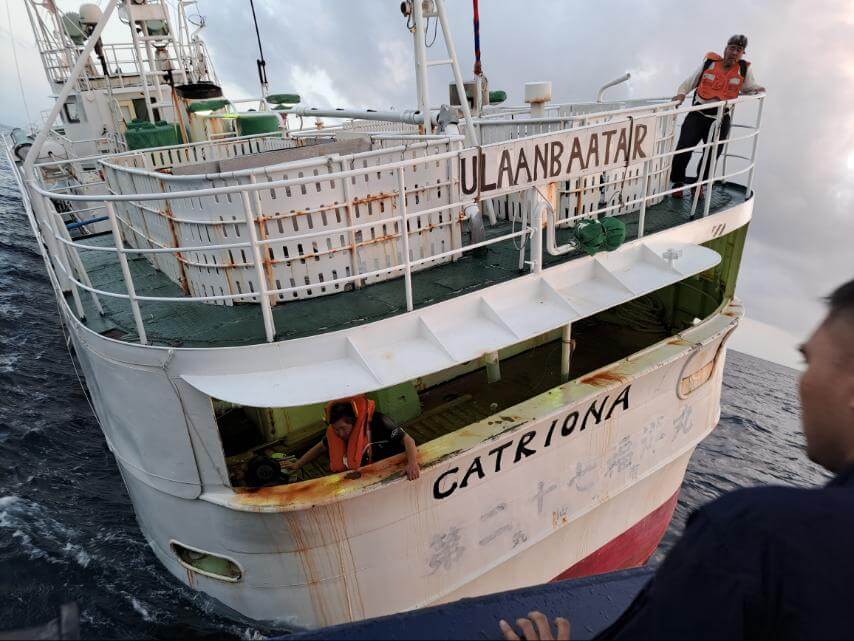 |
According to the crewmembers, they had departed Japan and were under way for Davao when the vessel ldeveloped a serious list.
The PCG SAR team performed a medical check-up on the survivors to ensure that they were in good physical condition.
The Catriona was taken in tow and brought back to a nearby port for a dive inspection.
MANILA, Philippines — Members of the Philippine Coast Guard rescued five Japanese crew members Saturday morning aboard MV Catriona in waters off Navotas, Calapan in Oriental Mindoro after encountering a maritime incident.
The foreign nationals said they departed Japan en route to Davao before their fishing vessel was accidentally damaged, causing it to list. They were later rescued at around 6:30 a.m.
"Upon receipt of the report from a transiting vessel, the PCG Command Center coordinated with the Coast Guard District Southern Tagalog and PCG Station Oriental Mindoro to conduct a search and rescue operations, " said the Coast Guard in a social media post.
Those rescued to by the BRP Habagat (TB-271) were the following:
- Isuo Tamura: 86-years-old
- Hiromu Nisiha: 83-years-old
- Hamgayo Tsukasa: 80-years-old
- Osamu Kawakami: 74-years-old
- Hayaan Isamu: 74-years-old
BY MARTIN SADONGDONG
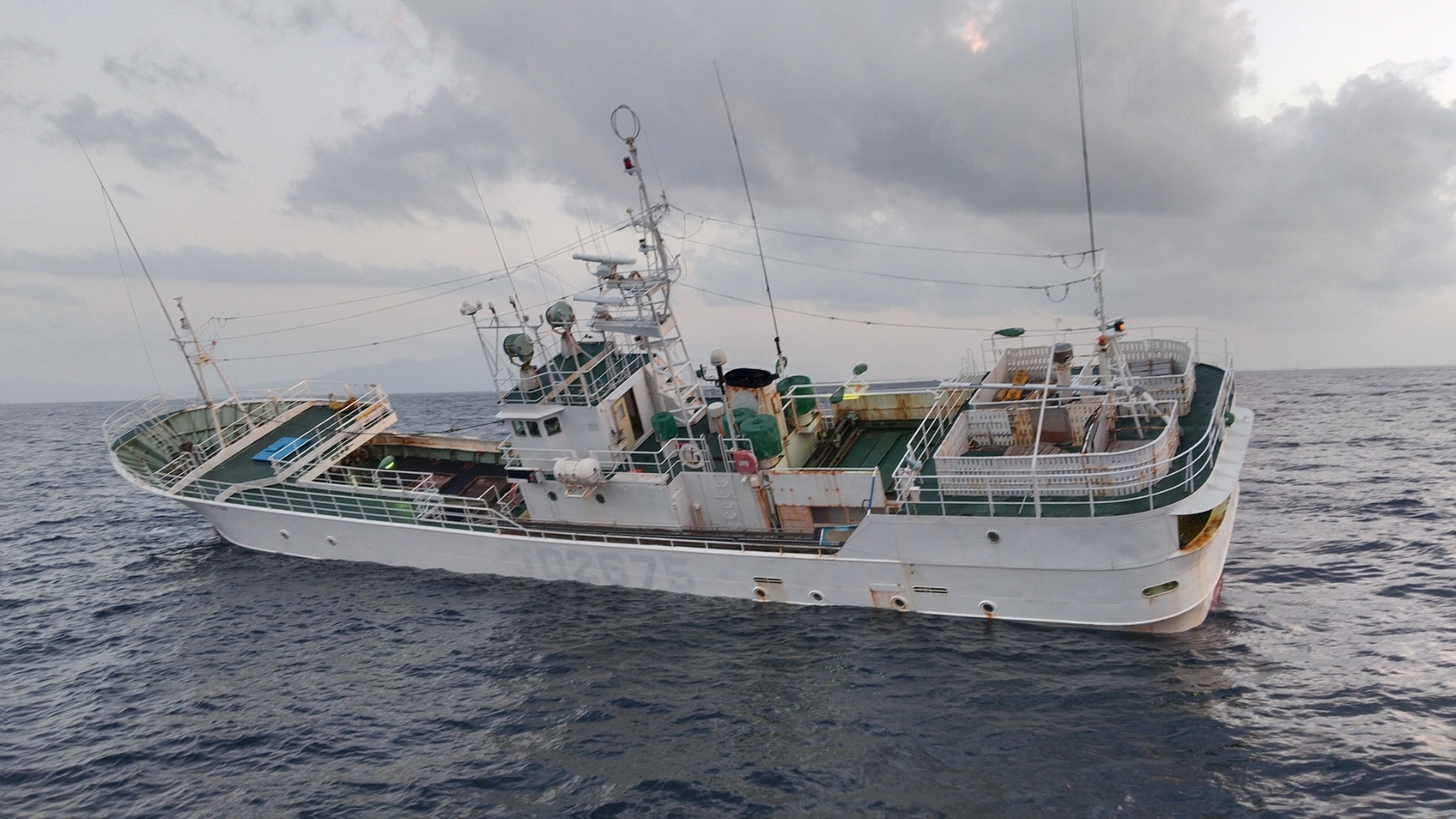
AT A GLANCE
- Five Japanese crew members of a fishing vessel were rescued by the Philippine Coast Guard (PCG) after they encountered a maritime accident off Calapan, Oriental Mindoro on Saturday morning, March 11.
- Rear Adm. Armando Balilo, PCG spokesperson, said MV Catriona encountered vessel listing at approximately 2.6 nautical miles northeast of Silonay Island in Calapan around 6:30 a.m.
- Photo: Philippine Coast Guard / PCG
Five Japanese crew members of a fishing vessel were rescued by the Philippine Coast Guard (PCG) after they encountered a maritime accident off Calapan, Oriental Mindoro on Saturday morning, March 11.
Rear Adm. Armando Balilo, PCG spokesperson, said MV Catriona encountered vessel listing at approximately 2.6 nautical miles northeast of Silonay Island in Calapan around 6:30 a.m.
Listing occurs when a vessel tilts to one side after taking in water.
The PCG identified the rescued crew as Osamu Kawakami, 74; Itsuo Tamura, 86; Hata Isamu, 74; Hiromu Nishida, 83; and Hamagato Tsukasa, 80.
“According to the Japanese crew members, they departed Japan en route to Davao. While underway, MV Catriona was accidentally damaged, causing the vessel to list,” Balilo said in a statement.
Balilo said the vessel had a hole in it which caused water to seep in.
A transiting vessel sighted the tilted MV Catriona and reported its condition to the PCG.
After receiving the report, the PCG Command Center coordinated with the Coast Guard District Southern Tagalog and Coast Guard Station Oriental Mindoro to conduct a search and rescue (SAR) operation.
The PCG deployed BRP Habagat (TB-271) until the SAR personnel located the vessel and the crew.
The PCG SAR team confirmed that the five Japanese crew members were in good physical condition. They were brought to Port of Calapan for further assessment.
By: Jean Mangaluz - Reporter / @JMangaluz

The MV Catriona in the waters off Oriental Mindoro where five Japanese crew members were rescued by the Philippine Coast Guard on Saturday, March 11, 2023. (Photo from the Philippine Coast Guard)
MANILA, Philippines — Five senior citizen Japanese crew members of a distressed vessel were rescued by the Philippine Coast Guard (PCG) on Saturday off the coast of Oriental Mindoro.
The PCG said that the MV Catriona was en route to Davao from Japan when it took in water and listed.
“The [PCG] has rescued five Japanese crew members on board MV Catriona that encountered a maritime accident (vessel listing) in the vicinity waters off Navotas, Calapan, Oriental Mindoro, at around 06:30 a.m. today,” the PCG in a Facebook post.
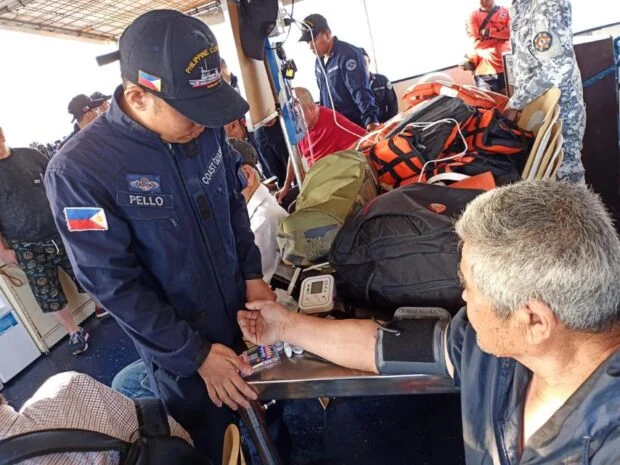
(Photo from the Philippine Coast Guard)
The PCG’s search and rescue unit and the BRP Habagat were dispatched to the area and rescued the Japanese seafarers – Itsuo Tamura, 86; Hiromu Nishida, 83; Hamagato Tsukasa, 80; Osamu Kawakami, 74 and Hata Isamu, 74.
“The PCG SAR team performed a medical check-up on the rescued individuals to ensure they remained in good physical condition,” the PCG said.
More details will be released in a progress report, the PCG added.
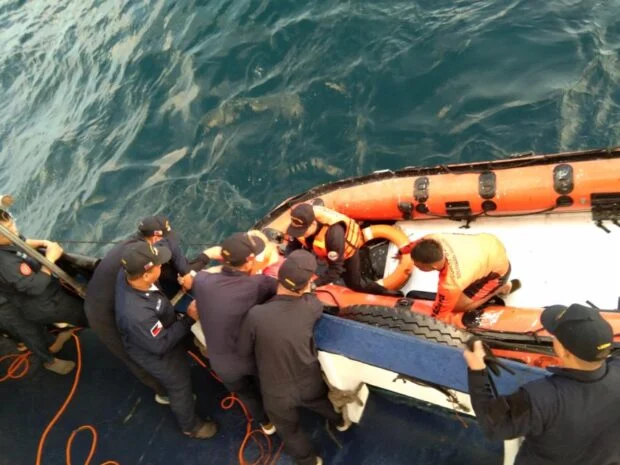
(Photo from the Philippine Coast Guard)
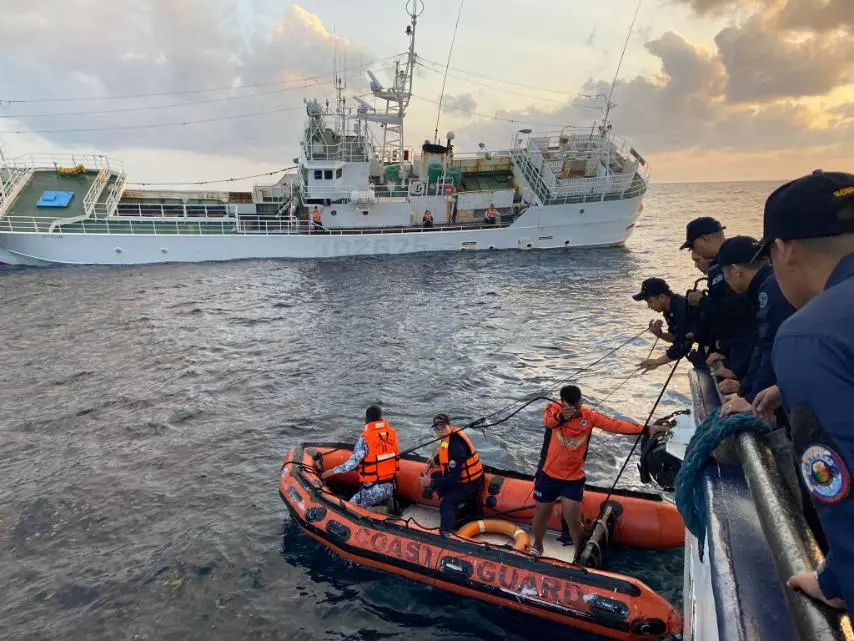
The Philippine Coast Guard (PCG) has rescued five Japanese crew members on board MV CATRIONA that encountered a maritime accident (vessel listing) in the vicinity waters off Navotas, Calapan, Oriental Mindoro, at around 06:30AM today, 11 March 2023.
Upon receipt of the report from a transiting vessel, the PCG Command Center coordinated with the Coast Guard District Southern Tagalog and PCG Station Oriental Mindoro to conduct a search and rescue (SAR) operation.
The PCG SAR team on board BRP Habagat (TB-271) successfully located the distressed vessel and carefully rescued the following Japanese crew members:
1) 86-year-old Itsuo Tamura
2) 83-year-old Hiromu Nishida
3) 80-year-old Hamagato Tsukasa
4) 74-year-old Osamu Kawakami
5) 74-year-old Hata Isamu
According to the Japanese crew members, they departed Japan en route to Davao.
While underway, MV CATRIONA was accidentally damaged, causing the vessel to list.
The PCG SAR team performed a medical check-up on the rescued individuals to ensure they remained in good physical condition.
Uei Maru (ex-Oei Maru). IMO 8810334. Length 70 m, 757 t. Mongolian flag. Unknown classification
society. Built in 1988 in Saiki (Japan) by Miura. Owned since November 2020 by Forward Marine Ltd
(Hong Kong, China).
She was reportedly scrapped in Ningde (China) in September 2016 but actually escaped the
blowtorches. Her Automatic Identification system has been switched off since February 2017. Though,
she has kept on sailing, flying the flag of Belize then of Sierra Leone and performing undisclosed traffics.
Since November 2020, she has been inspected eight times in the Vietnamese port of Quangninh. The 28
reported deficiencies did not lead to any detention. In September 2022, Hong Kong (China) inspectors
reported 15 deficiencies. Six were related to fire safety, emergency systems, safety of navigation and to
maintenance of the ship and equipment and were considered as grounds for detention. The Uei Maru
was finally beached in Chattogram flying the flag of Mongolia on October 13, 2022.
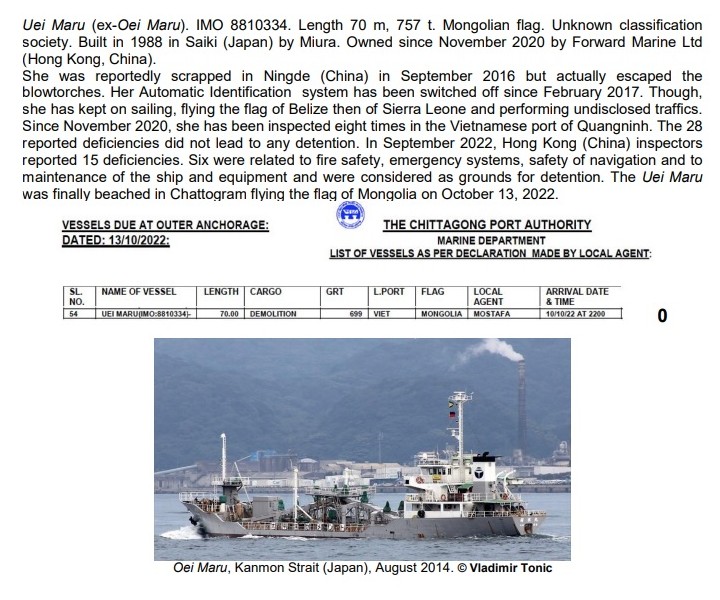
乗船していた日本人は全て日本人で、最年少の船員は74歳らしい。命をかけて一生懸命にお金を稼ぐ選択に対しては、日本政府は称賛するべきかもしれない。
傾いたモンゴル籍船「CATRIONA」が安全でない可能性が高い。多くのモンゴル籍船はサブスタンダード船である可能性は高い。日本から売船されてシンガポールへ向かっていたモンゴル籍船小型タンカーTJ88(99トン)は2013年に沖縄で座礁し、放置され続けている。
ヤフーコメントに下記のようなコメントがあった。
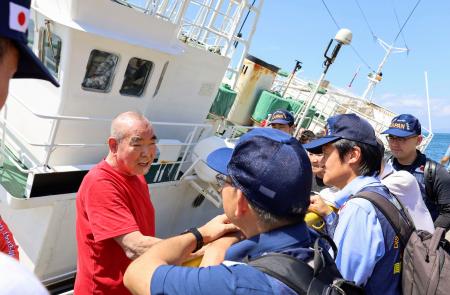
11日、フィリピン・カラパンの港で日本大使館員らに経緯を説明する
漁船船長の川上修さん(左)(共同)(KYODONEWS)
【カラパン共同】フィリピン沿岸警備隊は11日、ミンドロ島北部カラパン沖を航行中に船体が大きく傾いた漁船から73~86歳の日本人乗組員5人を無事救出した。船長の川上修さん(74)=長崎県長与町=によると、この漁船を長崎市の企業から中古で購入したフィリピン人に引き渡すため、2月17日に宮城県気仙沼市を出港し、ダバオに向かっていた。
川上さんによると、船は11日午前0時ごろに傾き始め、無線で救助を要請。最大約35度まで傾斜したが、午前6時半ごろ、沿岸警備隊員がゴムボートで近づき助け出した。5人とも元気な様子。船体が傾いた原因は分かっていない。
船員らは長崎市と静岡県の在住。
By MI News Network
A general cargo vessel has recently sunk in the waters of the Taiwan Strait, but its eight crew members were successfully rescued.
PTS, the Taiwanese broadcaster, said on Monday an unnamed Mongolia-flag vessel had begun taking on water via a hole in the bottom of the hull.
The vessel gave a distress call when it was 90 nm toward the west of Kaohsiung, capsizing later on to the port side.
The seafarers, wearing lifejackets, fell into the sea, but Taiwan’s Coast Guard helicopters soon came to the rescue, winching the crew members to safety. The vessel sank fast, PTS reported.
One of the crew members was rushed to the hospital as he was suffering from severe hypothermia.
Video footage reflects seafarers gathered at the vessel’s stern as it lists.
One is then seen to be lifted into a chopper from what seems like a couple of lifeboats.
An examination of the accident has been started.
AIS data reflects that the most likely candidate is the 1,600-dwt Sunshine, the ex-Hao Feng that was out of range on 15 January, halted in the Taiwan Strait.
NCS Properties of Malaysia owns the vessel. The Sunshine was last detained after a port state control examination in 2019 with about 17 deficiencies.
Causes for detention included faults with the emergency fire pump, charts, lifeboats, and also weather-tight cargo ports and doors.
A general cargo ship has sunk in the Taiwan Strait, but all eight crew members were rescued.
Taiwanese broadcaster PTS said an unnamed Mongolia-flag vessel began to take on water through a hole in the bottom of the hull on Monday.
The ship sent out a distress call when it was 90 nautical miles west of Kaohsiung, later capsizing to the port side.
The seafarers, all wearing lifejackets, reportedly fell into the sea, but Taiwan Coast Guard helicopters came to the rescue, winching the men to safety.
The vessel then sank quickly, PTS added.
One of the crew members was taken to hospital suffering from hypothermia.
Video footage shows seafarers gathered at the stern of the vessel as it lists.
One is then seen being lifted into a chopper from what appears to be a couple of lifeboats.
An investigation has begun into the accident.
AIS data suggests the most likely candidate is the 1,600-dwt Sunshine (built 1985), the ex-Hao Feng, which was out of range on 15 January, stopped in the Taiwan Strait.
The vessel is owned by NCS Properties of Malaysia, which could not be contacted.
The Sunshine was last detained following a port state control inspection in 2019 in China with 17 deficiencies.
Grounds for detention included faults with charts, the emergency fire pump, lifeboats and weathertight cargo ports and doors.
by Mikhail Voytenko
Cargo ship in Taiwan Strait 90 nm west of Kaohsiung reported water ingress, developing portside list, and requested assistance, in the morning Jan 16. Some or all had to jump into water, but fortunately, all 8 were rescued, understood by helicopter, all are safe, some suffering hypothermia. The ship capsized and sank. She wasn’t identified, but according to all available data, it is most probably, general cargo ship HAO FENG, last AIS position received sometime between 2200 – 2300 UTC Jan 15.
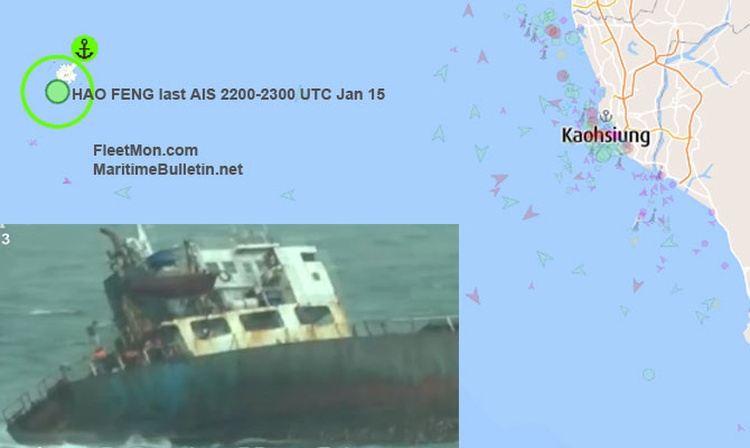
【ソウル聯合ニュース】アジア太平洋地域で船舶への検査をモニタリングする国際組織「東京MOU」の最新報告書によると、2020年に安全検査を実施した北朝鮮の船舶13隻すべてから1件以上の欠陥が見つかった。このうち、2隻については問題解決まで船舶の運航を中止とする停船措置を出した。
また、北朝鮮をブラックリストに掲載し、北朝鮮船舶に対し、他国より高い比率で安全検査を実施するようにした。
ブラックリストに掲載された国は北朝鮮のほか、トーゴ、シエラレオネ、モンゴル、ジャマイカ、パラオ、キリバスの7カ国。
北朝鮮船舶は大多数が火災安全や救助装備、非常システムの不備で検査をクリアできなかったという。経済難や制裁により老朽化した船舶を廃棄・修理できず、運用を続けるしかなかったためとみられる。
北朝鮮船舶に対する安全検査は2016年に275隻、17年に185隻、18年に79隻、19年に51隻と減り続け、昨年は新型コロナウイルスの影響で13隻まで落ち込んだ。
by The Editorial Team
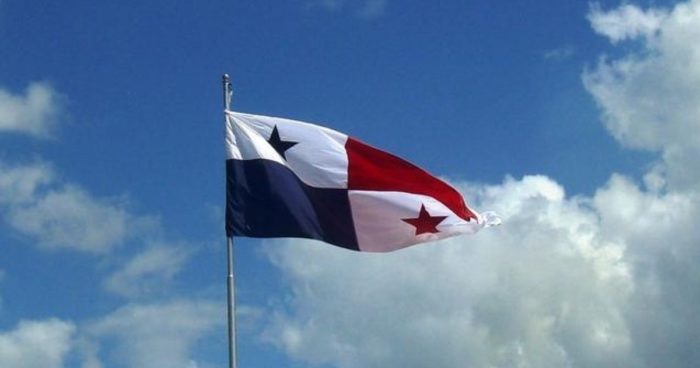
In addition, the report resulted to the fact that Chinese nationals with close links to North Korea’s illicit shipping networks have acted as surveyors for vessels registered under the Panamanian flag, and possibly the Mongolian flag, thereby potentially providing an avenue for North Korean-linked vessels to obtain flags of convenience and other maritime services prohibited under UN Security Council resolutions.

Moreover, a number of Chinese nationals with extensive links to North Korea’s illicit shipping fleet have acted as vessel surveyors for Recognized Organizations such as Panama Maritime Documentation Services and even operated their own classification agency named the International Marine Survey Association.
The report highlights that
Several links between these entities and individuals such as shared emails, phone numbers and addresses also suggest that Fan, Dong, Zhang and the companies and organisations they operate are much more closely connected than may at first appear on the surface.
In conclusion, James Byrne, the report’s researcher, resulted to the fact that Fan’s, Dong’s and Zhang’s employment with, and operation of, Recognized Organizations and Classification Societies may therefore help explain how some North Korean-linked vessels have been able to avoid scrutiny and continue operation as foreign-flagged vessels.
Sam Chambers
The world’s largest shipping registry has been embroiled in a scandal involving sanctions-busting North Korea.
A 27-page report from the Royal United Services Institute (RUSI), a UK security think tank, highlights how three individuals from the Chinese port city of Dalian have been working for entities entrusted by both the Panamanian and Mongolian flags to survey ships and authorise certificates, including for a number of North Korean-linked vessels.
The three men – Fan Mintian, Dong Changqing, and Zhang Qiao – stand accused of helping the Kim Jong Un regime flout sanctions.
RUSI found that Fan and Dong have worked as surveyors for an organisation authorised by Panama called Panama Maritime Documentation Services (PMDS), and have provided various certificates to North Korean-linked ships.
Fan and Dong were embroiled in an earlier North Korean illegal shipping incident when the vessel Light, managed by their company Dalian Sea Star Ship Technology, was “suspected of transporting North Korean missile technology to Myanmar”.
PMDS was also found to share an address and other contact details in Dalian, a city located near the North Korean border, with Fan and Dong’s companies, as well as another surveyor authorised by Mongolia called International Maritime Survey Association (IMSA), established by Zhang Qiao.
The report concluded that the business connections provided by the three men from Dalian could provide “an avenue for North Korean-linked vessels to obtain flags of convenience and other maritime services prohibited under UN Security Council resolutions.”
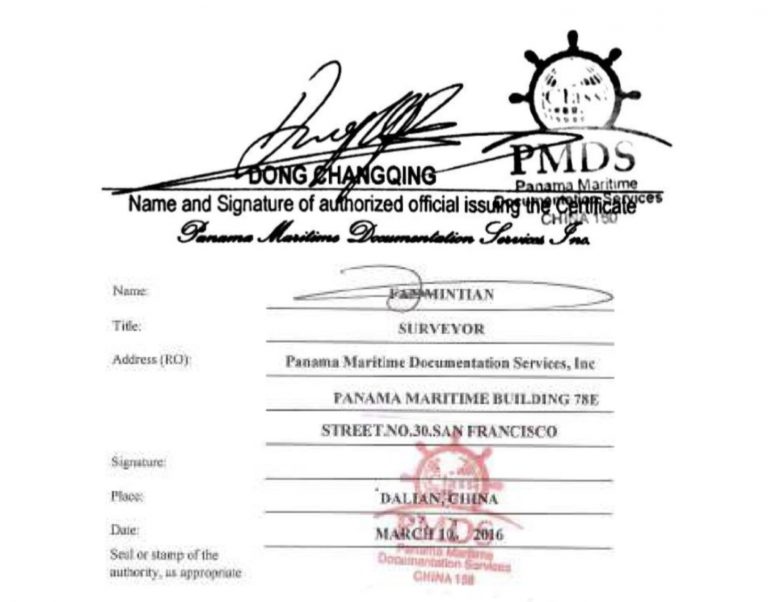
PROJECT SANDSTONE The Sailors of Panama James Byrne (safety4sea)
★開けない人はここをクリック
In the second report of its Project Sandstone, this article from RUSI uncovers further links between Chinese nationals involved in the Jie Shun incident and North Korea’s illicit networks. This second report looks at Fan Mintian, Dong Changqing and Zhanq Qiao – 3 Chinese nationals who have appeared in the UN Panel of Experts investigations into North Korea’s sanctions evasion activities and several other reports linking them to flag registries, and oil, coal and iron ore smuggling networks. Both Fan and Zhang were also described as key players in the Jie Shun incident by the Panel of Experts. The report indicates that Chinese nationals with close links to North Korea’s illicit shipping networks have acted as surveyors for vessels registered under the Panamanian flag – and possibly the Mongolian flag – thereby potentially providing an avenue for North Korean-linked vessels to obtain flags of convenience and other maritime services prohibited under UN Security Council resolutions. It is also said to reinforce the conclusion that several individuals with extensive links to North Korea’s illicit shipping networks have operated across a wide number of roles in the maritime industry, from directly owning and managing vessels, to the provision of international safety management services, as well as flagging and certification services required to operate a foreign-flagged vessel in international waters. Fan Mintian and another man worked as authorised officials for Panama Maritime Documentation Services, an organisation empowered by the Panamanian Maritime Authority to conduct surveys and certification of Panamanian-flagged vessels.
OCEAN GROW (IMO: 8355683)が中国で2022年5月26日に出港停止命令を受けている。建造が2008年5月なのにIMO番号は8355683と言うとても胡散臭いコンビネーション。普通IMO番号が83で始まれば建造は1980年代になると思う。そして、IMO:8355683で検索しても過去の船名が出てこない。しかし、国際総トン数は26682トン。とても怪しく思える船だと思う。

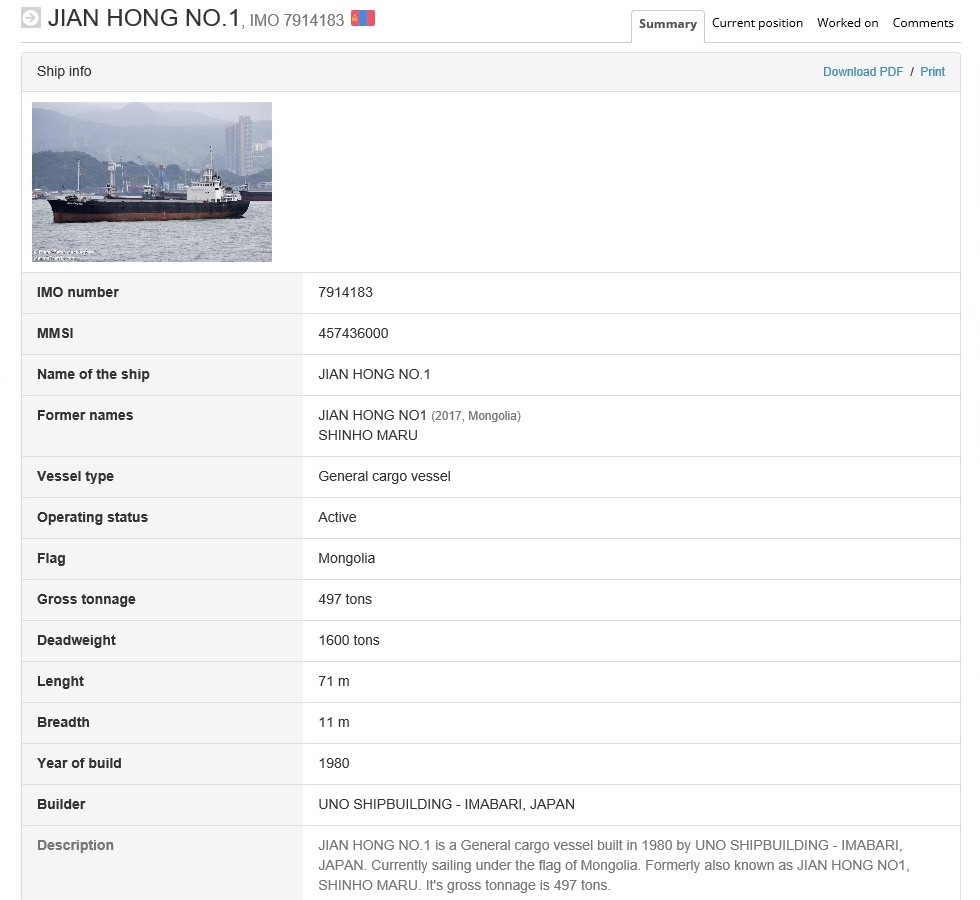
M/V JIAN HONG No.1(BALTICSHIPPING.COM)
| From(Maritime Connector.com) | |
|---|---|
| Ship Name: | JIAN HONG 1 (EX-SHINHO MARU) |
| IMO: | 7914183 |
| Type of ship: | GENERAL CARGO |
| Flag: | MONGOLIA (EX-TAIWAN) |
| Gross tonnage: | 497 tons |
| Year of Built: | 1980 |
| Builder: | UNO SHIPBUILDING - IMABARI, JAPAN |
| Manager & Owner: | SHIP FOR SALE |
Posted in Accidents by Mikhail Voytenko
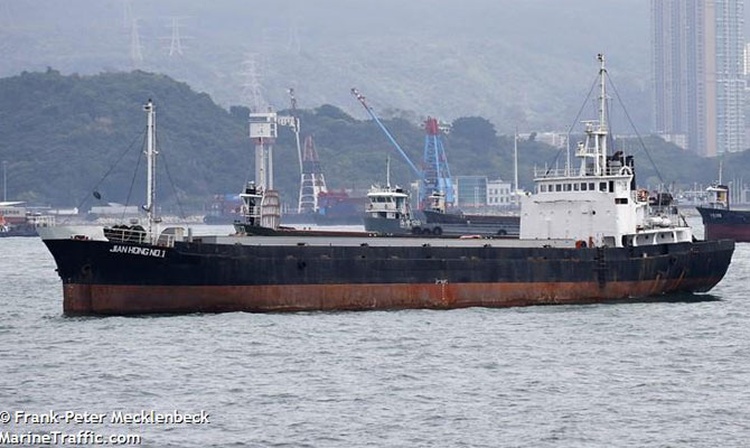 Jan 30: In initial news based on Taiwanese sources it was said, that Taiwanese rescuers and Navy were deployed in SAR, understood all 10 crew rescued. On Jan 30, however, both Chinese and Taiwanese media said SAR is a joint operation carried out by Chinese and Taiwanese forces.
Jan 30: In initial news based on Taiwanese sources it was said, that Taiwanese rescuers and Navy were deployed in SAR, understood all 10 crew rescued. On Jan 30, however, both Chinese and Taiwanese media said SAR is a joint operation carried out by Chinese and Taiwanese forces.
The number of crew on sunk ship is unclear, Taiwanese sources mention 10, Chinese sources mention 11 people. Latest news said two crew, including one Taiwanese and one Indonesian, were rescued, eight remain missing, SAR still going on.
Initial news published on Jan 29
The ship with cargo of sugar was en route from Taichung Taiwan to South Korea, she sank some 80 nm northwest of Taipei, somewhere halfway between northern Taiwan and Wenzhou, China.
Cargo ship JIAN HONG 1 issued distress signal at night local time Jan 28, some 80 nm north of Taipei, Taiwan, East China sea. Taiwanese rescuers and military were alerted at 2203 LT, and sent helicopters to sinking ship. All 10 crew were rescued, among them 1 Chinese nationality, 5 Indonesians and 4 Myanmar. Understood but not confirmed the ship sank. Latest available AIS dated Jan 27, the ship left Taichung Taiwan and was sailing north along northwest Taiwan coast.
フェリーおおさか改装中: GOLDEN BIRD 5 (Passenger registered in Mongolia)IMO 9021382 (何でも図鑑)
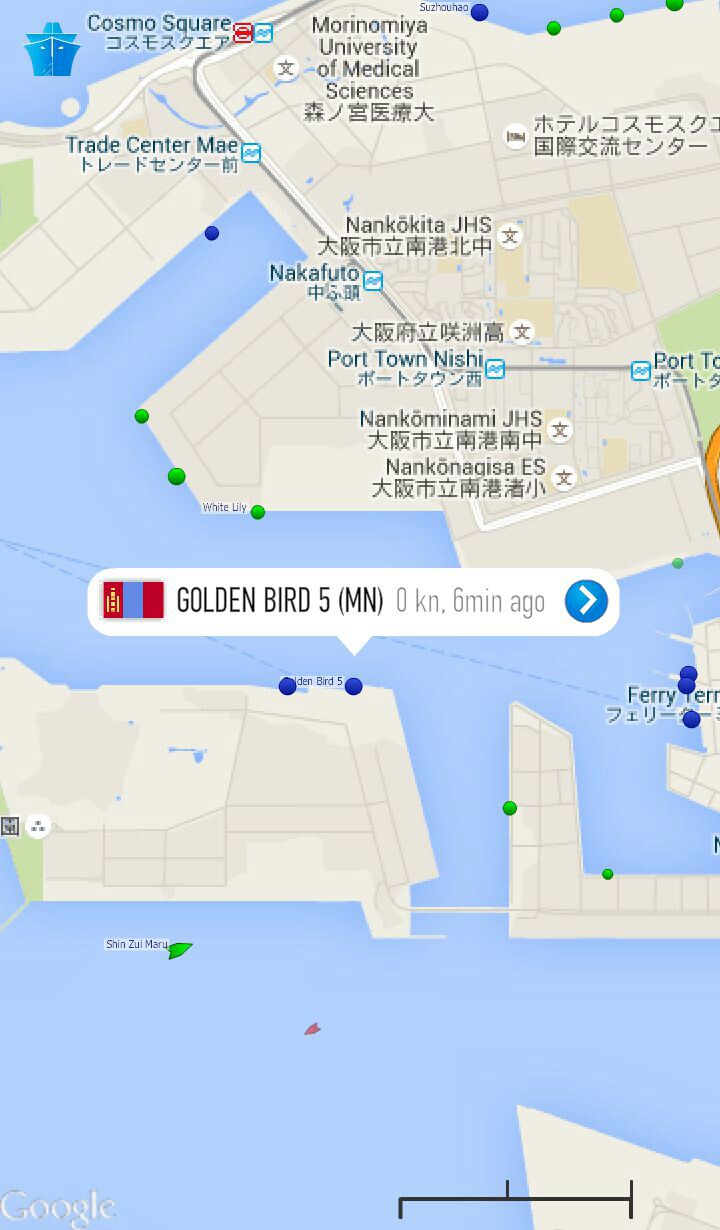
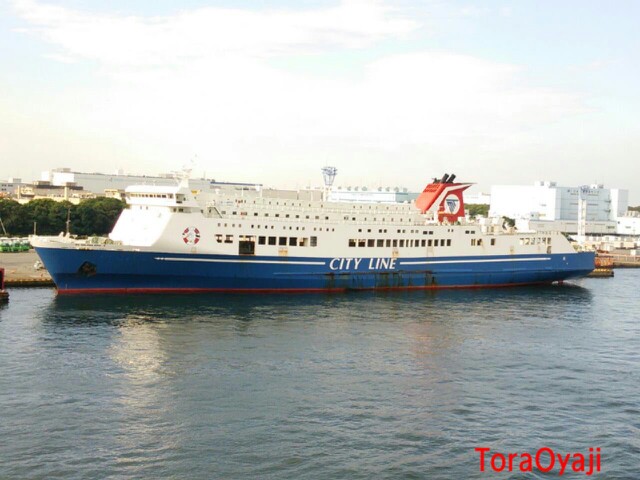
出港しているのに日本の国旗。ダミー作戦?海保は何も言わない?
日本とモンゴルは姉妹国家となって日本はモンゴル船籍船に日本国旗の使用を許可したのか?
動画に映っていないだけかもしれないが、IMO番号が船体に記載されていない。
ISPS(国際保安)コード違反?
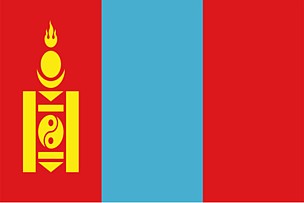
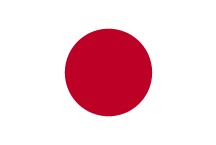
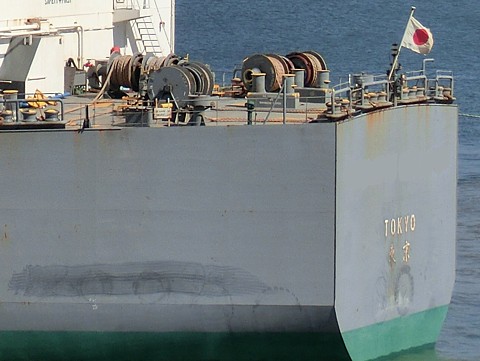
日本船籍の外航船。日本の国旗を掲げている。
GOLDEN BIRD 5 - Passenger/Ro-Ro Cargo Ship IMO 9021382 (VesselFinder)
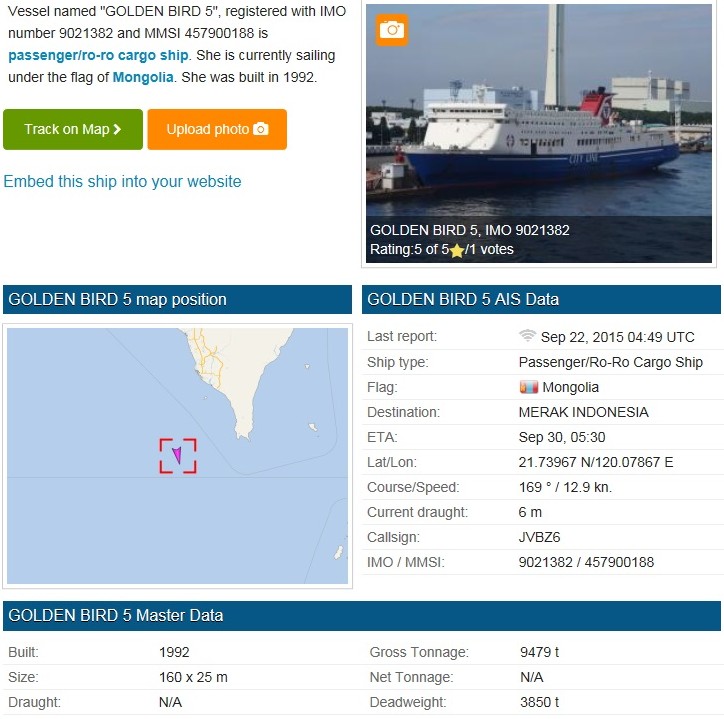
REINA KLEOPATRA 第五櫻島丸(IMO:8920737):売船先はフィリピンとのことです。 (今日のかごしま港)
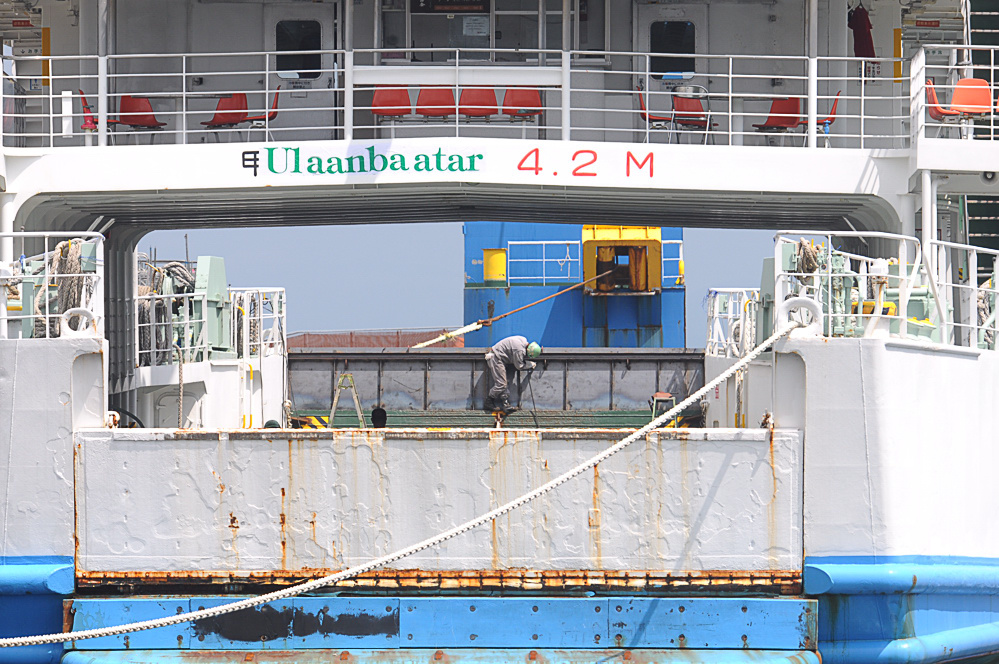
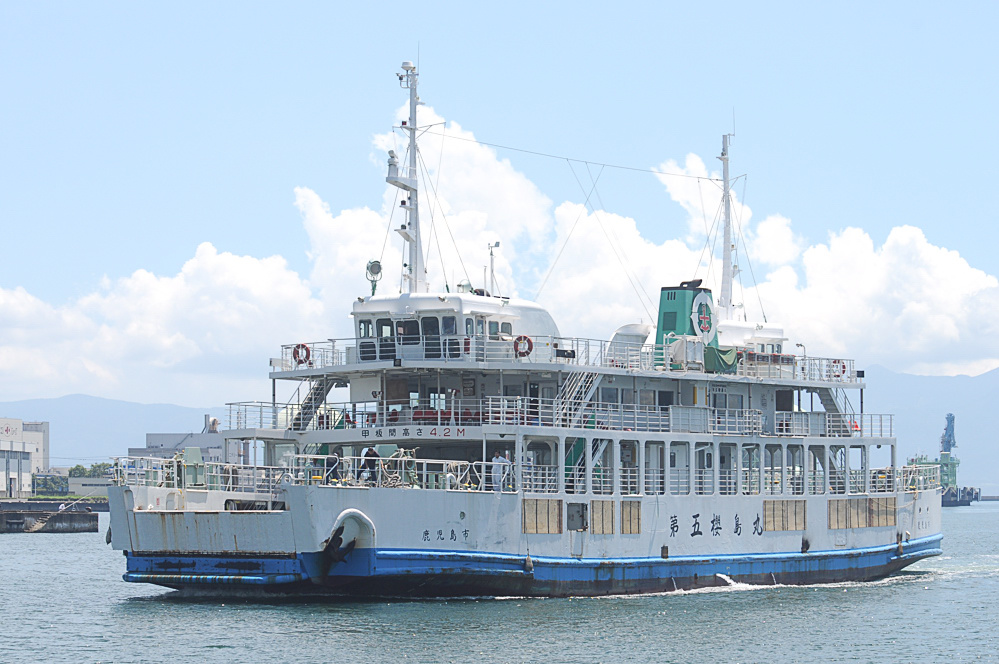
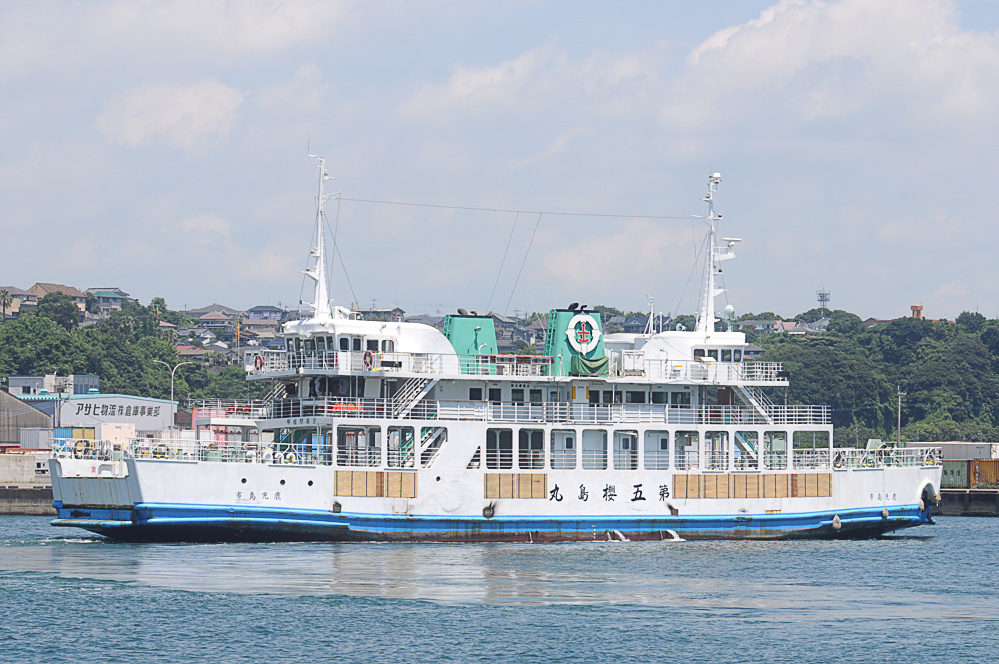
【ウランバートル=藤本欣也】モンゴルのムンフオリギル外相は27日、産経新聞のインタビューに応じ、モンゴル政府が国連安全保障理事会の対北朝鮮制裁決議を順守し、「国境や通関の管理を強化して、北朝鮮に向かう物資や車両を厳しく規制している」と指摘、これまでに「モンゴルの旗で運航していた北朝鮮船舶17隻の登録を取り消した」ことを明らかにした。
朝鮮半島の非核化などに向けてモンゴル独自の外交も展開していると強調。外務次官を団長とする代表団を5月中旬に北朝鮮に派遣し、李容浩(リ・ヨンホ)外相らと会談するなど「高官レベルの協議を続けている」という。
ウランバートルでは今月15日、滝崎成樹・外務省アジア大洋州局審議官と北朝鮮のリ・ヨンピル外務省米国研究所副所長が接触。滝崎氏は全拉致被害者の一日も早い帰国を求めている。
ムンフオリギル氏は「日朝両国は接触と対話を継続することが必要だ。そのためにモンゴル政府はいつでも協力できる」と語った。
中国をめぐっては、昨年11月にチベット仏教最高指導者、ダライ・ラマ14世がモンゴルを訪問して関係が悪化。ムンフオリギル氏が2月に訪中し王毅外相と会談、「チベットは中国の不可分な一部」と明言して関係を修復した経緯がある。
モンゴルにはチベット仏教の信者が多い。ダライ・ラマが今後、モンゴルを訪問する可能性に関しては「現政府はNOだが、将来の政府がどうするかは分からない」と含みを残した。
モンゴルが便宜置籍(実際の所有主の国籍を隠すために第3国の旗を付けて運航)方式でモンゴルの旗を付けて運航してきた北朝鮮船舶の登録をすべて取り消したと、ボイス・オブ・アメリカ(VOA)放送が3日報じた。便宜置籍は海運業界で通用する慣行。モンゴルは内陸国だが、400隻以上の海外船舶が自国船舶として登録するのを認めてきた。
VOAによると、モンゴル政府は先月8日、国連安全保障理事会対北制裁委員会に提出した安保理決議2270号履行報告書で、「北朝鮮船舶14隻の登録を取り消した」と明らかにした。また、履行報告書提出時点を基準にモンゴルの旗を付けた北朝鮮船舶は1隻も残っていないと明示した。政府当局者は「便宜置籍ができなければ北の旗を付けるしかないが、この場合、国際社会の監視のため自由な運航が事実上難しくなる」と説明した。
2270号採択後に北朝鮮の便宜置籍船の登録が取り消されたのは今回が初めてではない。今年6月現在、2270号が資産凍結対象に指定した北朝鮮遠洋海運管理会社(OMM)の船舶27隻のうち6隻の登録が抹消された。シエラレオネ・カンボジア・タンザニア・パラオなどが自国船舶として登録されていたものを取り消した。国際海事機関(IMO)も加盟国に6隻の再登録を禁止するという文書を回覧させた。またモンゴルは3枚分の履行報告書で「モンゴル国営銀行に設置された金融情報チームが対北朝鮮金融制裁違反がないか常時監視している」と強調した。
2270号が定めた制裁ではないが、人員送出を通じた北朝鮮の外貨稼ぎにも国際社会がブレーキをかける雰囲気だ。中東や欧州で北朝鮮の海外労働者を本国に送りかえす事例が相次いでいる。地中海の島国マルタは最近、北朝鮮労働者に対するビザ延長および再発行を中断した。これに先立ち、数百人の北朝鮮労働者が働いているポーランドも、北朝鮮の4回目の核実験以降、新規ビザを1件も発行していないと明らかにした。
しかし高高度ミサイル防衛(THAAD)体系配備が決定した後、中国が対北朝鮮制裁から離脱する可能性があるという懸念が持続的に提起されている。最近、朝中国境地域を訪問した対北朝鮮消息筋は「2270号採択直後と比較すると、北と中国を行き来する人と物資が増えたのが分かる」とし「制裁の履行がやや弱まった雰囲気だった」と伝えた。
Rizhao, Chinaで中国のPSC(外国船舶監督官)に出港的に命令を受けている。

TOKYO MOU
|
| |
|---|---|
| Ship Name: | ORIENT PIONEER (EX-WAN RUN) |
| Type of Ship: | BULK CARRIER |
| Flag: | MONGOLIA (EX-PANAMA) |
| IMO: | 8665818 |
| Gross Tonnage (ITC): | 15847 tons |
| Year of Built: | 1986 |
| Builder: | SHIN KURUSHIMA ONISHI SHIPYARD - IMABARI, JAPAN |
| Class Society: | FORESIGNT SHIP CLASSIFICATION (EX-NIPPON KAIJI KYOKAI) |
| Manager & owner: | PAN-FLYING SHIPPING LIMITED (EX-WAN JIA INTERNATIONAL SHIPPING & TRADING - HONG KONG, CHINA) |
| Former names: |
HATTIE until 2013 Jun HONOR until 2007 Jan MARIN TRADER I until 1997 Nov MARATEA until 1987 |
マレーシアで出港停止命令を受けたモンゴル船籍INAI MERAH (IMO: 8662452)は問題のある曰くつきの船のようだ。
ASIAN TRADER (Ex-CONG THANH 86, IMO 8665818, Mongolia flag)がシンガポールで2015年3月24-27日までPSC(外国船舶監督官) に出港停止命令を受けた。IMO番号がIMO8665818で2007年建造なのだ。この船、リビルトなのでは???と思い、調べたが情報がない。 あやしいと思った。
|
| |
|---|---|
| Ship Name: | CONG THANH 86 |
| Type of Ship: | GENERAL CARGO |
| Flag: | VIETNAM |
| IMO: | 8665818 |
| Gross Tonnage (ITC): | 1352 tons |
| Year of Built: | 2007 |
| Builder: | THANH LONG SHIPBUILDING - HAIPHONG, VIETNAM |
| Class Society: | VIETNAM SHIPPING REGISTER |
| Manager & owner: | CONG THANH COMMERCIAL SERVICES - THAI BINH, VIETNAM |
【ニューヨーク=水野哲也】武器の運送に関わったとして国連安全保障理事会の制裁を受けた北朝鮮の貨物船運航会社が、本来は船を運航できないのに、制裁発動後、船名や運航会社名を変えて運航を続け、制裁を逃れていたことが25日、読売新聞が入手した国連北朝鮮制裁委員会の専門家パネル報告書で明らかになった。
英国の北朝鮮大使館職員が手続きしており、外交官も関与した制裁逃れの実態が明らかになった。
この会社は「オーシャン・マリタイム・マネジメント・カンパニー(OMM)」。同社は、キューバで分解された戦闘機やミサイル部品を積み込み、パナマ運河を通過しようとして2013年7月に拿捕だほされた貨物船を運航。北朝鮮への武器の輸出や移動を禁じた安保理決議に違反したとして、昨年7月、資産凍結などの制裁が発動され、貨物船を運航できなくなった。
ところが、報告書によると、制裁発動直後、同社が運航していた14隻のうち13隻の船名が次々と変わり、所有会社や運航会社名も変更されて引き続き運航されていた。国際海事機関(IMO)に対し、新たな名前や会社名を届ける手続きはロンドンの北朝鮮大使館職員が行っていたという。
北朝鮮の大手海運会社が国連安全保障理事会の制裁を受けた昨夏以降、自らが運航に関与した貨物船の船名や所有会社を次々と変更していたことが、25日わかった。対北朝鮮制裁の実施状況を監視する安保理の専門家パネルは、船名などの変更が制裁逃れの手段になっているとみて、制裁の強化を勧告している。
北朝鮮は、一連の核実験やミサイル発射を受けた安保理決議で、大量破壊兵器関連の物資技術や通常兵器の輸出入禁止、ぜいたく品の禁止、団体・個人の資産凍結など広範な制裁を受けている。
専門家パネルは今回、これまでの調査結果を報告書にまとめ、北朝鮮の海運会社オーシャン・マリタイム・マネジメント社(OMM社)を取り上げた。同社は、戦闘機を大量の砂糖袋の下に積んだ状態でパナマ政府に拿捕(だほ)された貨物船「清川江(チョンチョンガン)」の運航に関わったとして、昨年7月に安保理の下部組織「北朝鮮制裁委員会」から資産凍結などの制裁対象にされていた。
今月4日、全羅南道麗水市(チョンラナムド・ヨスシ)の巨文島(コムンド)から南東34カイリ(約63キロ)の公海上。北朝鮮船員16人が乗ったモンゴル国籍の4300トン級貨物船「グランドフォーチュン1号」が沈没した。
韓国の海洋警察は救助活動を行って5人を救助したが、2人は死亡し、追加捜索を行って1人の遺体を引き揚げた。救助された3人と遺体3体は板門店(パンムンジョム)を経由して北朝鮮に送った。海洋警察や麗水警察署などによれば、沈没した船は北朝鮮の清津(チョンジン)港から出発して中国揚州市近隣の江都港へ向けて航海中だった。重油50トンや鉄鉱石などが載っていた。韓国政府は14日、最後の遺体1体を北朝鮮に引き渡した。
グランドフォーチュン1号は海がない内陸国、モンゴル国籍の船だった。船主は香港にある会社だった。海洋水産部などは船主が「便宜置籍」の一環としてモンゴルに船を登録して賃金が安い北朝鮮船員を雇用し、貨物事業を展開していたと推測した。
便宜置籍は、自国船員の義務雇用比率を避けて税金節約のために他国に船を登録することをいう。それ自体は違法ではない。パナマやリベリア国籍の船が多いのは便宜置籍が多い国だからだ。
モンゴルは内陸国だが2003年から船舶登録局を開設して他国の船の登録を受けている。船舶登録を受けて税金を集めて海運産業を育成するためだ。ウィキリークスが2007年に公開した米国大使館の資料によれば、モンゴルには283隻が登録されている。船の主人の国籍はシンガポール(91隻)、パナマ(22隻)、マレーシア(22隻)、香港(12隻)などだった。船主が国籍不明な船も39隻あった。
北朝鮮が香港会社を代理船主として前面に出し、モンゴルに船を登録した可能性を見せている部分だ。外交部関係者は「今回のグランドフォーチュン号は、韓国領海ではない公海上で発見されたので対北朝鮮制裁決議にともなう船舶の捜索や調査を行えなかった」として「すぐに目についた重油や鉄鉱石のほかに、どんな物があったのかは確認できなかった」と話した。
先月出てきた国連安保理の対北朝鮮制裁の専門家パネル報告書によれば、国籍は北朝鮮ではないが実際は北朝鮮の船と疑われるものが最低8隻以上だった。このうちスンリ2号、グンザリ号、クァンミョン号の3隻は、今回発見されたグランドフォーチュン1号のようにモンゴルに登録されている。他国の国籍を持っており、船主は香港人である船も1隻あった。
国連対北朝鮮制裁の専門家パネルは報告書を通じて「安保理の対北朝鮮制裁決議2094号(2013年)が発効された後、北朝鮮は船舶を再登録したり国籍を変更したりして制裁を避けようとする可能性が高い」と指摘した。実際に北朝鮮は昨年だけで4隻の船をカンボジア・トーゴなどに国籍を変更した。
このような前例もある。2011年5月、北朝鮮の南浦港(ナムポハン)からミサイル武器などと推定される部品を載せてミャンマーへ向かった「ライト」号は、米国海軍の追撃を受けると公海上にとどまって回航した。ライト号は2006年まで「ブヨン1号」という名前を使う北朝鮮国籍の船舶だったが、北朝鮮核実験後に対北制裁が激しくなると名前を「ライト」に変えて国籍も中米のベリーズに変更して運行した。「ライト」号は米国の取り締まりがあってから2カ月後、アフリカのシエラレオネで国籍を変えて船の名前も「ビクトリー3号」に変更した。国連の対北朝鮮制裁の専門家パネルは、国籍を「洗浄」した北朝鮮の船が19隻以上に上ると推定している。
今回は、モンゴル船籍の漁船が韓国で外国の船主に売られ、韓国から出港して石垣島川平湾沖に座礁した。
問題は、サブスタンダード船、サブシッピング業界
そして問題のある旗国に対して厳しい対応を取っていない事。厳しい対応を取っていると言うのであれば、
まだ甘いと言う事。
ブラック リスト及びブラック リストに近い
グレーリストの国籍の船舶を最優先に検査する国内法を制定しない限り、このような問題は減らない。
船が座礁し、放置船となるまで、日本の自治体は他人事の考えて対応しない。それも問題である。
同じ事が繰り返されているにも拘わらず、適切な対応が取られない。
今回の座礁及び放置で強調されたのは、「保険契約違反で保険の適用も受けられない」。つまり、改正船舶油濁損害賠償保障法で
要求される保険に船が加入しても、サブスタンダード船である事が保険契約違反であると判明すれば
保険の適用を受けられない事。
本年 9月27 日、台風 17 号の影響で石垣島川平湾沖に座礁した外国漁船(119 トン、モゴル船籍主イラ)の撤去が、船主との交渉が難航しており、撤去作業の目処がたっいない。
外国漁船が座礁した川平湾は、西表石垣立公園の指定地域で、国の名勝に指定されている石垣島を代表す景勝地である。
また、石垣島には沖縄県で唯一指定されている保護水面が2箇所あり、外国漁船が座礁した場所は、その保護水面指定地域となっている。
当市では、座礁した外国漁船から油が流出め、総量 2万550リット ルの油抜き取り作業を行い、その費用360万円を一時立て替えるなどの他、 当該漁船の現状悪化を防ぐ対策等も行っているが、 座礁した外国漁船の状態は、日に日に悪化しており、高波で横転たすると更莫大な撤去費用を要することになり、過去の外国船籍座礁船の事例にあるように放置となれば、川平湾の景観や保護水面海洋生物に多大な悪影響を及ぼすことになる。
座礁した外国漁船が、籍籍、船主とも外国で、保険契約違反で保険の適用も受けられないことから、地方自治体の権限で撤去やに係る費用を捻出することは非常に困難である。
よって、当市議会は国と県に対し、川平湾沖に座礁した外国漁船の撤去に早急な支援を求めることを強く要請するとともに、このような座礁船の撤去に係る国の法整備、制度構築が必要である。
以上 決議する。
平成 28 年11 月24 日
石 垣 市 議 会
あて先
内閣総理大臣、内閣官房長官、外務大臣、 総務大臣、国土交通大臣、海上保安庁長官 、沖縄及び北方対策担当大臣、沖縄県選出国会議員、沖縄県知事、沖縄県議会議長、八重山選出県議会議員
漁船「SEPEHR」はモンゴル籍船なので船の国籍証書が有効期限内であれば、国籍証書を発給した事務所に
連絡するべきであろう。「旗国としての責任を果たすべきだ。」と旗国による撤去を要求してみるべきだ。たぶん、残念ながら離礁費用は出せいないとの回答、または、
無視するかもしれない。その事実を国土交通省に提出して、モンゴル籍船に対する厳しい検査を要求するべきだろう。
時間と努力の無駄だと言うかもしれないが、一歩でも前進しないと、2013年に座礁し放置されたモンゴル籍船の小型タンカーTJ88(99トン)
のような問題が形を変えて繰り返される。国土交通省に事実を報告して、甘い検査で出港させると、
座礁のリスクがあり、座礁した後の被害で座礁したエリアの地方自治体が困る事を訴えるべきだ。
「市議からは『市が(離礁作業を)やらざるを得ないのではないか。国、県に一括交付金などの費用を求めてはどうか』などの提案があった。」
安易な対応は、日本は金持ちだから日本が自腹で撤去してくれると勘違いさせる。これまでも多くの自治体が安易な道を選んでいる。
まあ、船主が本当に支払う意思があるのなら、サルベージ会社又は、代理店と船主の共同名義の口座を開いて担保として入金させる方法もある。提案を拒否する、又は、
他の方法を提案しないようであれば、このままスクラップになるまで待つ。または、沖までタグボートで引っ張って沈める許可を船主から得る。海洋環境に影響があるとの
理由で法律があるのなら、それを理由に撤去するとの事前通告を船主に伝えるのも良いかもしれない。
いつも座礁が発生した後に座礁した場所の地方自治体が苦労しているが、なぜ、事前に対応を国交省なり、他の省に要請しないのだろうか?これが日本病なのか?
未来の子供達には自主性や考える力を求めるが、大人達は受け身なのである。
☆☆座礁船☆☆
☆☆放置船☆☆
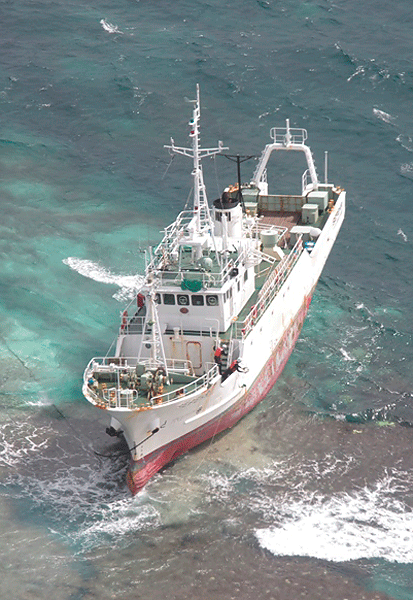
船主、費用未払い 作業目途立たず
台風17号の影響で、9月27日に川平の沖合で座礁した漁船「SEPEHR」(モンゴル船籍、船主イラン合同会社、119㌧)は、1カ月以上たった今も離礁作業の目途が立っておらず、リーフに乗り上げたままとなっている。同船の座礁海域は景勝地。放置された状態がこのまま続いた場合、景観や海洋環境に影響を与えるおそれがある。
石垣市防災危機管理室(大濵武室長)が2日、市議会の会派「自由民主石垣」(砥板芳行代表、6人)に役所内で行った説明によると、同船からは10月15日に油が流出したため、抜き取り作業で総量2万550㍑を回収。急を要したため、作業にかかった費用360万は市が一時的に立て替えた。
しかし、船主から費用は支払われていないため、代理店を通し催促している。船主は離礁を希望しているが、同船には保険が適用されておらず、費用の未払いもあることから、専門のサルベージ業者が船主の信用性の問題から対応を見合わせているのが実情。船主は代理店を通じて「離礁作業の終了を確認してからでないと支払いはできない」と話している。
大濵室長は「北風や波の影響で時間が立てば離礁は難しくなる。市の税金で作業するのはおかしい。船主が費用を早急に支払う意思があれば作業できるが、支払いの目途は立っていない」と頭を抱えている。
市議からは「市が(離礁作業を)やらざるを得ないのではないか。国、県に一括交付金などの費用を求めてはどうか」などの提案があった。
「市は「船主の責任で撤去すべき」と主張しているが、船の航行が規定に違反し、重油の抜き取りや撤去の費用に保険が適用されないことが判明。」
モンゴル船籍の漁船「SEPEHR」は保険に加入していたのか、いなかったのか?加入していたが保険が適用されないのかはっきりさせた方が良い。
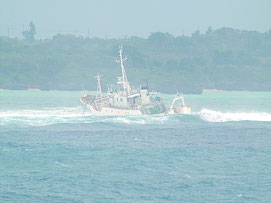
石垣市川平湾入口周辺でモンゴル船籍の漁船「SEPEHR」が座礁して1ヵ月余が経過したが、船の撤去に向けた見通しは立っておらず、関係者から「水産業や観光業に悪影響が出かねない」と懸念の声が強まっている。市は「船主の責任で撤去すべき」と主張しているが、船の航行が規定に違反し、重油の抜き取りや撤去の費用に保険が適用されないことが判明。船主であるイランの法人からは撤去に向けた具体的な方針が示されていないという。
平成二十八年十二月二日提出
質問第一八四号
沖縄県石垣島吉原沖の川平湾付近で座礁した外国漁船の撤去等に関する質問主意書
提出者 仲里利信
沖縄県石垣島吉原沖の川平湾付近で座礁した外国漁船の撤去等に関する質問主意書
去る平成二十八年九月二十七日、韓国からドバイに向けて航行していたモンゴル船籍の漁船「SEPEHR号」(総トン数百十九トン、乗組員七人)が台風十七号を避けるため、沖縄県石垣市の吉原沖に錨泊中のところ、強風で流されて川平湾付近で座礁した。幸い素早い救助活動により乗組員全員が救助されたため重大な事故とはならなかったが、油が流出し二次被害が生じたこと、座礁現場が国の名勝に指定されている景勝地であること、沖縄県内で唯一指定されている保護水面の指定地域となっていること、座礁した漁船がそのまま放置されており、このままでは過去の放置船舶と同様に放置船となる可能性が高いこと、現行の制度では座礁地域の自治体が撤去や汚染対策の義務を負うことなど、多くの不都合が懸念されているところである。
これらを踏まえて以下お尋ねする。
一 石垣市は、油による二次汚染を防止するため座礁した外国漁船から総量二万五百五十リットルの油を抜き取ったが、その費用として三百六十万円要している。なぜこのような抜き取り作業を石垣市が行わなければならないのか。この油の抜き取り費用は一体誰が負担すべきものなのか。また、その法的な根拠は何か。政府の認識と見解をそれぞれ明らかにされたい。
二 質問一に関連して、石垣市は当座の対策として漁船の現状悪化を防ぐ対策等を行ったが、今後速やかに当該座礁漁船が撤去されない場合には、高波による横転等が生じて撤去費用がさらに嵩む可能性も生じている。なぜこのような対策を石垣市が行わなければならないのか。これらの当座の対策経費や今後予想される抜本的な経費は一体誰が負担すべきものか。また、その法的な根拠は何か。政府の認識と見解をそれぞれ明らかにされたい。 三 今回、座礁した外国漁船は船籍及び船主の所在地の両方が外国にあるが、聞き取りを行ったところ、保険契約違反で保険の適用も受けられない可能性があるとのことである。そのような無責任な船舶が我が国の領海内を航行している場合には我が国の法律の適用や保険加入の義務化等を行うことはできないのか、政府の認識と見解を明らかにされたい。
四 外国船籍の船舶が座礁や衝突事故を起こした場合の責任の所在や補償に関する交渉等は誰が行うべきものか。そしてその費用は誰が負担すべきものか。政府の認識と見解をそれぞれ明らかにされたい。
五 座礁漁船の船主や保険会社が撤去費用や交渉経費等を支払わない場合、支払いを求める裁判は我が国の裁判所で行うことが出来るのか。勝訴し支払いの判決が下された場合、外国の船主や保険会社に対して有効で確実な取り立ての方法があるのか。政府の認識と見解をそれぞれ明らかにされたい。 六 自主財源に乏しく、逼迫した財政状況下にある離島の地方自治体が自己の責任に帰さない座礁船舶の撤去や二次汚染防止、外国にいる船主や保険会社との交渉等を行う経費を自ら捻出し負担することは非常に困難である。また、一時的であっても立て替えをすることも同様である。地方自治体の逼迫した財政状況を政府は承知しているのか。それでも政府は地方自治体が負担すべきであるとするのか。また、このような場合に政府は地方自治体に対してどのような支援策や救済策を講ずる考えか。政府の認識と見解をそれぞれ明らかにされたい。
七 座礁船舶に対する撤去や補償交渉のあり方、その費用の負担方法等に関する現行の制度について政府の承知するところを明らかにした上で、地方自治体がまず負担すべきとなっている現行の制度が適切か否かについて政府の見解を答えられたい。
八 これまで日本国内でこのような外国船舶の座礁事故に伴い、撤去と補償交渉、その費用捻出が当該自治体で困難な場合に政府がどのような対処をしたかという先例について政府の承知するところを明らかにされたい。
九 今回、外国漁船が座礁した川平湾は、西表石垣国立公園の指定地域で、国の名勝に指定されている景勝地である。このまま漁船が放置され続けると、単に景観を損なうだけではなく、環境に与える影響がさらに大きくなることが懸念されている。政府は係る事態をどのように把握・認識し、そして今後どのように対処する考えか明らかにされたい。
右質問する。
モンゴルが便宜置籍(実際の所有主の国籍を隠すために第3国の旗を付けて運航)方式でモンゴルの旗を付けて運航してきた北朝鮮船舶の登録をすべて取り消したと、ボイス・オブ・アメリカ(VOA)放送が3日報じた。便宜置籍は海運業界で通用する慣行。モンゴルは内陸国だが、400隻以上の海外船舶が自国船舶として登録するのを認めてきた。
VOAによると、モンゴル政府は先月8日、国連安全保障理事会対北制裁委員会に提出した安保理決議2270号履行報告書で、「北朝鮮船舶14隻の登録を取り消した」と明らかにした。また、履行報告書提出時点を基準にモンゴルの旗を付けた北朝鮮船舶は1隻も残っていないと明示した。政府当局者は「便宜置籍ができなければ北の旗を付けるしかないが、この場合、国際社会の監視のため自由な運航が事実上難しくなる」と説明した。
2270号採択後に北朝鮮の便宜置籍船の登録が取り消されたのは今回が初めてではない。今年6月現在、2270号が資産凍結対象に指定した北朝鮮遠洋海運管理会社(OMM)の船舶27隻のうち6隻の登録が抹消された。シエラレオネ・カンボジア・タンザニア・パラオなどが自国船舶として登録されていたものを取り消した。国際海事機関(IMO)も加盟国に6隻の再登録を禁止するという文書を回覧させた。またモンゴルは3枚分の履行報告書で「モンゴル国営銀行に設置された金融情報チームが対北朝鮮金融制裁違反がないか常時監視している」と強調した。
2270号が定めた制裁ではないが、人員送出を通じた北朝鮮の外貨稼ぎにも国際社会がブレーキをかける雰囲気だ。中東や欧州で北朝鮮の海外労働者を本国に送りかえす事例が相次いでいる。地中海の島国マルタは最近、北朝鮮労働者に対するビザ延長および再発行を中断した。これに先立ち、数百人の北朝鮮労働者が働いているポーランドも、北朝鮮の4回目の核実験以降、新規ビザを1件も発行していないと明らかにした。
しかし高高度ミサイル防衛(THAAD)体系配備が決定した後、中国が対北朝鮮制裁から離脱する可能性があるという懸念が持続的に提起されている。最近、朝中国境地域を訪問した対北朝鮮消息筋は「2270号採択直後と比較すると、北と中国を行き来する人と物資が増えたのが分かる」とし「制裁の履行がやや弱まった雰囲気だった」と伝えた。
「市は「船主の責任で撤去すべき」と主張しているが、船の航行が規定に違反し、重油の抜き取りや撤去の費用に保険が適用されないことが判明。」
モンゴル船籍の漁船「SEPEHR」は保険に加入していたのか、いなかったのか?加入していたが保険が適用されないのかはっきりさせた方が良い。
沈没したモンゴル船籍貨物船の船員は北朝鮮籍。船主及び管理会社は韓国のプサンにある会社。
こんなコンビネーションはありえるの?北朝鮮系の中国人船員を使っている韓国の会社は知っているけど、こんな事は知らなかった。世の中は広い。
ロイターの記事には「The vessel sails regularly between North Korea and China, according to Reuters' ship tracking system.」と書かれている。
しかしこの船、ShipSpotting.comのデータを見ると、2013年に2回も日本に入港している。日本に入港する時に日本の海上保安庁に北朝鮮に寄港していた事を報告していたのだろうか??
適当に報告書さえ提出すれば海保にとっては事実などどうでも良い事なのかもしれない。
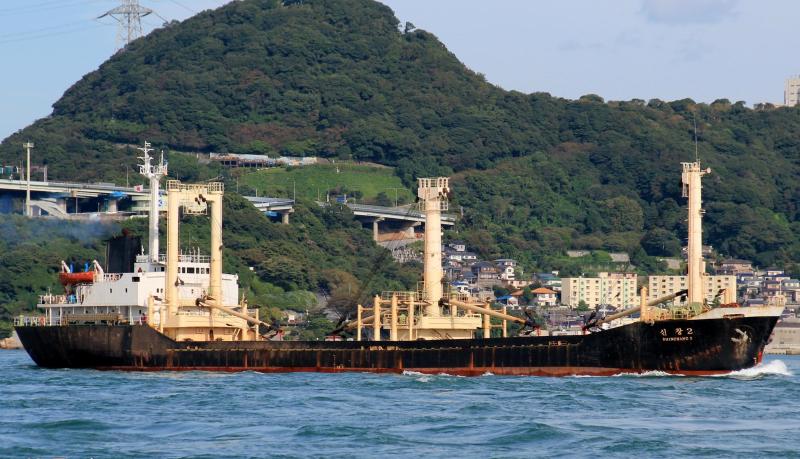
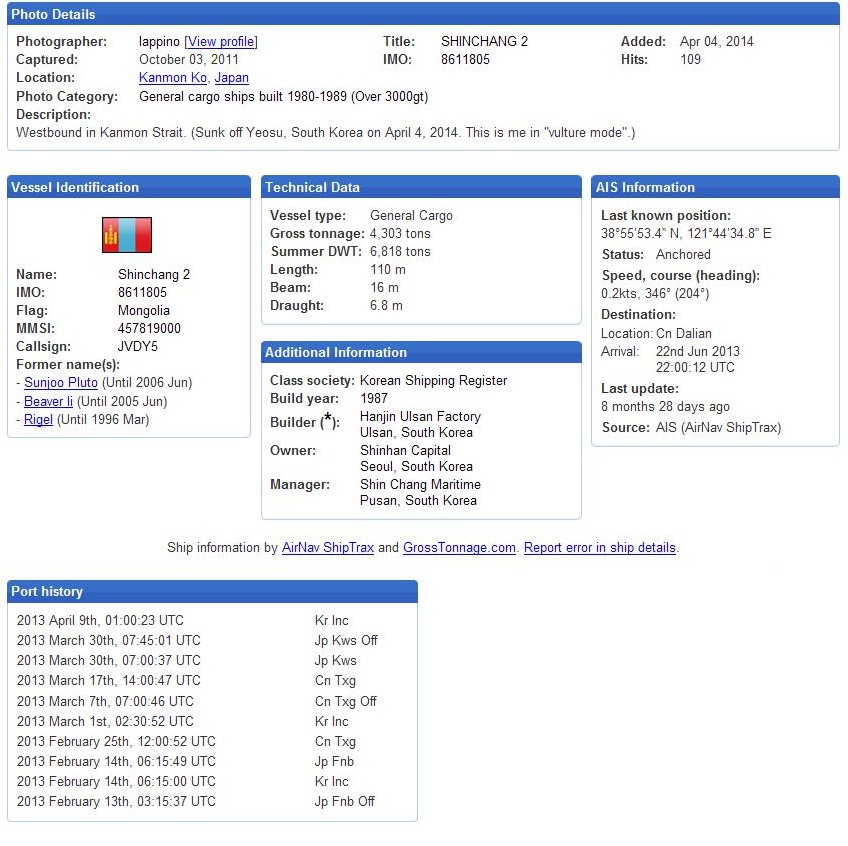
SHINCHANG 2 (Presently, Grand Fortune 1) - IMO 8611805 Mongolia flag, Built 1987 by Hanjin Ulsan Factory, Class: KR, Owner: Shinhan Capital Seoul, South Korea, Manager: Shin Chang Maritime, Pusan, South Korea (ShipSpotting.com)
General cargo vessel Grand Fortune 1 sank at around 0119 LT Apr 4 in East China Sea some 74 kilometers south of Yeosu, South Korea, shortly after passing Tsushima Strait en route from Chongjin, North Korea to China. From the 16 crew on board 3 were rescued, 2 were found dead, 11 are missing, search is under way. According to what survivors said, vessel sank after cargo shift – vessel was loaded with steel products. Korean News Agency Yonhap nevertheless, repeatedly says that vessel “ran aground”. There are some small rocky islands in the area where vessel sank, mere rocks, actually. What happened, then, is not yet clear. Did vessel sank in high seas after cargo shift, or did she hit the rock and sank after that? Crew is North Korean, though vessel is operated by a South Korean Company.
General cargo vessel Grand Fortune 1, IMO 8611805, dwt 6818, built 1987, flag Mongolia, manager SHIN CHANG SHIPPING CO LTD, South Korea.
【麗水聯合ニュース】韓国南部の麗水沖で4日未明に沈没したとみられる貨物船に北朝鮮の乗組員16人が乗っていたことが分かった。
韓国の麗水海洋警察署と済州海洋警察署によると、4日午前1時19分ごろ、全羅南道麗水市の巨文島南東63キロ沖で、4000トン級のモンゴル船籍の貨物船と連絡が途絶えた。
乗組員は船長をはじめとする全員が北朝鮮籍と分かった。救難信号を受け捜索に乗り出した海洋警察署が2人を救助し、済州地域の病院に緊急搬送した。
この貨物船は北朝鮮北東部の清津地域から中国へ鉄鋼製品を輸送中だった。
海洋警察署は捜索作業を続ける一方で、モンゴル船籍の貨物船に北朝鮮乗組員が乗っていた経緯などを調べている。
The country risks serious damage to its reputation with its questionable maritime activities.
With more than 250 days of sun a year, Mongolia’s moniker – Land of the Blue Sky – is well deserved; its association with the deep blue sea, though, is less obvious. The nation’s capital, Ulaanbaatar, is located more than 1,300 kilometres from the ocean, and Mongolia is the largest landlocked country in the world. Nevertheless, over the last decade Mongolia has developed a maritime tradition that it rarely speaks of, offering flags of convenience to shipowners since 2003. Although little attention has been given to Mongolia’s merchant fleet, the lack of transparency and scrutiny associated with it risk facilitating illicit activities and causing serious reputational damage to the country. The material benefit that the Mongolian State derives from its merchant navy is far from clear, making it reasonable to question whether Mongolia’s maritime tradition is worth preserving, or if it would be best abandoned.
With 90 percent of international trade being carried by sea, shipping is one of the most vital industries in the world economy. Its inter- and trans-national nature, however, makes it challenging to regulate and, although the UN attempts to do so under the aegis of the International Maritime Organization (IMO), there is considerable leeway to exploit loopholes and ambiguities in the international regulatory regime. One such practice is that of flying flags of convenience – registering a merchant ship in a sovereign state other than that of the ship’s owner. A country that allows foreign-owned ships to fly its flag is said to have an open registry, and three such registries (Liberia, the Marshall Islands, and Panama) currently account for 40 percent of the entire merchant fleet by tonnage. Indeed the practice is so widespread that some three quarters of the global merchant fleet is registered under a flag of convenience.
Ship owners employ this practice for a number of reasons: It allows them to avoid burdensome regulation, it reduces operating costs and tax bills, it allows shippers to employ cheaper labor and, in some cases, it can offer anonymity to the beneficial owner of a vessel. The more pernicious effects of use of this practice include avoiding safety and environmental standards. The moral ambiguity of flags of convenience has made them atarget of ire for international labor unions, but even more concerning than the degradation of labor standards is the potential for the practice to be used to conceal or facilitate illegal activities, such as trafficking of illegal goods, evasion of international sanctions, or providing support to terrorism. Cambodia, for example, used to be notorious for the lax standards of its registry and in 2002 the MV Winner, a Cambodian flagged vessel, was found to be carrying two tons of cocaine off the Canary Islands. This incident highlighted the flagrant abuse of Cambodia’s registry and the government subsequently announced a wholesale reorganization.
Mongolia, for its part, established its own registry under Prime Minister Nambaryn Enkhbayar in February 2003. The Mongolian Ship Registry’s stated mission was to “provide excellence in registry and marine services.” Over the course of ten years the Mongolian merchant fleet grew rapidly and, according to the UN, reached atotal dry weight tonnage capacity of 643,000 tons in 2013. While this total tonnage is low relative to other countries, it is not insubstantial. For example, Mongolian-flagged vessels have a greater capacity than their Iraqi or Sri Lankan counterparts (110 and 239 tons respectively). The Mongolian fleet now comprises 168 vessels and, in terms of dry weight tonnage, is the largest merchant fleet of any landlocked country except Switzerland (1,144 tons) and Luxembourg (1,601 tons) – both highly developed economies with long traditions of nominal ownership.
All the Wrong Reasons
In spite of its self-professed commitment to excellence, though, it seems that the registry has proved popular for all the wrong reasons – in effect serving as the maritime equivalent of an offshore financial center, allowing beneficial ownership to be hidden, operating costs and taxes to be minimized, reducing transparency, and, in some cases, facilitating illegal activities. These concerns are exacerbated by the fact that Mongolia’s registry isn’t even based in the country. It is run out of Singapore and managed by Sovereign Ventures, a conglomerate owned by Chong Koy Sen. Chong is a Singaporean citizen who serves as the honorary consulate of Tuvalu (another state renowned for its flag of convenience) in Singapore as well as managing director of its Ship Registry. It is in Tuvalu that a number of Iranian Government ships (owned by the National Iranian Tanker Company) implicated in sanctions busting are registered. According to a leaked American diplomatic cable from 2007, Sovereign Ventures has long-standing ties to North Korea and used to manage the Cambodian Shipping registry until its 2002 reorganization. Indeed, it was Sovereign Ventures that had flagged the Winner in Cambodia.
While there is no direct link between Sovereign Ventures and these incidents, it is clear that the comparative advantage of the registries it runs lies in their relatively lax regulatory requirements. When it comes to the Mongolian Ship Registry, for example, an international service provider for shipowners and shipbrokers lists the advantages of registering under a Mongolian flag as including: competitive fees and taxes; no tax on profits or capital gains; recognition of all IMO standards and certificates for crew; quick service and issuance of certificates within the hour; and the fact that ships are not subject to requisition as national resources. In addition, there are no restrictions on the ownership of any ship registered in the Mongolia Ship Registry. With the registration process being outsourced, and with reduced standards being the main appeal of the registry, it should come as no surprise that Mongolia’s merchant fleet ranks poorly when assessed according to international metrics.
The International Chamber of Shipping (ICS) and International Shipping Federation (ISF) release an annual shipping industry flag state performance table that assesses flag states in terms of performance. These metrics include port state control (whether they have been blacklisted by the world’s principal port state control authorities); ratification of major international maritime treaties; use of recognized organizations compliant with IMO resolution A.379 (which requires states to establish controls over organizations carrying out safety inspections and surveys of ships); age of fleet; reporting requirements (submission of compliance and practice reports as required by the International Labour Organization); and attendance at IMO meetings (suggesting increased likelihood of complying with IMO rules). In all but one of these categories (fleet age), Mongolia performs poorly.
Given that many of these metrics are technical in nature, it is sufficient to highlight Mongolia’s performance relating to port state control to give an idea of the issues that blight the Mongolian merchant fleet. Port state control refers to the inspection of foreign ships in ports and is governed globally by three main regional regimes: the Paris Memorandum of Understanding, the Tokyo Memorandum of Understanding, and the United States’ Coast Guard regime.
With most Mongolian-flagged ships operating in the Asia-Pacific region, it is the Tokyo MoU which is most relevant to Mongolia. This agreements binds together 18 Asia-Pacific states and aims to establish an effective regional port state control regime through cooperation and harmonization of activities – the aims of this being to eliminate sub-standard shipping, promote maritime safety, protect the environment, and safeguard working and living conditions on ships. In 2013, the signatories of the Tokyo MoU conducted 142 inspections of Mongolian-flagged vessels. In 131 of these inspections, deficiencies were found (a total of 1,217 separate deficiencies) and 38 of the inspected ships (26.76 percent of the total) had to be detained. This was the second highest of any country and far above the regional average of 4.5 percent. As a result, Mongolia currently finds itself on the blacklist of the Tokyo MoU, with Mongolian-flagged ships subject to increased inspection as a result.
Incidents
Moving from the big picture to individual cases, Mongolian-flagged ships have been (and continue to be) involved in a number of incidents that reflect negatively on the state. These can be broken down into four categories: safety; illicit activity; sanctions busting; and lack of control and oversight. These examples highlight the reputational damage that the practice of maintaining an open registry can cause to Mongolia and the need to carefully consider its continuation.
When it comes to safety, Mongolian ships have been involved in a number of life-threatening and fatal accidents. In November 2003, for example, 13 Russian sailors were rescued from the Fest, a Mongolian-flagged vessel loaded with logs that was sinking in the Sea of Japan after the ship’s engine failed. Since this incident, Mongolia promised to stop registering vessels over 30 years old, but accidents continue to occur. Just last year, two North Korean sailors died aboard a Mongolian-flagged vessel after their cargo ship sunk off the coast of South Korea.
In addition to safety concerns, Mongolian registered ships have also been involved or implicated in illicit activities. In 2003 the MV Unique was searched by Irish police and customs officials as they suspected that it was being used by an international crime gang to carry illegal immigrants. In December 2012 another Mongolian-flagged ship was detained by the Malaysian Maritime Enforcement Agency on suspicion ofsmuggling diesel and selling it in nearby countries. Some 200,000 liters of diesel (which is subsidized in Malaysia) worth $1.2 million was found on board.
More worrying than diesel smuggling is the potential use of Mongolian flags to help states avoid international sanctions. Although no direct evidence has emerged of Mongolian ships being used to this end, Mongolia was forced to cancel the flags of five Iranian owned cargo ships in 2012 following international pressure. North Korea, another state subject to international sanctions, has long used foreign registries to hide its shipping activities with foreign-flagged ships having been used for drugs and arms smuggling amongst other things. Cambodia was long the registry of preference, until the international pressure that ensued following the MV Winner incident put an end to this practice in 2002, and the apparent replacement for North Korea was none other than Mongolia. The willingness to provide flags to Pyongyang has attracted stern criticism, with the director of the Institute for International Affairs at James Madison University calling on the State Departmentto “investigate Mongolia’s maritime activities and aims,” before asking that its coordinator for counterterrorism should “certify whether they represent a threat to Americans at home and abroad.”
The final example of abuse of Mongolian flags of convenience is perhaps the most surprising, and relates to control and oversight. In the context of the international effort to combat piracy off the coast of Somalia, a number of floating arsenals have sprung up in international waters. These vessels act as storage locations for weapons and personnel, so that ships can quickly and efficiently pick up and deposit security teams as they pass through the Gulf of Aden. With these vessels based out of international waters, regulation of the weapons and material on board falls to the flag state. All weapons aboard U.K. flagged ships, for example, are registered and licensed with the British authorities. If the flag state has limited controls over the storing and transfer of military equipment, then these ships may operate with no oversight. A number of service providers seem to be using Mongolian-flagged ships to this end, and a December 2014 research report by the Remote Control Project(a body that examines developments in warfare) found at least 32 ships that act as such floating armories in and around the area. Of these, eight were found to use Mongolian flags of convenience, while a further two are thought to do so. Given Mongolia’s presence on several blacklists, this means that these weapons are as good as unregistered and these ships are acting without any effective oversight or regulation.
Revenues
It is no surprise, then, that the International Chamber of Shipping included Mongolia on a list of countries that it classified as “conspicuous examples of sub-standard ship registers” in February of this year. Taken together, these metrics and incidents highlight that the Mongolian Ship Registry is open to abuse. But what does the registry bring to Mongolia? Finding precise information about the division of revenues between the Singapore-based company that operates the registry and the Mongolian Marine Administration, which is nominally responsible for it, is almost impossible. Attempts to contact both parties received no reply. However, according to budgetary information from the Mongolian Ministry of Roads and Transportation, the Mongolian Marine Administration was expected to contribute 274.4 million Tugrugs ($140,000) of revenues in 2014. This is a pitifully small amount. It is likely that the registry generates more money than this. The fact that Enkhtuya Nambayar, the sister of the prime minister who founded the registry (who was later jailed for corruption) wasworking there before herself being investigated for corruption (on charges that were later dropped) would suggest that all is not as it seems, but no public information on where, and to whom, the earnings go is available.
Mongolia’s naval tradition is barely ten years old, but its registry has rapidly developed into an example of the risks and failings of poorly controlled open registries and flags of convenience. To date, Mongolia’s willingness to flag foreign vessels has gone relatively unobserved, and there has been little debate within the country about the merits and demerits of this policy. Clearly this needs to change. Mongolian-flagged vessels have been involved in fatal accidents, illegal smuggling, implicated in helping rogue states avoid sanctions regimes, and are currently used to host floating arsenals with no oversight. What is surprising is that these activities have not yet caused significant reputational damage to the country. The longer the government maintains its open registry with little or no oversight, the less likely it is to continue avoiding the spotlight. At a time when Mongolia is already under scrutiny for its rule of law and the behavior of its government, this is reputational damage that it can scarcely afford to sustain. With the registry officially bringing in only $140,000 dollars to the public purse, a cost-benefit analysis of providing flags of convenience makes clear the need to terminate or severely modify the practice. Mongolia is a country replete in tradition, and its ability to retain and protect these traditions is one of its most admirable features. The country’s maritime tradition, however, has a much shorter and more ignominious history, and is one that deserves to be consigned to the deep.
Graham Alexander is a freelance writer currently based in Mongolia.
Source:http://thediplomat.com/
Seoul, South Korea (CNN) -- Two North Korean sailors are dead and 11 missing after a Mongolia-flagged cargo ship sank off the southeastern coast of South Korea.
Three sailors were rescued by the South Korean Coast Guard after the distressed ship, Grand Fortune 1 sank early Friday.
"The sunken ship sent the rescue signal at around 1:19 a.m. from some 130 kilometers away and took two hours to reach," said Kang Byung Moon, the director of public affairs at the Yeosu Coast Guard.
South Korean officials deployed a search plane and a patrol ship to find survivors and rescued the first sailor around 5 a.m.
"Because he suffered from hypothermia, we could not get any information until he came around to find out that he was from North Korea and that there were 15 others on board," Kang said.
The other two survivors were rescued at 5:55 a.m. and 7:12 a.m. respectively. The three survivors are being treated on Jeju island, according to South Korean government officials.
It remains unclear why the cargo ship sank.
The ship was believed to have be coming from Chongjin in North Korea, headed to China, reported Yonhap, South Korea's semi-official news agency.
It carried a Mongolian flag, but had an all-North Korean crew. The two countries are traditional allies and North Korea has been known to sail rented ships.
South Korean rescuers search for missing sailors after bodies of two are found along with three survivors
The bodies of two North Korean sailors and three survivors have been found off the coast of South Korea after their cargo ship sank. South Korean rescuers are searching for 11 others still missing.
The Mongolian-flagged ship was carrying 16 North Korean crew members when it sent a distress signal in international waters about 80 miles (130km) south of the southern port city of Yeosu, South Korea's coastguard said in a statement.
Three people were rescued and told investigators they escaped from the ship as it was tilting with its freight being pushed to one side.
South Korean coastguard officers said high waves and strong winds were reported in the area where the 4,300-ton ship sank. It was carrying iron ore to China from the North Korean port city of Chongjin.
The South Korean coastguard said it had mobilised 13 vessels and six aircraft to search for the missing crew. Bad weather was still hampering rescue operations, according to the coastguard officers.
It was not immediately known how South Korea would handle the rescued North Korean sailors. Seoul usually repatriates North Korean sailors found drifting in South Korean waters if they want to return home.
All three rescued sailors were taken to a hospital on the southern South Korean island of Jeju and none of them was in a life-threatening condition, the coastguard statement said.
The Korean peninsula remains in a technical state of war as the 1950-53 Korean war ended with an armistice, not a peace treaty. On Monday, the rival Koreas fired hundreds of artillery shells into each other's waters.
ソウル 4日 ロイター] -韓国の沿岸警備当局者らは4日、北朝鮮の乗組員16人が乗ったモンゴル船籍の貨物船が、韓国南方沖で沈没したと明らかにした。乗組員のうち2人が遺体で発見され、3人が救助された。残る11人の捜索が続いているという。
当局者1人によると、鉄鉱石を積んだ貨物船は、北朝鮮東部の清津を出発し、中国に向かっていた。沿岸警備隊員は、救助された乗組員が韓国の病院に搬送されたと述べた。
ロイターの船舶追跡システムによると、同船は中朝間を定期的に航行している。
(Reuters) - A Mongolian-flagged cargo ship has sunk off the southern coast of South Korea, with most of the 16 North Korean crew members on board missing, South Korean coast guard officials said on Friday.
Two crew members were found dead and three were rescued, while a search was under way for the other 11 crew still missing, the officials said.
The Grand Fortune 1 was sailing from the Chongjin region on North Korea's east coast for a Chinese port carrying iron ore, said one official, who requested anonymity because he was not authorized to speak to the media.
The vessel sails regularly between North Korea and China, according to Reuters' ship tracking system.
The rescued crew members were taken to a South Korean hospital for treatment, according to the coast guard.
(Reporting by Ju-min Park; Writing by Jack Kim; Editing by Paul Tait)
怪しい船や違法行為に使われる船の国籍にモンゴル籍船が使われる事がある。要注意の国籍である事には間違いない。停船命令を無視し、船を横付けして乗り込もうとしたインドネシア職員に番犬の攻撃。番犬は撃ち殺されるまで抵抗したそうである。
下記の情報はM/T"STAR EMERALD"が現在の船名になっているが、下記の写真を見るとM/T"KYOEI MARU"と書かれている。やはり国籍証書や国際条約で要求される証書の船名はM/T"KYOEI MARU"なのであろう。
一般的にパナマを除いては大きな海運会社が船を登録する国籍は問題のある船を登録させない。パナマは受け入れる船の幅が広いので、立派な船もあれば、典型的なカンボジア籍船の船もある。そう言う意味ではモンゴル籍船らしい船と言う事になる。
|
| |
|---|---|
| Ship Name: | STAR EMERALD |
| Type of Ship: | OIL PRODUCTS TANKER |
| Flag: | MONGOLIA |
| IMO: | 8303941 |
| Gross Tonnage (ITC): | 1352 tons |
| Year of Built: | 1983 |
| Builder: | KURINOURA DOCKYARD & SHIPBUILDING - YAWATAHAMA, JAPAN |
| Class Society: | RUSSIAN MARITIME SHIPPING REGISTER |
| Manager & owner: | ZONE ARCTIC - JOHOR BAHRU, MALAYSIA |
| Former name: |
FORTRESS until 2011 Jan SEA DEFENDER until 2010 Jan KYOSEI MARU until 2009 Nov GRANDEUR PIONEER until 2002 Nov NEW HORIZON until 2001 Jul ALLWELL PRELUDE until 1999 Jul KYOSEI MARU until 1997 Dec |
Indonesian customs and border guard tried to stop for the check tanker Kyosei Maru, which was crossing Indonesian waters off Batam, Malacca Strait, in the morning Dec 2. It is not explained by the authorities, why did they find the vessel to be suspicious. Tanker didn’t obey orders and kept sailing. Patrol boat closed tanker, officers tried to board the vessel, but were met by five ferocious dogs, unleashed by the crew. Dogs held the fort until one of them was shot dead. Tanker loaded with 1,300 tons of crude oil or oil products was heading for Malaysia, officials said there were no papers on the cargo, vessel’s papers were also missing. Tanker was detained and anchored off Batam.
Using dogs for protection seems to be quite a good idea, in the waters where small tankers are most vulnerable to piracy attacks. Providing of course, the dogs will be protected from the officials.
Voytenko Mikhail
Tanker Kyosei Maru, IMO 8303941, dwt 2517, built 1983, flag Mongolia, manager ZONE ARCTIC SDN BHD, Malaysia.
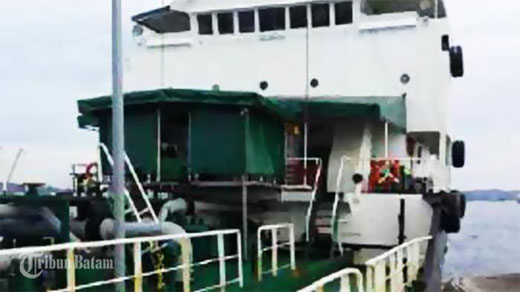
マレーシアで出港停止命令を受けたモンゴル船籍INAI MERAH (IMO: 8662452)は問題のある曰くつきの船のようだ。

TOKYO MOU
マレーシアの英字新聞THE STAR ONINEが5月23日、マレーシア海事当局はケンディ島沖で作業中のサルベージ船を発見し不法行為を行っていたとして乗組員を逮捕したと報じています。 発見時このサルベージ船は日本の特設砲艦「長沙丸」の引き上げ作業をしており、中国国籍の船長と乗組員9名を逮捕し引き上げられた残骸や取引先の調査、余罪の洗い出しを行っているとのこと
※引用先(1)
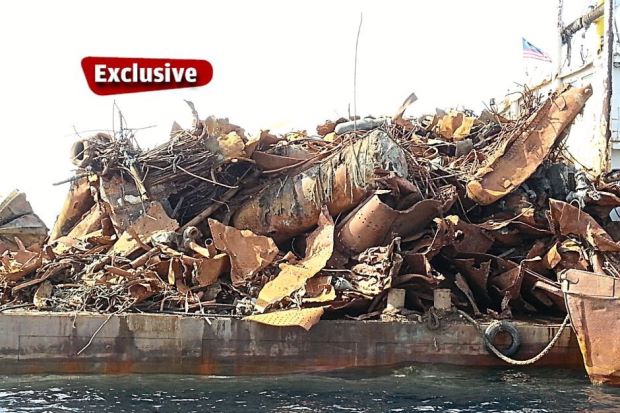
おなじくマレーシアの英字新聞THE STAR ONINEが5月22日付で
ペナン島沖で、サルベージ業者が今年に入り少なくとも5隻以上の沈船を鉄くず回収目的で当局に無許可で引き上げたと報じています
同紙によると不法引き上げの被害にあった沈船の中には旧日本海軍の軍艦、重巡洋艦「羽黒」、軽巡洋艦「球磨」、特設砲艦「長沙丸」が含まれています
•業者がマレーシア当局に無届でサルベージ作業を行っている
•沈船が漁礁として地元の大切な漁場になっており漁業者に被害が出ている
•大戦中に亡くなった水兵たちの墓標であり慰霊の場であること
などの問題点を同紙は解説し、地元から業者に対する非難や中止を求める声が上がっていることを伝えています
※引用先(2)(3)
8月14日NHKニュース9で、この件について特集が組まれ流されましたが、マレーシア現地業者と誤解しそうな表現を使われていましたので気になり調べてみました。
元ソースであるマレーシア紙THE STAR ONINEを読み、鮮明が記されているので海事ポータルからこの当該船について調べました
HAI WEI GONG 889
•IMO:8662452
•船型:クレーン船
•建造:2007年中国福建省 FUJIAN XINCHANG SHIPBUILDING
•母港:丹東
•船籍:中国→カンボジア
※引用先(4) ※引用先(5)
この違法サルベージ作業船は乗組員や船歴からして地元の業者ではなく中国の業者と見るのが妥当なようです
地元漁業者の生活の糧であり、大戦の慰霊の場であり、ダイビングスポットとして観光資源になっているペナン島沖の戦没艦船を無許可で鉄屑として転売しようという業者の行為は許されることではありません
戦時中に海没した艦船が違法サルベージ業者に狙われる事案が他にも
バタビア沖海戦で沈没した豪海軍軽巡洋艦「パース」
マレー沖海戦で沈没した英海軍戦艦「HMSプリンス・オブ・ウェールズ」「HMSレパルス」
などでも起こっており英国政府もこれら海の墓標を荒らされることに深い懸念を発しています
※引用先(6)
THE STAR ONINE紙の一連の報道に注目が集まるにつれてマレーシア当局も取り締まりに本腰を入れはじめたようですが、これ以上死者の眠りを妨げるような事のないよう願っています
by eddie chua
PETALING JAYA: A ship that illegally stripped shipwrecks off Penang island for scrap metal has been detained and impounded by the northern region Marine Department.
There was a mountain of rusty ship parts and salvage work was in progress when the agency’s officials boarded the ship, which is equipped with a crane, off Kendi Island.
The agency had been alerted about the illegal operation after The Star first discovered the salvaging there last week.
The Cambodian-registered vessel was caught red-handed dredging the Chosa Maru wreck, better known as the Japanese wreck among locals. The skipper and his nine-man crew, all Chinese nationals, have been arrested.
Aside from seizing the ship, the authorities impounded a workboat that accompanied Hai Wei Gong 889, a Chinese-made vessel that was commissioned in 2007.
“The ship does not have the documents for salvage work and was operating illegally in Malaysian waters,” a marine department official said.
The ship, workboat and its crew had been ordered to sail to Lumut, where the ship is now impounded.
“We are also investigating where the vessel had disposed the scrap metal after salvaging at least five shipwrecks off Penang, including the two Japanese World War II wrecks,” the official said.
At this point, he said, the authorities were investigating who the buyer of the scrap metal was.
“The department is also investigating how long the ship had operated in Malaysian waters illegally and whether it had looted other areas besides Penang.”
The official said the department was investigating if the vessel had plundered other ships, both commercial and military, off the east and west coast of Malaysia.
The Star reported yesterday that illegal salvagers had plundered scrap metal from at least five shipwrecks, including two Japanese World War II vessels, off Penang waters since early this year and their activities had gone undetected by the authorities.
The unscrupulous salvagers were believed to have “cleared up” at least two wrecks – the Japanese gunboat Chosa Maru, called Kapal Jepun by locals, which sunk in August 1943, and Japanese light cruiser Kuma that went down on January 1944 – and had taken away metal worth millions.
The other three wrecks that are being salvaged are Japanese warship Haguro, Kapal Taiwan and Kapal Simen, which are all located off Kendi Island.
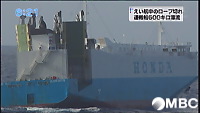
台風19号が北上する中、今月9日、奄美大島沖で機関故障のため巡視船にえい航される途中ロープが切れた自動車運搬船がその後漂流し、およそ500キロ流されていたことがわかりました。漂流したのはモンゴル船籍の自動車運搬船「HARMONIMAS3」2719トンです。第十管区海上保安本部によりますとこの船は今月8日、奄美大島の名瀬港の北西およそ30キロで機関故障となり、9日に巡視船がえい航していましたが台風による波の影響でロープが切れました。乗組員の日本人7人とインドネシア人2人の合わせて9人はヘリで救助され、けがはありませんでしたが、無人の船は漂流を続けました。船は西に流され奄美大島と中国のほぼ中間にあたる名瀬港の西およそ350キロまで漂流。その後、台風の影響で南東におよそ180キロ流されたところで、15日巡視船に発見され曳航されたということです。1週間でおよそ500キロ漂流したとみられています。自動車運搬船は16日沖縄の海域で船主に引き渡されたということです。
モンゴル船籍自動車運搬船「HARMONI MAS3」(IMO:9037965, Call Sign: JVRZ5, MMSI:457900024, EX-あさか2 (ASAKA 2) )は尾道港から出港したようだ。
尾道港から出港した船は沈没、行方不明、又は海難を起こすケースが多い。乗組員の日本人7人とインドネシア人2人の合わせて9人はヘリで救助されたそうだが、救出費用は税金。船主又は乗組員に支払わせるようにした方が良い。出港する時に経費を抑えるために安全を犠牲にしているので海難に遭う確率が高いのは当然。
船名と船籍港が手書きから判断してコストを一切掛けていないと思われる。エンジントラブルも当然か?
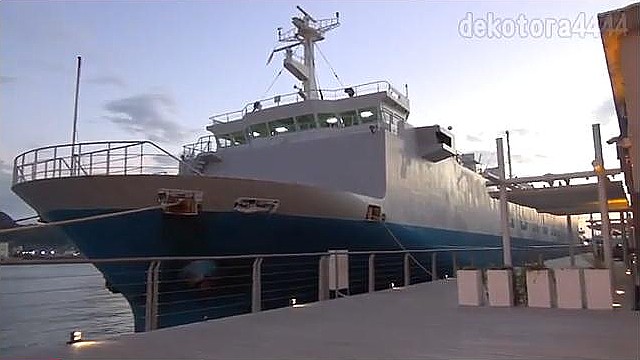
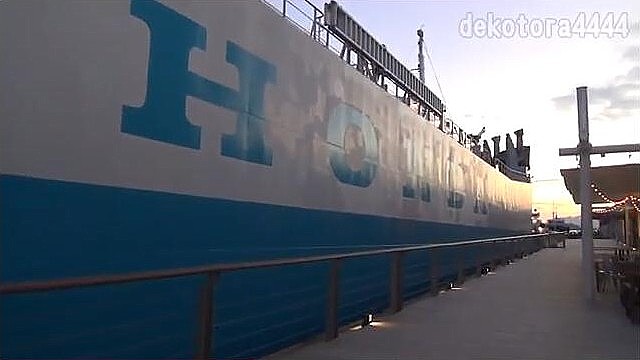
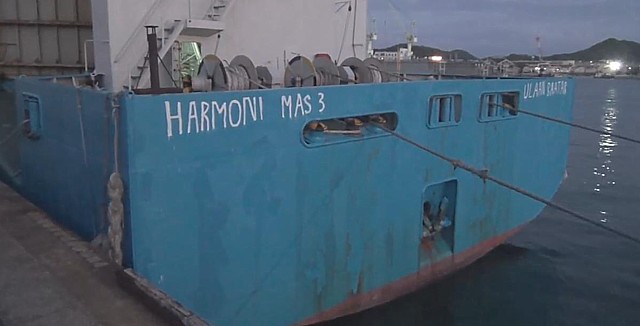
HARMONI MAS3(旧 ASAKA2) (At Onomichi) (YouTube)
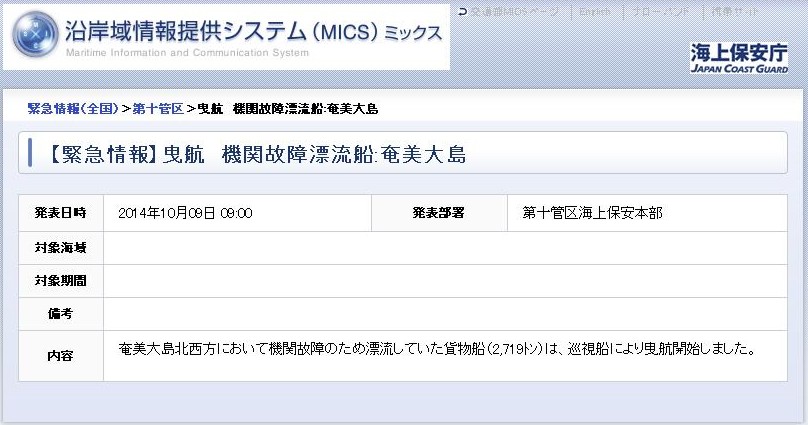
【緊急情報】曳航 機関故障漂流船:奄美大島 (沿岸域情報提供システム(MICS)ミックス)
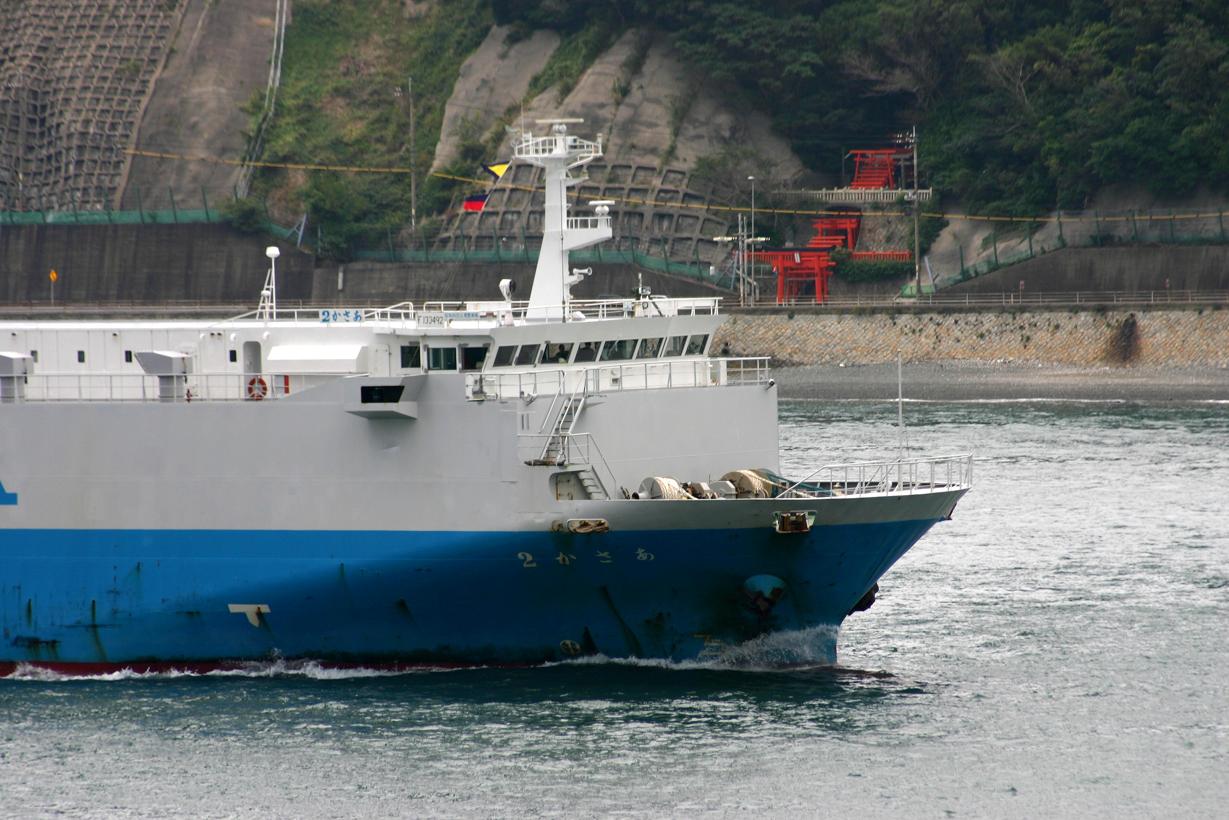
斎藤海運所属・ホンダロジスティクス運航の「あさか2」(Ship Photo Cafe"Apron")
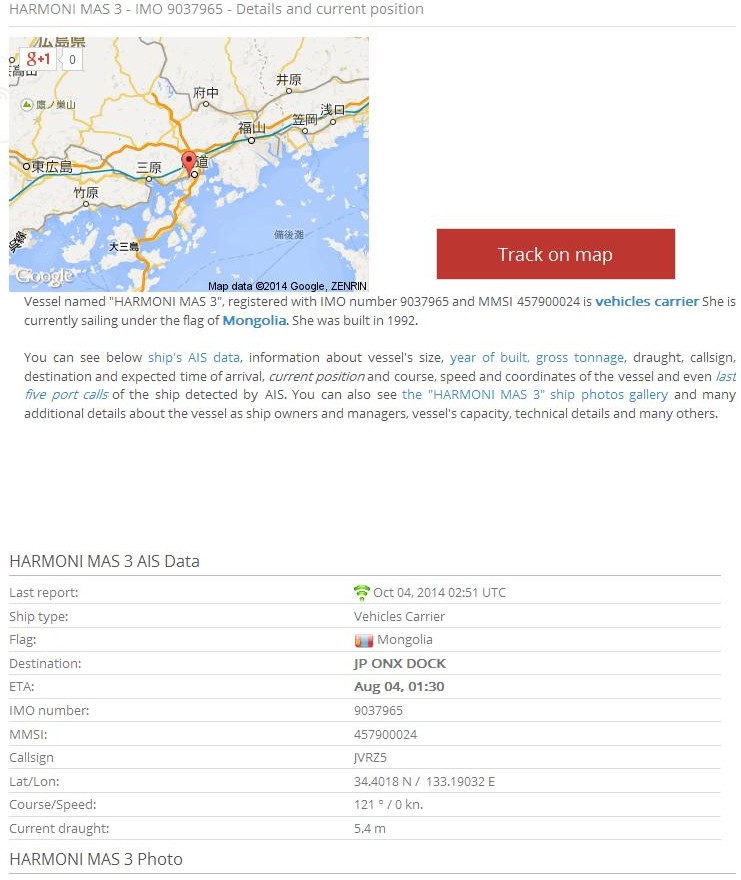
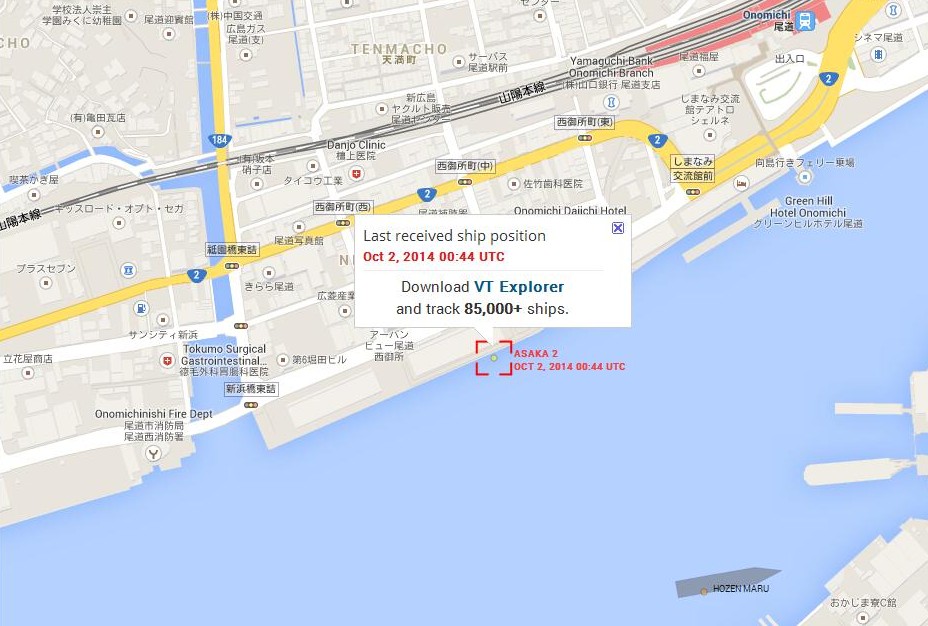
VESSEL FINDER
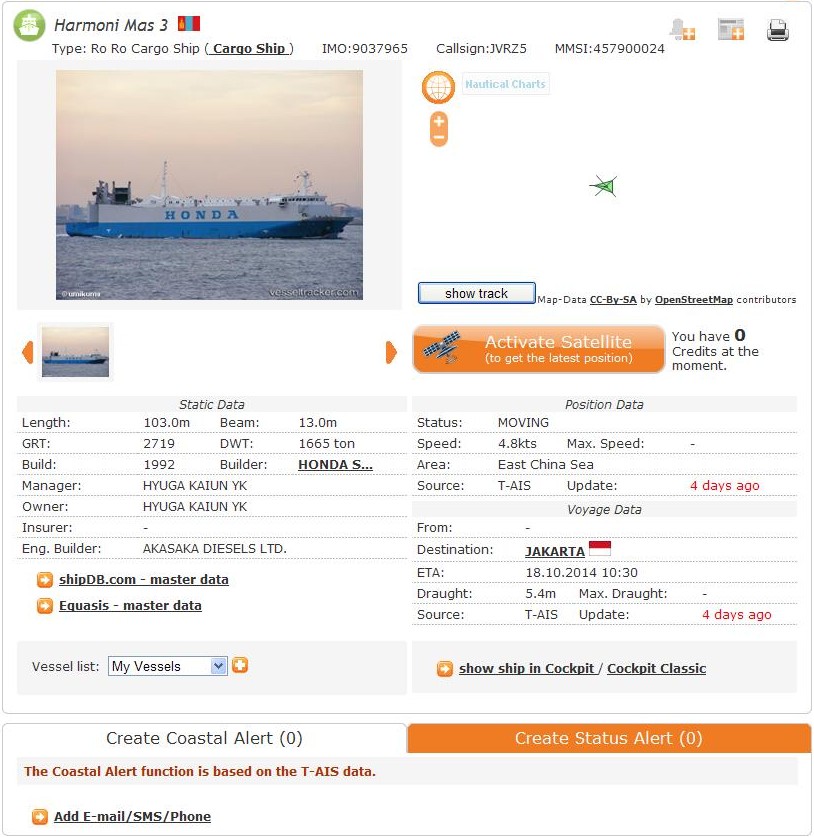
VESSELTRACKER
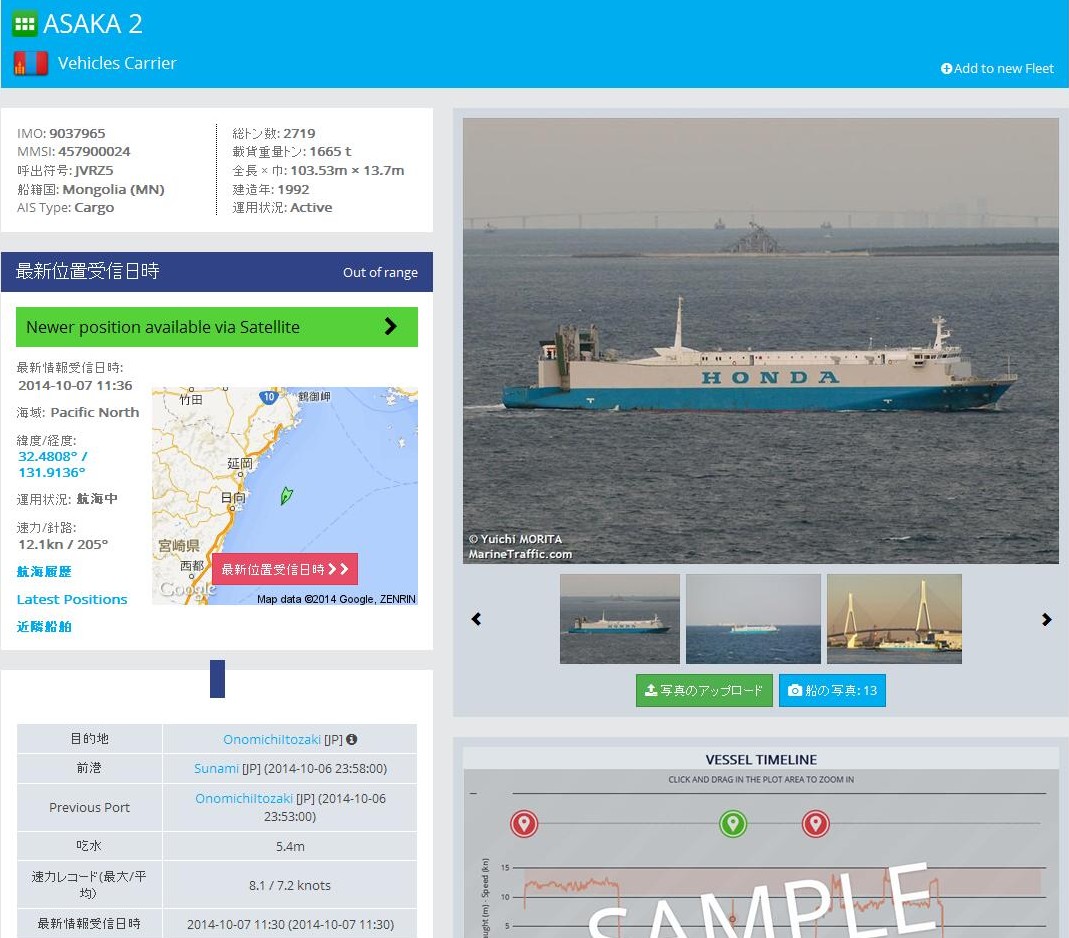
Marinetraffic.com
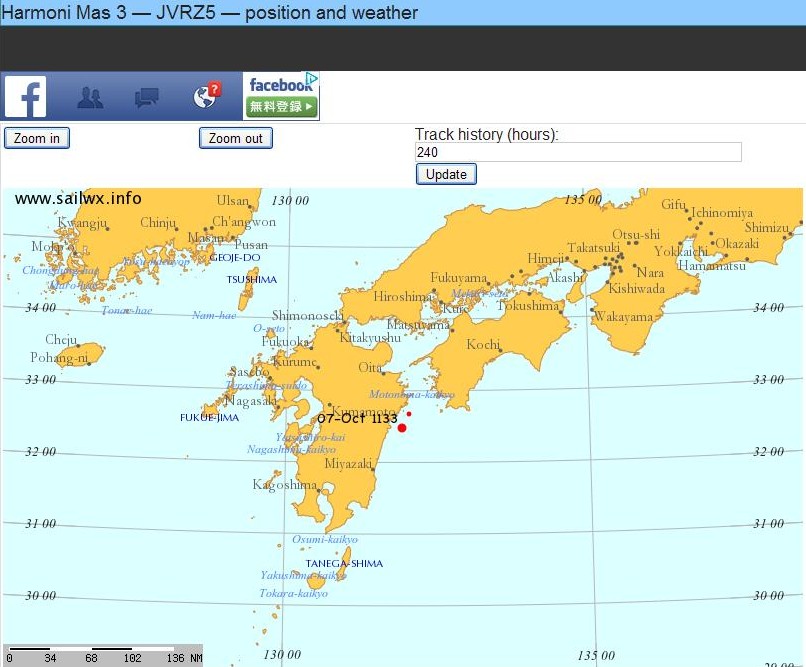
船名から判断するとHARMONI MAS 8 (IMO: 9100358)とHARMONI MAS (IMO: 8508802)の船主であるRORO SAMUDRA PUTRA HARMONI MAS - JAKARTA, INDONESIAがンゴル船籍自動車運搬船「HARMONI MAS3」(IMO:9037965, Call Sign: JVRZ5, MMSI:457900024, EX-あさか2 (ASAKA 2) )の新しい船主かもしれない?
|
| |
|---|---|
| Ship Name: | HARMONI MAS 8 |
| Type of Ship: | RO-RO CARGO |
| Flag: | PANAMA |
| IMO: | 9100358 |
| Gross Tonnage (ITC): | 7410 tons |
| Year of Built: | 1994 |
| Builder: | KANASASHI HEAVY INDUSTRIES - SHIZUOKA, JAPAN |
| Class Society: | NIPPON KAIJI KYOKAI |
| Manager & owner: | RORO SAMUDRA PUTRA HARMONI MAS - JAKARTA, INDONESIA |
| Former name: |
BECKY until 2012 Nov BETSY until 2007 Nov |
|
| |
|---|---|
| Ship Name: | HARMONI MAS |
| Type of Ship: | VEHICLES CARRIER |
| Flag: | INDONESIA |
| IMO: | 8508802 |
| Gross Tonnage (ITC): | 3545 tons |
| Year of Built: | 1985 |
| Builder: | SHIN KURUSHIMA HIROSHIMA DOCKYARD - HIGASHIHIROSHIMA, JAPAN |
| Class Society: | BIRO KLASIFIKASI |
| Manager & owner: | RORO SAMUDRA PUTRA HARMONI MAS - JAKARTA, INDONESIA |
| Former name: | TOYO MARU NO.18 until 2004 Feb |
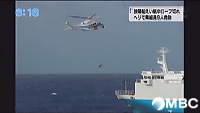
台風19号で次第に波が高くなる中、9日午前奄美大島沖で巡視船が機関故障の自動車運搬船を曳航していたところロープが切れました。運搬船の乗組員9人はヘリコプターで救助されました。第十管区海上保安部によりますと、曳航のためのロープが切れたのはモンゴル船籍の自動車運搬船「HARMONIMAS3」2700トンです。8日午後11時半ごろ奄美大島の名瀬港の北西およそ30キロの海上で、機関故障のため救助要請し9日朝から巡視船が曳航していましたが9日午前11時前、台風による波の影響で曳航のロープが切れたということです。乗組員の日本人7人とインドネシア人2人の合わせて9人はヘリで救助され、けがはありませんでした。海上保安部は今後、天候を見てあらためて自動車運搬船の曳航に取り掛かる方針です。
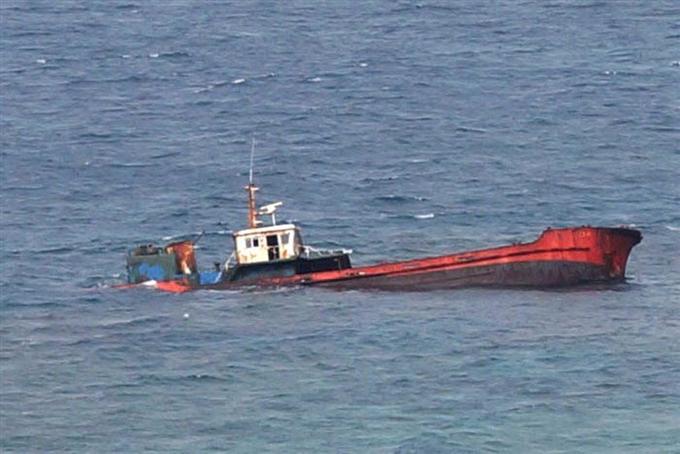
沖縄県・伊良部島(宮古島市)近海の浅瀬で、昨年1月に座礁したモンゴル船籍の小型タンカーTJ88(99トン)が船体を傾けたまま放置されている。ダイビングスポットも近いコバルトブルーの海の景観を害しており、台風などの影響で動きだせば思わぬ被害も出かねない。しかし「所有者と連絡が取れない」(海上保安庁)状態で、撤去の見通しは立っていない。TJ88はシンガポールへ航行中の昨年1月14日、強風にあおられて浅瀬に乗り上げ、ミャンマー人乗員7人のうち1人が死亡、1人が行方不明となった。海保がシンガポール在住の所有者に船体の撤去を指導したが、その後連絡が取れなくなった。海保は「継続的に電話しているが、担当者に取り次いでくれない」と漏らす。宮古島海上保安署によると、TJ88は伊良部島の北方の岩礁にはまったまま波をかぶっており、巡視船が定期的に監視。油の流出はないが、事故からしばらくたっても「船が乗り上げている」という観光客からの118番が数回あった。
<沖縄県・伊良部島近海の浅瀬に放置されているモンゴル船籍の小型タンカーTJ88>
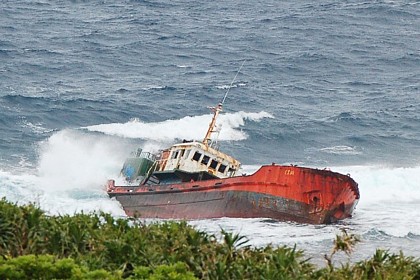
座礁したままのタンカー船=5日、 伊良部島沖
伊良部島白鳥崎沖合で昨年1月に起きた外国船籍タンカーの座礁事故で、 座礁したモンゴル船籍 「TJ88」 の船体が、 事故から1年余り経過した現在も岩礁に乗りあげたままになっている。 海上保安署や沖縄総合事務局によると、 所有者と連絡が不通になり、 撤去の目途が立っていないという。 このまま進展がなければ最終的に県が撤去することになり、 多額の負担を強いられる。 また漁業被害や観光立県としてイメージダウンも懸念される。
宮古島海上保安署によると、 昨年8月に第11管区海上保安本部がシンガポールの所有者に撤去を求めた際に、 「保険で撤去する」 意向を伝えられたというが、 それ以降、 連絡が取れない状況にあるという。
所有者が撤去しない場合、 最終的には漂着先の都道府県が費用を負担し解体することになる。 撤去にかかる費用は現場の地形や船の大きさ等にもよるが、 同船の場合は1000万円以上かかるという。
船体は岩礁に挟まった状態で固定措置などはとられていない。事故当時、船体から燃料等の流出があったが、 現在は確認されていない。
同船が座礁した現場付近は伊良部の漁師たちの漁場やダイビングスポットとなっており、 複数の関係者は「今は油の流出等の心配はないがサンゴも相当傷ついている。 漁業への被害や2次災害も心配」 と不安視し、 一日も早く撤去されることを願っていた。
また、 観光客にもマイナスのイメージを与えている。 近くには観光名所もあり、 展望台からは傾いて波にさらわれている船体が間近に見えるため、 海上保安署には、 観光客から 「船が座礁している」 との 「通報」 が月に1、 2回はあるという。 近くで農作業していた男性は 「景観を損ねており、 知らない人が見たらどれだけ不安になるだろうか。 観光地としてのイメージダウンになるので早期に撤去してほしい」 と話していた。
同船は日本から海外へ売船されたもので、 横浜からシンガポールに向けて航行中に座礁した。
Malaysian Maritime Enforcement Agency (MMEA) detained a little tanker ship on Friday December 28th, 2012 registered in Mongolia on suspicion of smuggling diesel out of Malaysia and selling it in nearby countries.
There are 4 Indonesian nationals who were arrested after 200,000 litres of diesel fuel was found to be on board the Prattahorn. Malaysian Maritime Enforcement Agency naval authorities put the value of the diesel fuel at RM3.6 m (US $1.2 m) even though it seems a very high figure.
Suspicions were aroused by соме members of the public who were witnesses of fuel transfer from road tankers to the vessel.
The vessel was detained by an MMEA patrol in Teluk Sengat, off Johor state. The tanker ship's owner hasn't been reported in the official statement and the vessel couldn't be found on the database.
By Michael Kohn (AFP)
ULAN BATOR — Inside a small office in Mongolia’s capital Ulan Bator, Banzaragchaa Altan-Od fields calls from ship captains and ports around the globe — an unusual job for someone in a landlocked nation.
The Mongolian Maritime Administration, based in a city located about 1,400 kilometres (850 miles) from the nearest ocean port, has registered more than 1,600 ships since it opened its doors in 2003.
For shipping companies, using the Mongolian flag of convenience is a good bargain, as registry fees are five to 10 percent lower than the going market rate, administration chief Altan-Od told AFP in an interview.
For the impoverished Asian country, the office is an unlikely moneymaker, raking about 350,000 dollars into state coffers a year.
“This is only the beginning of our business operations. We are going to expand our operations and focus on offering quality services,” said Altan-Od, who studied maritime law for two years in Sweden.
Shipping companies that fly Mongolia’s red, blue and yellow banner enjoy special tax breaks and reduced tariffs, the registry office says.
More than 300 ships from over 40 countries are currently on the books after others dropped off for various reasons, including failing to meet safety standards or being scrapped or sunk.
The operation is headquartered in Ulan Bator but registries are handled by the Singapore-based classification company Sovereign Ventures.
Altan-Od says his ultimate goal is to open a duty-free area in the eastern Chinese port of Tianjin — 800 kilometres from the Mongolian border.
“We are doing business with the Chinese to expand our maritime methods,” he said. “Hopefully this new port will be open by 2012.”
Such an arrangement would also allow resource-rich Mongolia to send its own exports — coal, copper and other minerals — to markets around the globe. The port would also allow Mongolia to import oil from overseas.
Mongolia's biggest shipping client so far is Japan, with 54 ships registered. Other important clients include Singapore with 42 vessels, Indonesia with 24 and Cambodia with 23. The list includes 23 oil tankers.
The country’s unusual relationship with the distant sea is nothing new.
It once had a massive navy when Kublai Khan ruled the Mongolian empire more than 700 years ago, and Marco Polo sailed from China back to Europe on a ship with the Mongolian seal.
The imperial navy came to a quick end in 1281 when a typhoon wiped out almost the entire fleet of 4,000 ships as they attempted to invade Japan. About 100,000 Mongolian soldiers perished in the storm.
It has not been all smooth sailing for the ship registry either, with two ships lost last month. In both incidents, one off the coast of India and the other in the Malacca Straits, overloading was cited as the cause.
It also is battling an image problem, with rampant allegations that Mongolia-flagged ships were involved in trafficking illegal goods, and the seizure of a ship in Malaysia in 2007, but Altan-Od refutes the claims.
“There are a lot of stories in the news saying that Mongolia is involved in smuggling. But we are not involved in any illegal acts. All our agreements specifically state that we do not tolerate smuggling on our crafts,” he said.
The ship registry is responsible for ensuring the sea worthiness of vessels and is also supposed to enforce maritime treaties to ensure they are not polluting the oceans, smuggling goods or conducting any other illegal activities.
Altan-Od notes that his office earlier this year axed its one and only North Korean ship over political and commercial concerns.
“We had one ship from North Korea but we decided to drop it. We want to avoid any political confrontations,” he said.
「Several shipping executives said they believed that North Korean ships were sailing under Mongolian and Tuvaluan flags now.」 ニューヨーク・タイムズの記事によれば北朝鮮船はモンゴル籍船や ツバル籍船 を隠れ蓑にして運航していると書いている。 PSC(外国船舶監督官) や 海上保安庁 はどのように対応しているのか。国土交通大臣はチェックする必要があると思う。
HONG KONG, Friday, Oct. 20 — When helicopter-borne Australian commandos stormed a freighter three years ago after it was spotted unloading 110 pounds of high-grade heroin, the ship proved to be registered in Tuvalu, a tiny island nation in the South Pacific.
When a Spanish warship stopped a freighter carrying cement to Yemen four years ago, the cargo vessel turned out to be carrying 15 Scud missiles as well and was registered in Cambodia.
The two freighters had something in common: although registered elsewhere, both were owned by North Korea.
The incidents illustrated North Korea’s adroit use of so-called flags of convenience to camouflage the movement of its cargo vessels as they engage in tasks that sometimes violate international laws.
The North Korean ploy could both simplify and complicate the efforts to carry out the United Nations Security Council’s resolution authorizing countries to inspect cargo entering or leaving North Korea to see if it includes illicit weapons, say shipping executives, lawyers and security experts.
The use of flags of convenience could also weaken moves like Australia’s on Monday to ban North Korean-flagged vessels from its ports to protest the nuclear test.
But if Western nations suspect that a North Korean-owned vessel flying another country’s flag is carrying illicit weapons, boarding the vessel could be simpler than if it carried North Korea’s flag, said Jonathan D. Pollack, professor of Asian and Pacific studies at the Naval War College in Newport, R.I.
A Western nation could ask the country that registered the vessel for permission to board it even if the vessel was not entering or leaving North Korean waters. Practically any country would be more cooperative about giving permission for a search than North Korea, Mr. Pollack noted.
A North Korean crew might still resist boarding, however. The crew of the Tuvalu-registered freighter, the Pong Su, did so when chased by Australian forces for four days in 2003 before it was finally boarded and captured by the commandos.
But Mr. Pollack and other experts said that flags of convenience could still prove useful to North Korea in maintaining its arms trade despite the Security Council resolution.
One possibility would be for North Korea to try to smuggle out weapons or weapons components across its land borders with China or Russia, and then to a Chinese or Russian port. The weapons could then be loaded on a vessel secretly owned by North Korea but flying another country’s flag — and perhaps not be closely watched by Western intelligence services as a result.
Or weapons could be loaded on a North Korean ship flying its own flag, and the registration of the ship could be altered after it left port. “In the middle of the night, they could change the name and change the flag,” said Gary Wolfe, a maritime lawyer at Seward & Kissel, a New York law firm.
Still another possibility, shipping and security experts said, would be for a North Korean-flagged ship to transfer cargo to a North Korean ship carrying another flag, either in port or in midocean if it were a calm day and the cargo small enough.
Changing the registration of a ship — and therefore its flag — is fairly simple. A ship owner simply sends the necessary paperwork to a country’s ship registry, along with a fee of as little as $1,000. The vessel is not required to visit the country where it is registered, or even go to port.
Ship registries do require basic information about a vessel’s length and tonnage. So if a ship of a certain size and displacement disappears from one ship’s registry and a vessel of equal size and displacement pops up with a different name on another registry at the same time, they may be the same ship and could be identified with careful sleuthing, Mr. Wolfe said.
The Pong Su sailed from North Korea to Singapore in 2003 under a North Korean flag. The vessel then switched its registration to Tuvalu and sailed on to Australia, where witnesses saw a dinghy coming ashore with what proved to be the shipment of heroin.
The freighter was seized and later used as a bombing target by the Australian armed forces as a warning to drug traffickers. The North Korean government denied that it had been involved.
Without specifically mentioning flags of convenience, Defense Secretary Donald H. Rumsfeld warned on Wednesday of the difficulty of monitoring North Korea’s trade. “There’s so much moving around the world by land, sea and air that it is practically impossible — not impossible, but certainly it would take a lot of countries cooperating with a high degree of cohesion,” and cohesion has been lacking, he said during a question-and-answer period at Maxwell-Gunter Air Force Base in Alabama.
Until 2002, North Korea tended to register its ships as Cambodian, using a registration office that the Cambodian government had authorized in Singapore. Marcus Hand, the Asia editor for Lloyd’s List, a shipping industry newspaper, said dozens of North Korean ships used to carry the Cambodian flag.
He cautioned, however, that it is often difficult to know with certainty who owns a ship, since ships are often held through various companies registered all over the world. No one outside North Korea really knows for sure how many cargo vessels the country has registered under other flags.
Cambodia canceled the right of its Singapore agents to register ships in 2002 after finding that Cambodian-registered ships were in such poor condition that ports were reluctant to let them berth, and after France accused a Cambodian-registered ship and its crew of transporting cocaine. The government of Cambodia ended up authorizing representatives in Pusan, South Korea, to manage the country’s ship registry.
Charlie Bach, the managing director of the overhauled International Ship Registry of Cambodia, said in an e-mail message that there were no longer any North Korean ships carrying the Cambodian flag.
The mystery lies in where North Korea’s ships are registered instead.
Several shipping executives said they believed that North Korean ships were sailing under Mongolian and Tuvaluan flags now.
The Tuvalu ship registry said Friday in an e-mail statement that it had been reorganized in May 2004 and had no vessels previously on North Korean or Cambodian registries.
下記はニューヨークタイムズに掲載されていた。日本が北朝鮮籍船の入港を禁止してからモンゴル籍船が増えたと書いている。
また、モンゴルは支払(お金)があれば、世界中のどこにでも行ける証書(車で言う車検証)を発行する。
PSC(外国船舶監督官)
や
海上保安庁
がどこまで問題を把握し、どれほどの情報を持っているのか知らない。
ただ、自分が見たことから判断すると、両者ともまだチェックが甘いと言う事だ。
「In 2003, Japan, traditionally an important trading partner of North Korea, adopted a policy of stringent safety and
customs checks of North Korean flag vessels visiting Japanese ports. As a result of this enforcement, the number of
port calls by North Korean flag vessels to Japan in 2003 plummeted by 29 percent, hitting 1,007. At the same time,
port calls by Mongolian flag vessels jumped in Japan. In April and May, there were 115 port calls by Mongolian flag vessels,
almost five times the 24 registered in April and May of 2003.」
「Countries "can become 'flag nations' for ships, usually by employing an agent who 'certifies' that the ships carrying
a Mongolia flag, for example, meet all the international rules," said Jim Carrier, author of "The Ship and the Storm,"
an account of the sinking of the Fantome in Hurricane Mitch, in 1998 off Honduras. Thirty-one sailors drowned with the Fantome,
a yacht flagged by Equatorial Guinea. "Shipping companies simply send a check to a country, and, in return, get the paperwork
to allow a ship with a Mongolian flag to go into any port in the world," Mr. Carrier, a trans-Atlantic sailor, said in a phone
interview. "Usually these ships avoid the tougher countries, however, and roam the world uninspected, leaking, polluting, sinking
time bombs for the sailors aboard."」
Down an avenue named after Genghis Khan, up to the third floor of a Soviet-era government ministry and down a creaking wooden hallway, its carpet frayed and faded with the dust and the sun of the steppes, one office door has a freshly minted sign: Maritime Administration. In a one-room office, with whirring computers, a fax machine at the ready and model ships for d馗or, two civil servants oversee the Mongolia Ship Registry, an international service that offers quite competitive fees and no restrictions on the ownership of any ship.
Mongolia, the world's largest landlocked country, with its capital almost 1,000 miles from an ocean beach, is the latest entry in the business of flags of convenience. With Mongolia's red, yellow and blue colors now flying on 260 ships at sea, this unlikely venture is part business, part comedy and part international intrigue. "We earned the treasury about $200,000 last year," Bazarragchaa Altan-Od, head of the Maritime Administration, said, slightly tense for his first interview with the world press. "We have 20 to 30 new registrations every month. The number is increasing."
With new international shipping security rules going into effect on July 1, some shippers may see the newest flag of convenience as one that does not yet set off alarm bells. The new rules require that ships and ports adopt verifiable, uniform security plans. Intended to prevent hijackings of large vessels for terrorist attacks, the rules are promoted by the International Maritime Organization, a United Nations body with no enforcement powers. The United States Coast Guard has said it will check compliance by boarding selected major ships approaching American ports.
Mongolian flags are not expected to become a common sight at American docks. But it was an unexpected twist of fate that brought Mongolia, a nation of nomadic herders, to the high seas.
In the 1980's, a Mongolian university student known only as Ganbaatar won a scholarship to study fish farming in the Soviet Union. But the state functionary filling out his application put down the course code as 1012, instead of 1013. As he later told Robert Stern, producer of a documentary on the Mongolian Navy, that bureaucratic error detoured him from fish farming to deep-sea fishing. Upon graduation, he was sent to work with the seven-man Mongolian Navy, which patrolled the nation's largest lake, Hovsgol. The lone ship, a tug boat, had been hauled in parts across the steppes, assembled on a beach and launched in 1938. After the collapse of Communism here in 1990, Ganbaatar wrote Mongolia's new maritime law, which took effect in 1999.
The registry opened for business in February, 2003. Perhaps to play down any negative connotations of being landlocked, the glossy color brochure of the Mongolia Ship Registry shows Mongolia surrounded on three sides by a light blue blob that, on closer inspection, turns out to be China. One clue to the international intrigue behind the registry may be in plans to reopen the North Korean Embassy here this fall.
Sovereign Ventures, a Singapore-based classification company handles the Mongolia Ship Registry, and Chong Koy Sen handles the business. "We are going quite well," Mr. Chong said in a phone interview, before asking that questions be sent by e-mail. Two e-mail messages were not answered. According to Lloyd's List, the maritime trade publication, Capt. Chong is a major shareholder in Korasia Shipping and Trading, Sovereign Ventures and the Cambodia Shipping Corporation. Founded in 1986, Korasia operates ships for North Korea and, through Sovereign Ventures, explores for oil and gas in North Korea.
The Cambodia Shipping Corporation registered foreign vessels - many of them North Korean - for Cambodia, until 2002, when the French Navy seized the Winner, a Cambodia flag cargo ship, for cocaine smuggling. The seizure, the latest in a series of mishaps for Cambodian flag vessels, prompted the Cambodian government to cancel its contract with Cambodia Shipping.
Mongolia's maritime niche may be North Korea, which has revived relations in recent months with the ruling Mongolian People's Revolutionary Party, the former Communist party here. (On June 27, after a parliamentary election campaign that included corruption accusations against the government, the opposition Motherland Democratic Coalition unexpectedly won 36 of 76 seats. A final outcome is not expected until early July.) North Korea flag vessels increasingly are watched around the world. Under the Proliferation Security Initiative, the United States and a dozen nations started to monitor North Korean vessels in 2003 for illicit cargos, like drugs, missiles or nuclear weapon fuel.
In 2003, Japan, traditionally an important trading partner of North Korea, adopted a policy of stringent safety and customs checks of North Korean flag vessels visiting Japanese ports. As a result of this enforcement, the number of port calls by North Korean flag vessels to Japan in 2003 plummeted by 29 percent, hitting 1,007. At the same time, port calls by Mongolian flag vessels jumped in Japan. In April and May, there were 115 port calls by Mongolian flag vessels, almost five times the 24 registered in April and May of 2003.
Here at the one-room office of the Maritime Administration, the cheerful tropical fish and coral calendars were not enough to break the tension caused by a question about flagging ships from North Korea. "Within international agreements, some countries have friendly relationships with Mongolia," Mr. Altan-Od said. He declined to specify where most registered vessels were from, but did note that "we have one to two American ships." With or without North Korean vessels, critics say Mongolia is registering anything that floats and can pay the fee.
Mongolia "is indicative of the larger, growing trend of the weakening of the nation state on the high seas," William Langewiesche, author of "The Outlaw Sea: A World of Freedom, Chaos, and Crime," a new book, said in a phone interview. Over the last 25 years, he said, the use of flags of convenience has grown from a small portion of the roughly 40,000 large vessels at sea "to account for a large percentage of shipping worldwide, over half."
Last Nov. 21, 13 Russian sailors were rescued from the Fest, a Mongolian-flag ship loaded with logs that was sinking in the Sea of Japan. In 20-foot high waves, the ship's main engine had failed. "That ship was 40 years old, it was too old and should not have been registered," said Damba Baigalmaa, deputy director of Mongolia's Maritime Administration, noting Mongolia's policy of not registering ships over 30 years old.
Also in November, Irish police boarded the MV Unique, a Mongolian-flag vessel that had been moving around the high seas of Europe for one month without apparent destination or cargo. Although an international police task force suspected that the ship was involved in moving illegal immigrants into Britain, Irish detectives did not find evidence of wrongdoing. On Dec. 9, the Indonesian Navy seized the Mongolian-flagged MV Bravery Falcon for not having any documentation to prove that its load of 17,000 cubic meters of tropical hardwood had been legally logged. "Unfortunately, there were a few Mongolian-flag ships that sank," the prime minister of Mongolia, Nambaryn Enkhbayar, said when asked about the incidents. "We have to improve, so this becomes a good company for us," he said, referring to the ship registry.
The Mongolian Sea-Lovers Association, a civic group that gathers mainly to discuss maritime policy, dreams of the day when Mongolia will have its own merchant marine, tying up at a Mongolian-owned duty-free zone at Tianjin, China, about 500 miles by rail from Mongolia's southeast border. Critics say that safety is the victim of an international shipping system that leaves enforcement of international rules to the countries that register vessels and to the ports where they drop anchor.
Countries "can become 'flag nations' for ships, usually by employing an agent who 'certifies' that the ships carrying a Mongolia flag, for example, meet all the international rules," said Jim Carrier, author of "The Ship and the Storm," an account of the sinking of the Fantome in Hurricane Mitch, in 1998 off Honduras. Thirty-one sailors drowned with the Fantome, a yacht flagged by Equatorial Guinea. "Shipping companies simply send a check to a country, and, in return, get the paperwork to allow a ship with a Mongolian flag to go into any port in the world," Mr. Carrier, a trans-Atlantic sailor, said in a phone interview. "Usually these ships avoid the tougher countries, however, and roam the world uninspected, leaking, polluting, sinking time bombs for the sailors aboard."
Mr. Langewiesche, whose "Outlaw Sea" came out in the spring, cautioned, "It is important not to draw a mechanical linkage between dangerous ships and this flag." "Given the range of flags available, those interested in Mongolia are not interested in maintaining ships, in sailing well," he said. "But to say that Mongolians should not have ships flying their flag is also unfair."
MONGOLIA.NEWEURASIA.NET(2006年5月3日)より
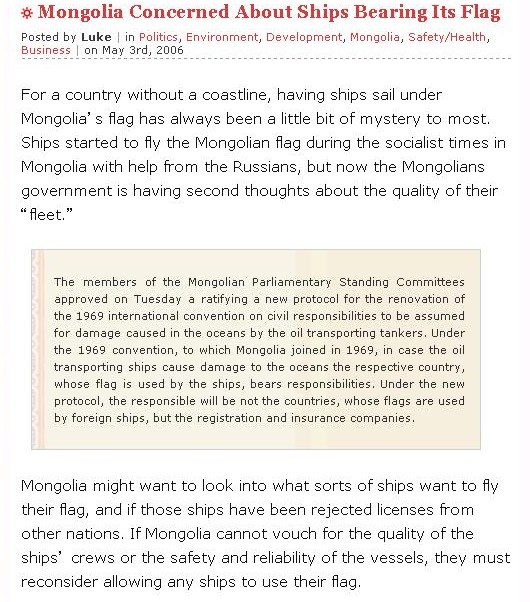
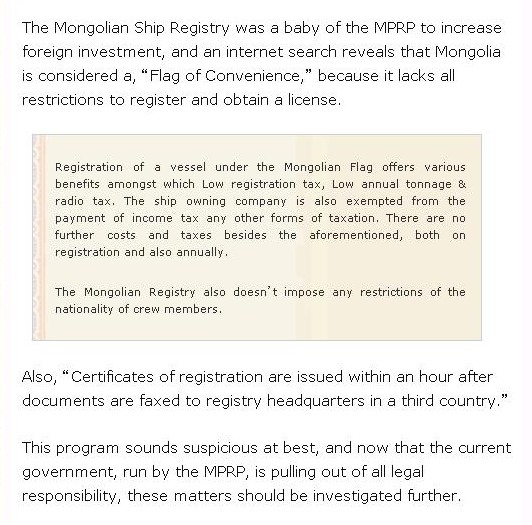
For a country without a coastline, having ships sail under Mongolia’s flag has always been a little bit of mystery to most. Ships started to fly the Mongolian flag during the socialist times in Mongolia with help from the Russians, but now the Mongolians government is having second thoughts about the quality of their “fleet.”
The members of the Mongolian Parliamentary Standing Committees approved on Tuesday a ratifying a new protocol for the renovation of the 1969 international convention on civil responsibilities to be assumed for damage caused in the oceans by the oil transporting tankers. Under the 1969 convention, to which Mongolia joined in 1969, in case the oil transporting ships cause damage to the oceans the respective country, whose flag is used by the ships, bears responsibilities. Under the new protocol, the responsible will be not the countries, whose flags are used by foreign ships, but the registration and insurance companies.
Mongolia might want to look into what sorts of ships want to fly their flag, and if those ships have been rejected licenses from other nations. If Mongolia cannot vouch for the quality of the ships’ crews or the safety and reliability of the vessels, they must reconsider allowing any ships to use their flag.
The Mongolian Ship Registry was a baby of the MPRP to increase foreign investment, and an internet search reveals that Mongolia is considered a, “Flag of Convenience,” because it lacks all restrictions to register and obtain a license.
Registration of a vessel under the Mongolian Flag offers various benefits amongst which Low registration tax, Low annual tonnage & radio tax. The ship owning company is also exempted from the payment of income tax any other forms of taxation. There are no further costs and taxes besides the aforementioned, both on registration and also annually.
The Mongolian Registry also doesn’t impose any restrictions of the nationality of crew members.
Also, “Certificates of registration are issued within an hour after documents are faxed to registry headquarters in a third country.”
This program sounds suspicious at best, and now that the current government, run by the MPRP, is pulling out of all legal responsibility, these matters should be investigated further.
海のないモンゴルで、海洋ビジネスが盛んになっている。国外の船主に国籍を貸し「モンゴル船籍」にして、その手数料や賃貸料を徴収するというものだ。このところ、テロの危機回避などで各国が外国船の船籍を厳しくチェックする動きが強まっており、検査をかいくぐるために「モンゴル船籍」を取得する船が増えてきた。これに伴い、モンゴル船籍の北朝鮮船が日本に寄港するケースが昨年の5倍以上に増えている。
米紙「ニューヨーク・タイムズ」がウランバートル発で伝えたところによると、モンゴル政府では、昨年2月に船籍貸しを行う国家海洋局を開局した。とたんに問い合わせが殺到。「毎月20-30件の艦船がモンゴル船として登録されており、昨年は20万ドル(約2200万円)以上の収入があった」(同局)という繁盛ぶりだ。いまだに登録の申し出は引きも切らない。
「海と嵐」の著者で海洋問題に詳しいジム・キャリアー氏は、「テロの危機を回避するため、国際海洋安全法が今月1日に改正され、米国などに寄港する場合、これまで以上に船籍が厳しく審査されることになった」と背景を説明する。
同局によると、モンゴル船籍を最も多く取得したのは「カンボジア・シッピング・コーポレーション」という会社だ。フランス海軍は2002年に同社の貨物船から多量のコカインを押収している。このコカインの取引には、北朝鮮が絡んでいたと伝えられる。同社が所有するカンボジア船籍の艦船は北朝鮮船であることも知られている。
この事件の後、同社のカンボジア船籍の艦船に対する検査が厳しくなった。このため、モンゴル船籍に変えたのではないかとみられている。
北朝鮮船もモンゴル船籍に変えているケースが目立つ。北朝鮮船は麻薬売買にかかわっているケースもあり、国際的に警戒されているためだ。
日本の港湾に寄港する北朝鮮船は昨年、検査が厳しくなったこともあり、前年比29%も減少したという。これに変わって増えたのが、モンゴル船籍をもつ艦船だ。
昨年4、5月の2カ月間で、日本の港湾に寄港したモンゴル船は24隻しかなかったが、今年4、5月の2カ月間では約5倍の115隻も寄港している。
The Business times online editionの Shipping Timesには下記のような記事が載っていた。
Registry based in S'pore with half-a-dozen ships
The Mongolia Ship Registry Pte Ltd, which was registered in Singapore just over a year ago, became operational last week with half a dozen vessels registered and 20 applications pending, according to its deputy registrar, Capt Johnathan Foong.
The company is targetting between half to one million gross tonnes of ships under flag by the year-end, although Capt Foong says it is emphasising quality over quantity.
When asked why such a substantially land-locked country like Mongolia would want to venture into the world of international shipping, Capt Foong said: 'It doesn't matter (that the country is land-locked), because it is given the right by the United Nations to fly the Mongolia flag and transit international waters, so why not Mongolia?
'And now with a democratic process and capitalism in Mongolia this is one way of encouraging foreign exchange earnings,' he added.
But when probed as to whether the Mongolian registry was set to sail the dubious flags of convenience waters reviled by many for their notorious harbouring of substandard vessels and shady business operations, he was unequivocal.
'We are not a fly-by-night company or flag of convenience which are all out to make money,' he said. 'We are a very strict regime because this ship registry is run directly by the government.
'We assess all ships before admitting them into the registry because we are very fussy on the kinds of ships we allow in. We check the background of the ships, their condition, age, past survey records, port detention rates and also the owner is very important because we don't want any terrorist or drug smuggler,' Capt Foong said.
He also noted the company has agreements with major classification societies like the American Bureau of Shipping, Bureau Veritas, Germanischer Lloyd, Det Norske Veritas and Lloyd's Register of Shipping, among others, to survey and issue statutory certificates to Mongolian flagged vessels.
The registry's existence came to light when an e-mail was sent to clients of the now disgraced Cambodian registry after the Cambodian government announced it was cancelling the contract of the Singapore-based Cambodian Shipping Corporation (CSC) Pte Ltd.
This move came about after the Cambodian-flagged cargo ship Winner was seized by the French Navy last year for alleged cocaine smuggling.
In the e-mail CSC's executive director Ng Eng Choon said: 'To assist all our loyal and supportive owners in avoiding detentions due to invalid ship's documents, we recommend owners to consider transferring their vessels to the Mongolia Registry.'
While Capt Foong says there is no direct connection between the Cambodian and Mongolian registers, he said he had done some consultancy work for the Cambodian registry prior to joining Mongolia, but insisted the two registries are independent of each other.
While he said the company is a joint venture between the Mongolian government and an unspecified Singapore businessman, Registry of Companies data shows no Mongolian directors or officers in the company.
Published March 12, 2003
したそうである。
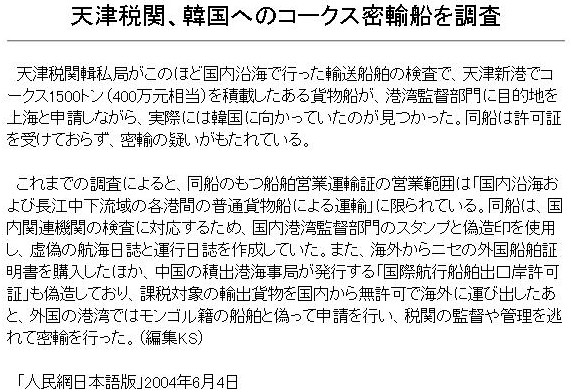
天津税関輯私局がこのほど国内沿海で行った輸送船舶の検査で、天津新港でコークス1500トン(400万元相当)を積載したある貨物船が、港湾監督部門に目的地を上海と申請しながら、実際には韓国に向かっていたのが見つかった。同船は許可証を受けておらず、密輸の疑いがもたれている。
これまでの調査によると、同船のもつ船舶営業運輸証の営業範囲は「国内沿海および長江中下流域の各港間の普通貨物船による運輸」に限られている。同船は、国内関連機関の検査に対応するため、国内港湾監督部門のスタンプと偽造印を使用し、虚偽の航海日誌と運行日誌を作成していた。また、海外からニセの外国船舶証明書を購入したほか、中国の積出港海事局が発行する「国際航行船舶出口岸許可証」も偽造しており、課税対象の輸出貨物を国内から無許可で海外に運び出したあと、外国の港湾ではモンゴル籍の船舶と偽って申請を行い、税関の監督や管理を逃れて密輸を行った。(編集KS)
モンゴル籍船舶が出港停止命令を日本で頻繁に受けている。英語がわかる人は 上記の記事と現実との隔たりがあるとがわかるだろう。日本はカンボジア籍 の時と同じように野放しにするのだろうか。徹底的に検査を行い、国際条約を 満足しない状態で入出港を許可しないか、見守っていくしかないだろう。
欠陥船根絶で監査制度試行 日本の提唱受けIMO (共同通信)の記事を 読むと「国際条約の専門家や船舶検査官らを各国が派遣して監査チームを 結成し、海上人命安全条約や海洋汚染防止条約などに適合した国内法を 整備し、人員や設備などの十分な体制を取っているかを調べる。」と書かれて いる。人員や設備などの体制をチェックするよりも、問題のあるフラッグ (旗国)に登録されている船舶をどのように検査しているのか、検査報告書 と船舶の現状の違いについてどのような対応をしているのか。問題のある 検査会社に対する処分や制裁等を行っているかを確認するほうが良いであろう。 一般的に問題がある旗国でも規則等はあるのである。問題は、規則の厳守を 怠っているから問題なのである。また、問題を知っていながら放置している 旗国もある。また、PSCの能力のばらつきにより、 サブスタンダード船 が問題を放置したまま入港を繰り返している場合もあるのである。
故意に問題を見逃している検査会社もあり、実際にこのような検査会社を 取締まらなければならない。現状は、野放し状態である。
また、日本周辺を航行する多くの サブスタンダード船 の多くが、 元日本国籍 で日本から輸出された事実にも注目しなければならないだろう。監査制度 を提唱するぐらいだから、これらの問題にも取組むと推測する。今後の活動 に注目したい。モンゴル籍の例のように、言っていることとやっている事が 全く違う場合もあるのである。効果を上げるにはどのようにすべきか考えて ほしい。今後の 日本のPSC の活動に反映されることを祈るのみである。 多くのカンボジアやモンゴル籍船舶は問題を抱えたまま日本に入港している。 PSCは検査を行う時は、気まぐれで検査せずに、徹底的に検査してほしい。 船主、荷主、港湾関係者の圧力に負けずに、PSCの誇りを持ってUSコーストガード のように 日本のPSC は他のアジアのPSCとは違うと知られるようになってもらいたい。 日本のPSCの活動に期待したい。
第六光洋丸 改め‥ 2011 Jan. (素人造船(株)船舶模型課)
つい先日、私のこんなブログを拝見して下さっているというある美人Yお姉さんから写真が届きました
外売されていく自動車船です。
第六光洋丸 花房汽船 1,227GT/998DW 日本海運 阪神内燃機工業 6EL32 今村造船所呉 1990.08
20歳を超えていますがまだまだキレイそうです
いったい、日本で今までどれだけの数の車両を積んだんでしょうか。
「INDIGIRKA」と船名も変更されています。
売船され、ロシア船主で、船籍はモンゴル、運航地域はマレーシアで、これから釜山で修理して延命するそうです。
内売なら見かけることもあるかもしれませんが、外売となると船主さんも最後の雄姿を見ながらどう感じるんでしょうかね。。
美人Yお姉さん、今度本船が某所を通過する際は近くまで出てきて手を振ってくれるそうです
ちなみに、うちのかみさんはそんな事はしてくれません
朝青龍よ。モンゴル籍船を何とかしろ!
違法な船(サブスタンダード船)
を登録しなくても心配ないようにモンゴルにお金を投資してくれ。
朝青龍よ。サブスタンダードなモンゴル籍船の撲滅運動をやってくれ!高感度アップ、間違いなし!
モンゴル籍船の現状を理解してください。
朝青龍:モンゴル大統領が助言「もっと日本を勉強せよ」 08/23/07(毎日新聞)
モンゴルのエンフバヤル大統領は23日、日本相撲協会から2場所連続出場停止処分を受け、その後「解離性障害」と診断された横綱・朝青龍に対し「もっと日本の伝統、文化を勉強して真の意味で強い横綱になり、日本人の多くの人に愛されてほしい」と助言した。
ウランバートル訪問中の日本財団の笹川陽平会長に語った。大統領は「日本とモンゴルのスポーツ交流はもっと盛んになっていく。モンゴルでは、体力は一つの力でしかないが、知力を得ればより多くの力を身につけることができるといわれる」と付け加え、朝青龍にさらに精進するよう求めた。
大統領は21日「心の悩みがあるならば、ふるさとに帰って休むのも一つの手だ。帰ってくるならいつでも迎え入れる」と朝青龍の帰国を歓迎する意向も示していた。【鈴木玲子】
昨日行なわれましたアメリカ国務省のディリー・ブリーフィングでは、内陸国であるモンゴルとアメリカが便宜置籍船協定を結んだことに対しまして、質疑応答がなされておりました。記者側が、なぜ内陸国のモンゴルと協定を結ぶのか、とズバッと質問したことに対して、国務省のマコーリー報道官は言葉を濁しながらも、テロリストや北朝鮮などにより核兵器関連物資や大量破壊兵器関連資材の輸送に利用されないために臨検(クワランティン)を行なう権利をアメリカが行使できるようにするためである、と言外に示唆を致しました(解釈されております)。
日本の約900隻に及ぶ便宜置籍船。日本政府は早急に海上保安庁ならびに海上自衛隊による臨検の行使権の確保を置籍船国と締結するべきではないでしょうか。日本の海の安全のために、日本の国土の安全のために、責任ある193カ国の主権国家の一国と致しまして。
「モンゴル船籍」取得増加 テロ、麻薬密売船の“抜け道”懸念
海のないモンゴルで、海洋ビジネスが盛んになっている。国外の船主に国籍を貸し「モンゴル船籍」にして、その手数料や賃貸料を徴収するというものだ。このところ、テロの危機回避などで各国が外国船の船籍を厳しくチェックする動きが強まっており、検査をかいくぐるために「モンゴル船籍」を取得する船が増えてきた。これに伴い、モンゴル船籍の北朝鮮船が日本に寄港するケースが昨年の5倍以上に増えている。
米紙「ニューヨーク・タイムズ」がウランバートル発で伝えたところによると、モンゴル政府では、昨年2月に船籍貸しを行う国家海洋局を開局した。とたんに問い合わせが殺到。「毎月20-30件の艦船がモンゴル船として登録されており、昨年は20万ドル(約2200万円)以上の収入があった」(同局)という繁盛ぶりだ。いまだに登録の申し出は引きも切らない。
「海と嵐」の著者で海洋問題に詳しいジム・キャリアー氏は、「テロの危機を回避するため、国際海洋安全法が今月1日に改正され、米国などに寄港する場合、これまで以上に船籍が厳しく審査されることになった」と背景を説明する。
同局によると、モンゴル船籍を最も多く取得したのは「カンボジア・シッピング・コーポレーション」という会社だ。フランス海軍は2002年に同社の貨物船から多量のコカインを押収している。このコカインの取引には、北朝鮮が絡んでいたと伝えられる。同社が所有するカンボジア船籍の艦船は北朝鮮船であることも知られている。
この事件の後、同社のカンボジア船籍の艦船に対する検査が厳しくなった。このため、モンゴル船籍に変えたのではないかとみられている。
北朝鮮船もモンゴル船籍に変えているケースが目立つ。北朝鮮船は麻薬売買にかかわっているケースもあり、国際的に警戒されているためだ。
日本の港湾に寄港する北朝鮮船は昨年、検査が厳しくなったこともあり、前年比29%も減少したという。これに変わって増えたのが、モンゴル船籍をもつ艦船だ。
昨年4、5月の2カ月間で、日本の港湾に寄港したモンゴル船は24隻しかなかったが、今年4、5月の2カ月間では約5倍の115隻も寄港している。
思った以上にモンゴル籍船が増えているようだ!日本トン数で400トン以上だからAISが付いていると思うが消息不明。
第七管区海上保安部と長崎のPSC (外国船舶監督官)は甘いと言う事か?
信頼性はないが、新しい船名
MV Starlite Jupiter 08/28/2013 (Flickr)で動いているらしい。国籍は不明。ファンネルマークはそのまま使われているようだ。
断定できないがフィリピンの
「STARLITE FERRIES, INCORPORATED」
が新しい所有者のようだ。未だにデータが日本籍になっているのでしっかりした会社ではないのだろう。
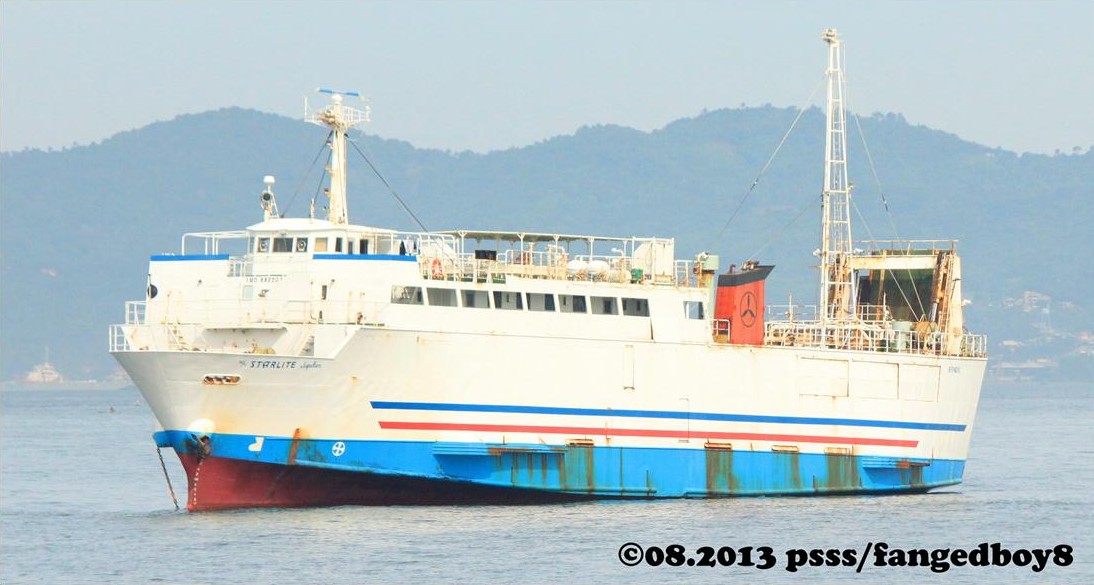 |
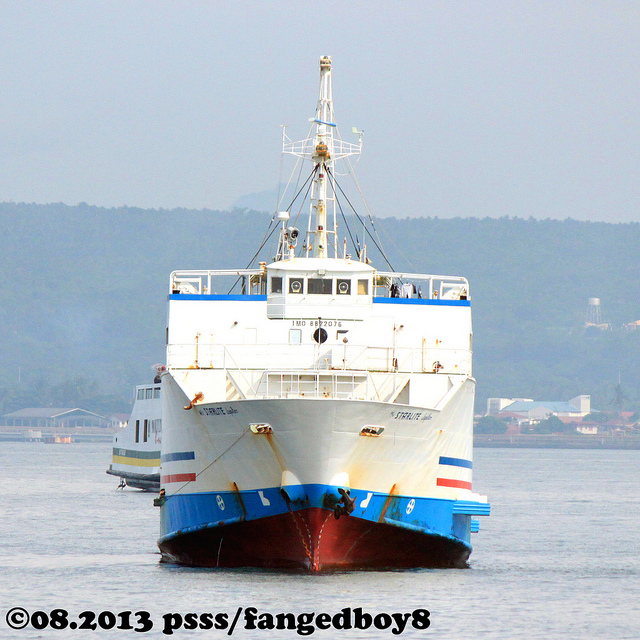 |
|---|
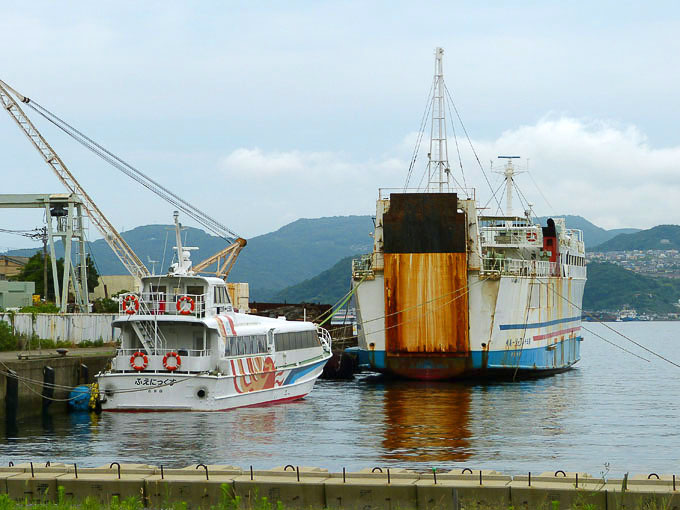
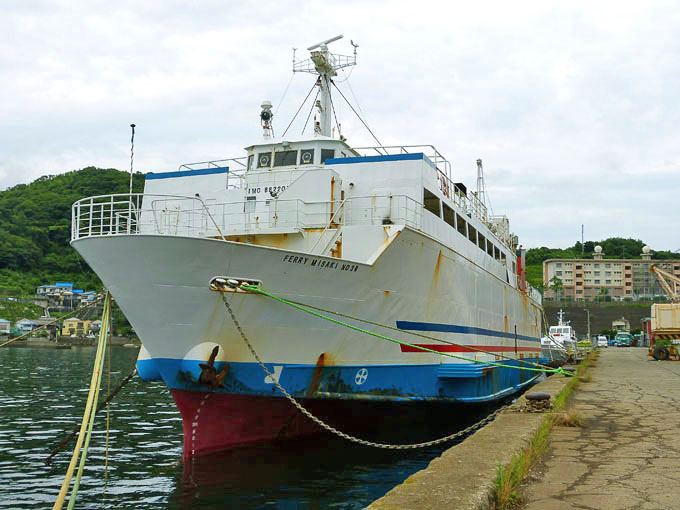
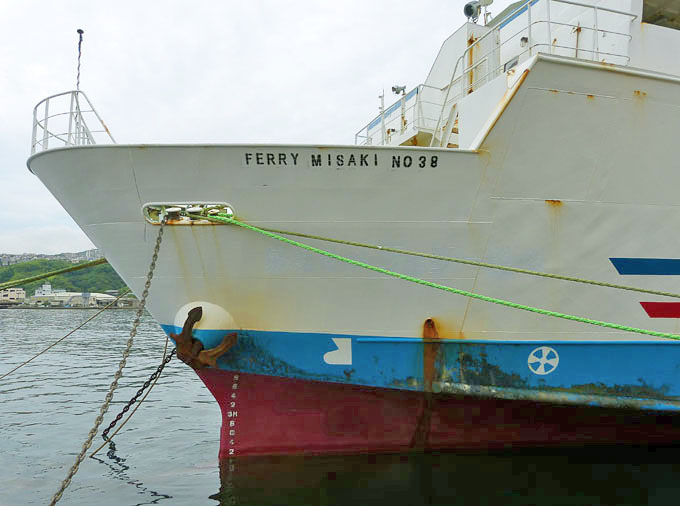
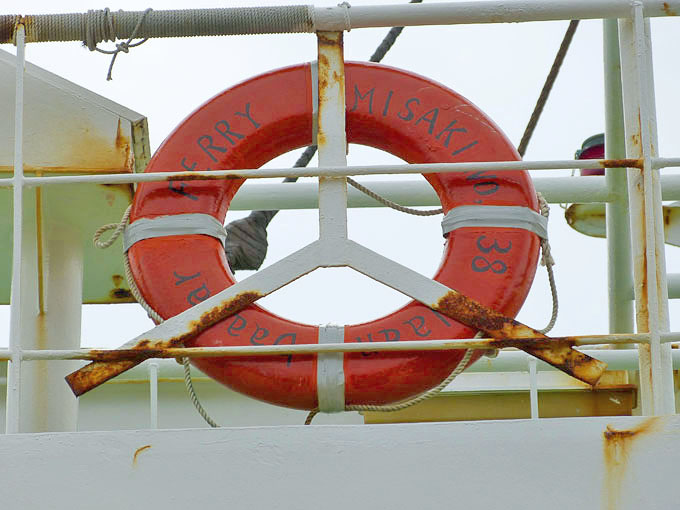
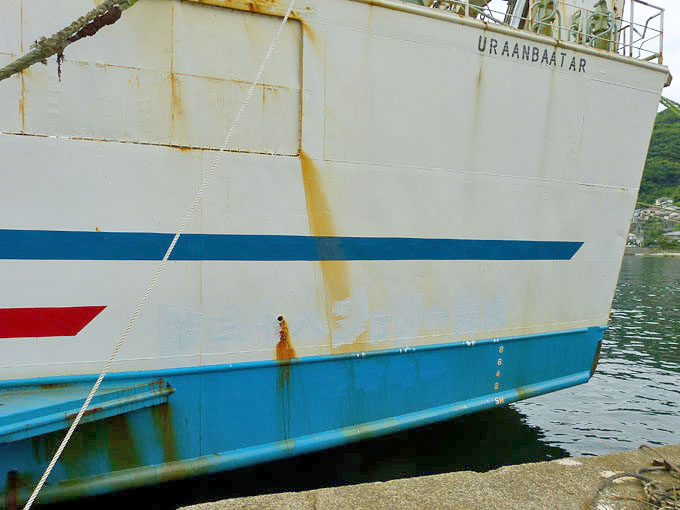
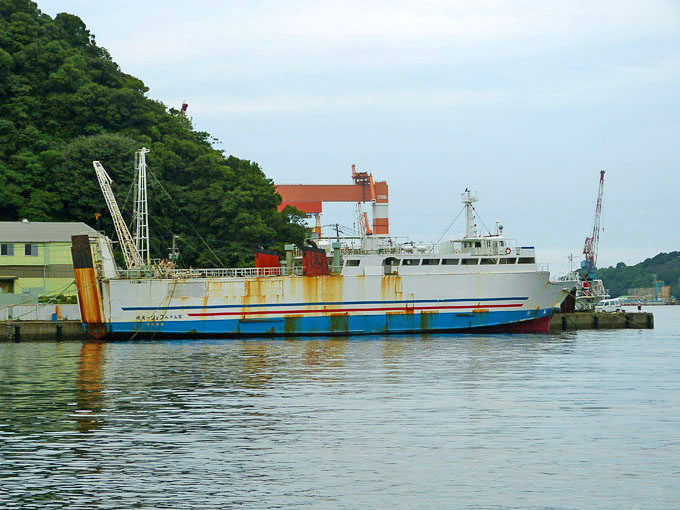
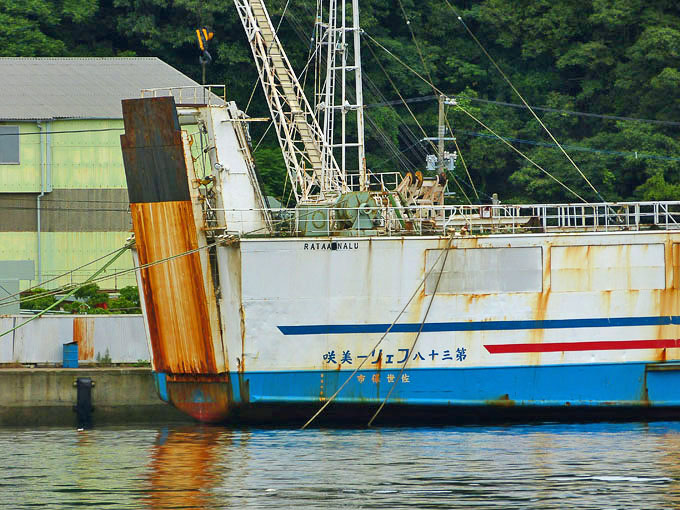
モンゴル籍船になる前の「第三十八フェリー美咲」
「第三十八フェリー美咲」長崎へ 06/06/2013 (長崎遠めがね)
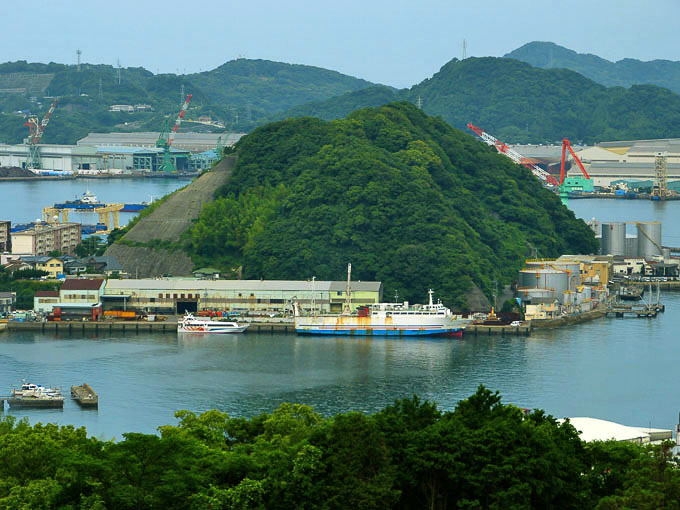
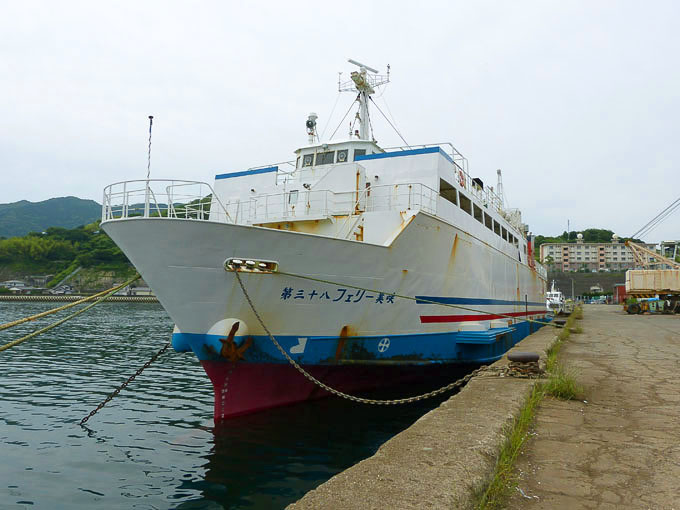
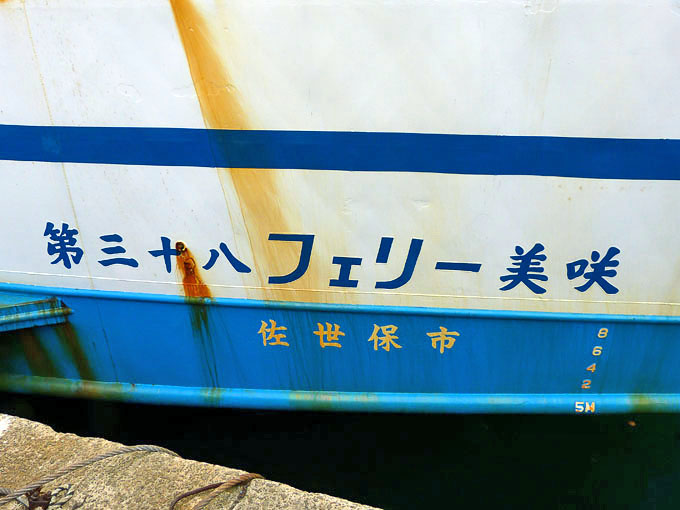
|
| |
|---|---|
| Ship Name: | FERRY MISAKI NO.38 |
| Type of Ship: | RO-RO CARGO |
| Flag: | JAPAN (Mongolia?) |
| IMO: | 8822076 |
| Gross Tonnage (ITC): | 441 tons |
| DWT: | 216 tons |
| Year of Built: | 1989 |
| Builder: | HONDA HEAVY INDUSTRIES - SAIKI, JAPAN |
| Manager & Owner: | OISHI KAIUN - HIRADO, JAPAN (Unknown?) |
UNDER-PERFORMING SHIPS (1年間に3回以上出港停止を受けた船舶) TOKYO MOUのHPより のリストに載っている船舶がモンゴル船籍に登録されて日本に入港しました。千葉でPSCによる検査 を受け出港停止命令を受けました。モンゴル船籍のタンカー「TJ88」の座礁事故を考えれば検査をするのは当たり前。出港停止命令を受けてもおかしくない 状態だったと考えられます。船齢及びモンゴル船籍である事実から推測して、ホールド、ホールドの隔壁そしてハッチカバーの状態はひどいと推測できます。 検査を行う前にこれぐらいの推測はPSC (外国船舶監督官)に出来たのかは疑問ですが、経験の積み重ねで推測 は出来ると思います。まれに外れる事もあると思いますが、サブスタンダード船は期待を裏切らないほど問題です。
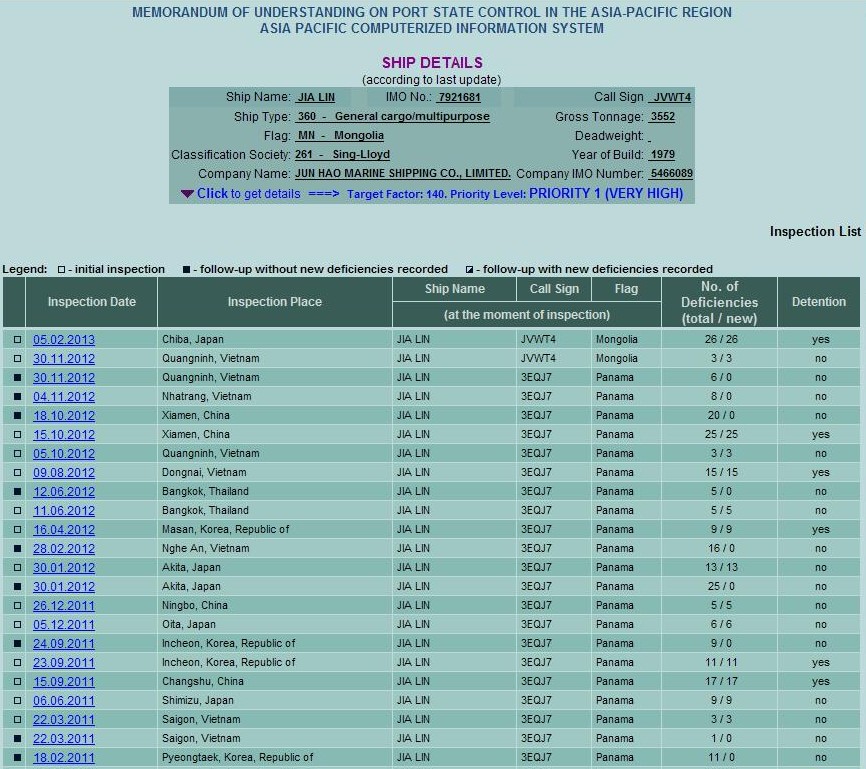

TOKYO MOU
|
| |
|---|---|
| Ship Name: | JIA LIN |
| Type of Ship: | General Cargo |
| IMO: | 7921681 |
| MMSI: | 7921681 |
| Year of Built: | 1980 |
| Builder: | Setouchi Shipbuilding Osakikamijima, Japan |
| Gross Tonnage (ITC): | 3,552 tons |
| Class Society: | International Register Of Shipping |
| Former name: |
- Wei Chi (Until 2009 Jun)
- Silver Arrow (Until 2008 Mar) - Hokusei Maru (Until 1999 Sep) |

TJ99 IMO 8960579 Mongolia Flag(TOKYO MOU)が出港停止命令を受けた。
指摘された不備は下記のとおりである。
02107 - STRUCTURAL CONDITIONS - Ballast, fuel and other tanks (no responsibility of RO)
03104 - WATER/WEATHERTIGHT CONDITIONS - Cargo & other hatchways (no responsibility of RO)
17101 - OTHER - Other safety in general (no responsibility of RO)
02103 - STRUCTURAL CONDITIONS - Stability/strength/loading information and instruments (no responsibility of RO)
02116 - STRUCTURAL CONDITIONS - Bulkheads - cracking (no responsibility of RO)
国籍、船名、船のタイプを考えると「 伊良部島白鳥崎から東約2200㍍の浅瀬で座礁したシンガポールの会社が所有するタンカー「TJ88」(99㌧、ウランバートル船籍)」と共通点がある。「TJ88」を所有するシンガポールの会社又は関係者ではないのか?もしそうだとすると学習能力のないブラック企業であるに違いない。真実はこの船に出港停止命令を出したPSC (外国船舶監督官)及び関係者しか知らないだろう。
(no responsibility of RO)と書かれているが、検査会社により検査されてからあまり日数が経っていない場合、検査会社の責任になるのではないのか?
Criteria for Attribution of RO Responsibility (TOKYO MOU) によれば下記のとおりである。
2.The RO responsibility is assessed only relating to detainable deficiencies that are:
i.covered by a statutory certificate that has been issued or endorsed by the RO with a date of survey; and
ii.the RO has carried out the last survey or verification audit for the relevant certificate(s).
3.A detainable deficiency is associated with the RO if it is:
i.serious structural deficiency including corrosion, wastage, cracking and buckling unless it is clear that the deficiency has occurred since the last survey conducted by the RO; or
ii.a serious deficiency in equipment or non-structural fittings (such as fire main, air pipes, cargo hatches, rails, masts etc.) AND it is less than
90 days since the last survey conducted by the RO, unless it is clear that the deficiency has occurred since the last survey conducted by the RO; or
iii.a serious deficiency in equipment or non-structural fittings which clearly would have existed at the time of the last survey; or
iv.a serious deficiency associated with out-of-date equipment which was out-of-date at the time of the last survey; or
v.a major non-conformity where there is clear evidence of a lack of effective and systematic implementation of a requirement of the ISM Code AND there is clear evidence that it existed at the last audit conducted by the RO. It may also include operational drills and operational control and there is clear supporting evidence of failure.
4.A detainable deficiency is not associated with the RO if it is:
i.he result of accidental or voyage damage;
ii.missing equipment that is likely to have been stolen except when it is a large quantity and the PSC inspection is taking place within 90 days since the last survey conducted by the RO; or
iii.an expired certificate unless the certificate was improperly issued by the RO following a survey conducted on behalf of the flag State.
この船、既に油津港(宮崎県ポートセールス協議会)から出港しているのか知らないが、PSC (外国船舶監督官)は出港前に厳しく検査するべきだ。
IMO 8960579で検索するとDAITO MARU NO.5 (EX-AKEBONO MARU NO.3)であるらしい。
モンゴル船籍のタンカー「TJ88」の座礁でモンゴル籍タンカーを検索すると思った以上に日本周辺にうろうろしているようです。
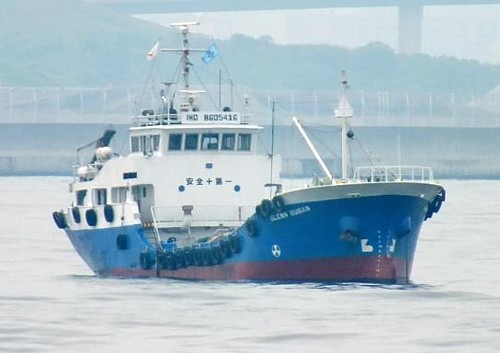
GLENN BUSAN (EX-shoei maru, Built: 1986, JG 138ton) 東京湾に出現 2012-6-2(だんだんのぶらり散策Ⅱ)
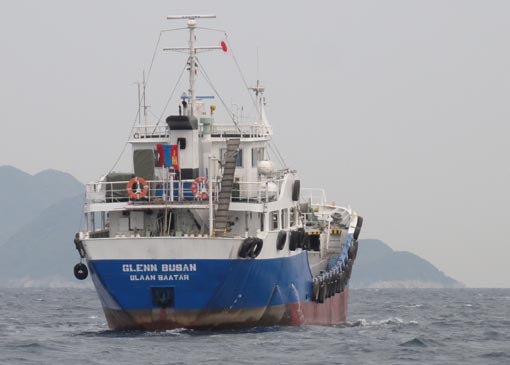
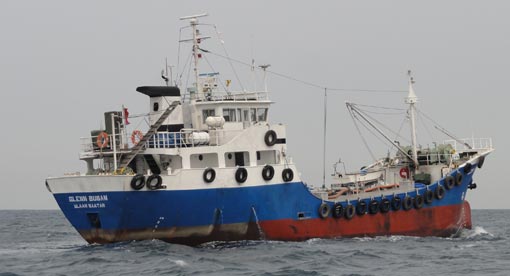 |
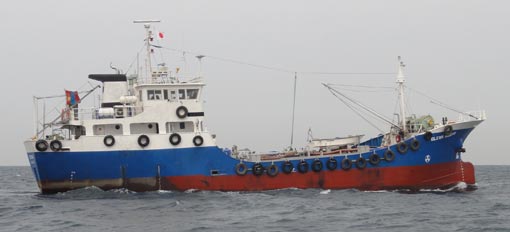 |
|---|---|
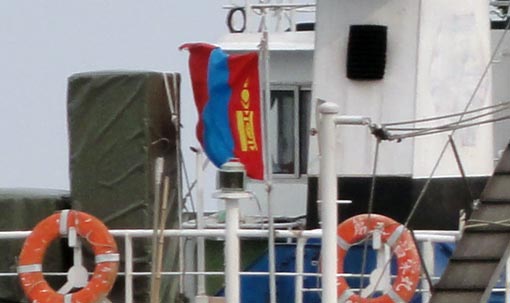 |
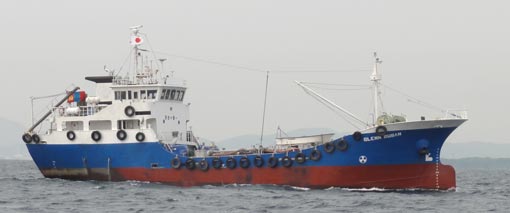 |
GLENN BUSAN (EX-昌栄丸) 関門海峡通過 2012-05-13(川の一日)
油が漏れているなら救助された船員から船主の連絡先を聞いて連絡先を取るべきだ。船長が行方不明で船主情報が分からないとしたら、タンカーが出港した港を聞いて、
船舶代理店から情報を得れば良いだけの事。難しい事ではない。
船主が見つからなければ座礁し放置船された船となるのでしょうか?
宮古島市伊良部島周辺の浅瀬にタンカーが乗りあげ、1人が死亡、1人が行方不明になっている事故で、座礁したタンカーから油が流出していることが16日にわかりました。
この事故では伊良部島白鳥崎の沖合2.2キロの浅瀬でモンゴル船籍のタンカーが座礁し、乗組員のミャンマー人7人のうち1人が死亡、1人が行方不明となっています。
宮古島海上保安署によりますと16日午前10時半ごろ、座礁したタンカー付近の海域で長さおよそ150メートル、幅50メートルにわたり油が浮いているのを海上保安本部の航空機が確認。現場海域が悪天候のため、油の回収や座礁したタンカーの撤去作業は現在も行われていません。
また、タンカー内には燃料の重油15キロリットルが残されているということで、海上保安本部では天候の状況を見ながら作業を進めるということです。
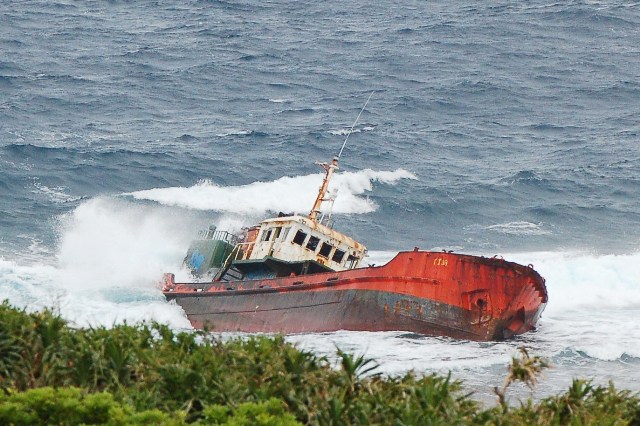
座礁したままのタンカー船=5日、 伊良部島沖
伊良部島白鳥崎沖合で昨年1月に起きた外国船籍タンカーの座礁事故で、 座礁したモンゴル船籍 「TJ88」 の船体が、 事故から1年余り経過した現在も岩礁に乗りあげたままになっている。 海上保安署や沖縄総合事務局によると、 所有者と連絡が不通になり、 撤去の目途が立っていないという。 このまま進展がなければ最終的に県が撤去することになり、 多額の負担を強いられる。 また漁業被害や観光立県としてイメージダウンも懸念される。
宮古島海上保安署によると、 昨年8月に第11管区海上保安本部がシンガポールの所有者に撤去を求めた際に、 「保険で撤去する」 意向を伝えられたというが、 それ以降、 連絡が取れない状況にあるという。
所有者が撤去しない場合、 最終的には漂着先の都道府県が費用を負担し解体することになる。 撤去にかかる費用は現場の地形や船の大きさ等にもよるが、 同船の場合は1000万円以上かかるという。
船体は岩礁に挟まった状態で固定措置などはとられていない。事故当時、船体から燃料等の流出があったが、 現在は確認されていない。
同船が座礁した現場付近は伊良部の漁師たちの漁場やダイビングスポットとなっており、 複数の関係者は「今は油の流出等の心配はないがサンゴも相当傷ついている。 漁業への被害や2次災害も心配」 と不安視し、 一日も早く撤去されることを願っていた。
また、 観光客にもマイナスのイメージを与えている。 近くには観光名所もあり、 展望台からは傾いて波にさらわれている船体が間近に見えるため、 海上保安署には、 観光客から 「船が座礁している」 との 「通報」 が月に1、 2回はあるという。 近くで農作業していた男性は 「景観を損ねており、 知らない人が見たらどれだけ不安になるだろうか。 観光地としてのイメージダウンになるので早期に撤去してほしい」 と話していた。
同船は日本から海外へ売船されたもので、 横浜からシンガポールに向けて航行中に座礁した。
ほぼ100%、内航小型タンカーが外売されて モンゴル籍に登録されて外地へ向かっている途中での座礁!
沖縄・伊良部島沖でモンゴル船籍タンカー座礁 1人死亡、1人不明 01/15/13(沖縄テレビ)
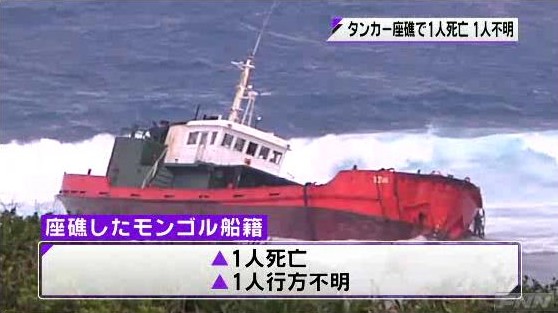
14日午前0時55分ごろ、沖縄県・伊良部島(宮古島市)の浅瀬に座礁したと、モンゴル船籍のタンカー「TJ88」(99トン)から118番があった。同船のミャンマー人乗組員7人中5人は救助されたが、海上保安庁の航空機が正午前、伊良部島の佐良浜漁港近くを漂流している男性1人を発見、その後、死亡が確認された。船長(46)とみられる男性1人が行方不明となっている。
宮古島海上保安署によると、助かった5人のうち4人は船近くの岩場で救出され、1人は自力で島北端の白鳥崎に到達した。
現場近くは13日夜から15メートル前後の強風が吹き、大しけの状態。船員の話によると、島の近くでいかりを下ろして停泊していたが、強風で船が流されたという。現場では同船からの油の流出も確認されている。
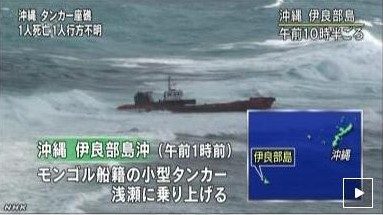
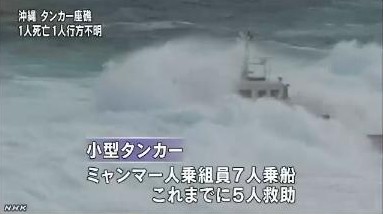
沖縄県の伊良部島の沖合で、モンゴル船籍の7人乗りの小型タンカーが強風で流されて浅瀬に乗り上げ、乗組員5人が救助されましたが、1人が死亡、1人が行方不明になっています。
14日午前1時前、伊良部島の白鳥崎から東に2200メートルの沖合で、モンゴル船籍の小型タンカー(99トン)が浅瀬に乗り上げたと、乗組員から那覇市の第11管区海上保安本部に通報がありました。
タンカーにはミャンマー人の乗組員7人が乗っていて、石垣海上保安部などによりますと、これまでに5人を救助しましたが、正午ごろに海上で漂流しているのが見つかった1人は、死亡が確認されたということです。
また、46歳の船長の行方が依然として分かっておらず、海上保安部などが、航空機と巡視艇で捜索を続けています。
当時、現場の海域は、風速18メートルの強い風が吹き、波の高さも5メートルと「しけ」の状態だったということです。
救助された乗組員は「いかりをおろして船を停泊させていたところ、強風で流されて座礁した」と話しているということで、海上保安部などは乗組員からさらに話を聞くなどして当時の状況を調べています。
14日午前0時55分頃、モンゴル船籍の小型タンカー「TJ88」(99トン)から、沖縄県宮古島市の伊良部島の東2・2キロの沖合で浅瀬に座礁したと第11管区海上保安本部(那覇市)に連絡が入り、航空機や巡視艇が出動した。
宮古島海上保安署によると、ミャンマー人乗組員7人のうち、機関長の男性(60)が同島東側の漁港沖で見つかり、死亡が確認された。船長の男性(46)は行方不明となっている。残る5人のうち、4人は同島北側の岩場で救助され、1人は自力で島に泳ぎ着いた。
現場海域は当時、風速18メートル、波高4メートル以上で、強風波浪注意報が出ていた。
座礁船 7 カ月ぶりに撤去 02/07/11 (広報ながしま) ◆開けない人はここをクリック
今年の2月7日に、城川内の海岸に座礁していたモンゴル船籍の台船の撤去作業が、9月3日から5日にかけて行われ、約400 ㌧ある船体は4 等分に切断されました。
約7 カ月間海に沈んでいたことから、土砂などが多く堆積していたほか台風によるしけのため作業に時間がかかりましたが、予定されていた日程で船体をクレーン船で引き上げ、指江港に海上輸送しました。
城川内の海岸と指江港では地元の住民らが集まり、作業状況を見守りました。
見物に訪れた漁師の男性は「無事撤去が終わり落ち着いた。風光明媚な長島の海岸に戻ったことがうれしい」と、撤去を喜びました。
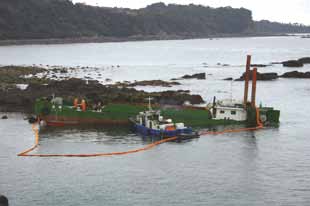
2月7日、城川内集落の堂崎の南約150 ㍍の浅瀬に、モンゴル船籍の台船「天てんゆう 祐」1190 ㌧が座礁しました。この台船は、熊本県八代港から中国に向かっていましたが、6日の深夜の荒天で、 台船を押していた船から「つないでいたワイヤが切れた」と第十管区海上保安本部に通報がありま した。幸いけが人はなく、撤去するよう保険会社と交渉中とのことです。
モンゴルだけでなく、下記の問題も 欠陥船(サブスタンダード船) の排除のためには解決されなければならない。
確認は書類でのみ確認:
船籍国と船級協会 合田 浩之 (一般財団法人 山縣記念財団)
掃除をしていてThe Asahi Shinbun Globe January 15 - February4, 2012を見つけ、「日本海運支える『愛媛船主』生き残りかけた正念場に」を読んだ。
 ★ベリーズ籍船
以前はかなり悪くなったが、カンボジア籍船にかなりひどい
サブスタンダード船が移り改善していた。しかし、カンボジア籍船がマーケットから隠れ蓑として消えたので、サブスタンダード船の
隠れ蓑としてランクアップ中。
★ベリーズ籍船
以前はかなり悪くなったが、カンボジア籍船にかなりひどい
サブスタンダード船が移り改善していた。しかし、カンボジア籍船がマーケットから隠れ蓑として消えたので、サブスタンダード船の
隠れ蓑としてランクアップ中。
 ★カンボジア籍船
:以前はホンジュラスやベリーズが有名でした。現在は、質の悪い船/登録されている隻数
では世界で一番だと思います。
★カンボジア籍船
:以前はホンジュラスやベリーズが有名でした。現在は、質の悪い船/登録されている隻数
では世界で一番だと思います。
 ★モンゴル籍船
:カンボジアの後に出来ました。以前、カンボジア船を登録した会社が登録業をしている。
★モンゴル籍船
:カンボジアの後に出来ました。以前、カンボジア船を登録した会社が登録業をしている。
 ★ツバル籍船
:日本で問題と見られている国籍では、一番新しい。以前、カンボジア船を登録した会社が
登録業をしている。
★ツバル籍船
:日本で問題と見られている国籍では、一番新しい。以前、カンボジア船を登録した会社が
登録業をしている。
![]() ★グルジア籍船
:日本で出港停止命令を受けた船舶が増えた。ツバル籍船の次になるのか。
★グルジア籍船
:日本で出港停止命令を受けた船舶が増えた。ツバル籍船の次になるのか。
連絡先の情報については、
AMSA(オーストラリア)のHPを参考にしてください。
 ★シエラレオネ籍船: 北九州で大量の麻薬が見つかり、船主は行方不明になり船が放置された事件に認知度がアップ。また、東京・伊豆大島沖で2013年9月、丸仲海運が所有する貨物船「第18栄福丸」が中国企業所有のシエラレオネ籍船貨物船「JIA HUI」と衝突し、栄福丸の乗組員六人が死亡した事故でさらに注目を集める。
★シエラレオネ籍船: 北九州で大量の麻薬が見つかり、船主は行方不明になり船が放置された事件に認知度がアップ。また、東京・伊豆大島沖で2013年9月、丸仲海運が所有する貨物船「第18栄福丸」が中国企業所有のシエラレオネ籍船貨物船「JIA HUI」と衝突し、栄福丸の乗組員六人が死亡した事故でさらに注目を集める。
![]() ★トーゴ籍船:日本ではまだ少ない。
★トーゴ籍船:日本ではまだ少ない。
![]() ★パラオ籍船:日本でも見られるようになった。
★パラオ籍船:日本でも見られるようになった。
関連記事のリンク集
国連機関、欠陥船根絶へ出張監査 日本提唱で攻め姿勢へ (朝日新聞)
欠陥船根絶で監査制度試行 日本の提唱受けIMO (共同通信)
国土交通省のHPからです。日本国籍の船舶の登録について書いてあります。参考にしてください。
|
◆サブスタンダード船
◆サブ・スタンダード船と旗国の関係 ◆なぜ、サブ・スタンダード船? ◆サブスタンダード船の見つけ方 ◆サブスタンダード船の写真 ◆検査会社の問題 |
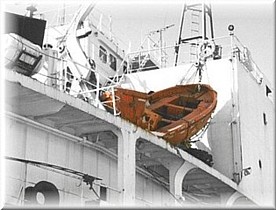 ★HOME |
◆海運関連業界
◆なぜ、サブ・スタンダード船? ◆BLUE OCEAN(ブルーオーシャン)の事故 ◆座礁船及び放置船 ◆PSCによる検査の現状 ◆船舶油濁損害賠償保障法 |
|---|
リンク先の中には繋がらないものもあると思いますが、ご容赦ください。






